

What To See At London’s Westminster Abbey, The Complete Guide
Westminster Abbey is a iconic landmark that’s an absolute must visit attraction in London. It’s the most historic church in the English-speaking world.
Founded by Edward the Confessor, the abbey is a shrine of the British nation and a UNESCO-listed site. The complex has been an abbey, a cathedral, a coronation church, and a royal mausoleum.
This spectacular medieval “royal peculiar” has hosted every coronation from William the Conqueror to Elizabeth II and 16 royal weddings. It’s also the burial place of many royals and notables, including feuding Tudor siblings Elizabeth I and Mary.
This Westminster Abbey guide gives you a mini overview of the abbey’s 1,000 year history and tells you everything to see inside. I also give you must know tips for visiting.
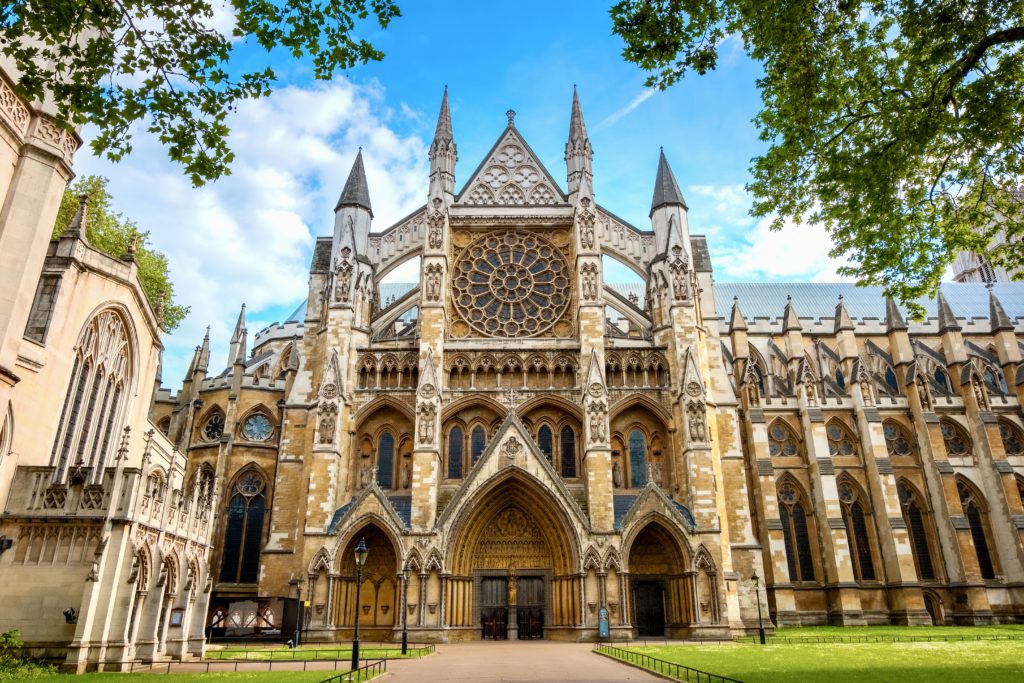
Here’s a snapshot glance of what you can see at Westminster Abbey on a visit:
- statesmen aisle
- shrine of Edward the Confessor
- royal tombs
- Henry VIII’s Lady Chapel
- poets corner
- diamond jubilee galleries
- chapter house
- pyx chamber
- coronation throne
You definitely need to pre-book a skip the line ticket in advance to visit the abbey. The lines will be long in high season.
The abbey is also free with the London Pass . But the pass doesn’t give you skip the line access to the abbey.
You may want to book a 2 hour guided tour of the abbey .
This tour gives you a combined tour of the abbey and the Houses of Parliament . This tour offers a 4 hour Westminster walking tour and abbey tour .
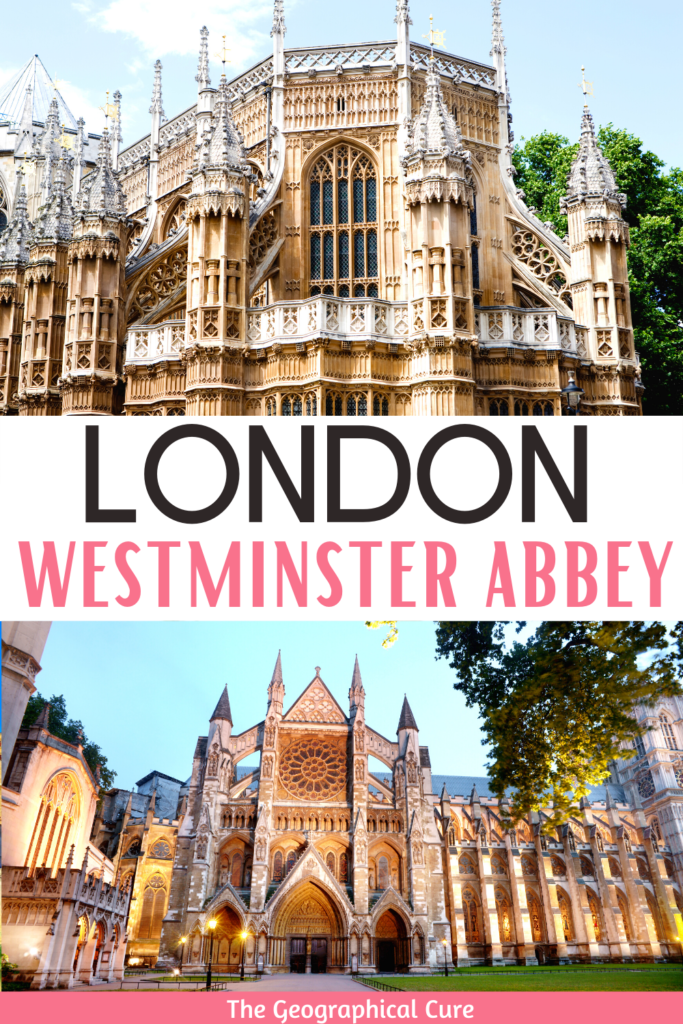
Mini History of Westminster Abbey
Westminster Abbey has been a place of worship for over 1,000 years. The abbey isn’t a cathedral. It’s techinically a “royal peculiar” – a place of worship that falls under the monarch’s jurisdiction and doesn’t belong to a diocese.
The abbey has the status of a collegiate church. Its official name is the Collegiate Church of Westminster.
In 906, St. Dunstan, the Bishop of England, brought monks from Glastonbury to found a monastery at Westminster. Over 100 years later, in 1042, King Edward the Confessor founded a church on the site.
It was consecrated in 1065. Edward died a few days later.
After his death, Edward’s reputation as a holy and pious man grew. People came to the shrine in pilgrimage, praying for healing.
In 1161, Edward was officially made a saint. Henry III decided to build him a shrine in a more glorious Gothic church.
Construction of Westminster Abbey began in 1245 and continued for a couple centuries. In 1503, Henry VII began to build a new lady chapel, which stands at the far eastern end of the abbey.
In the 16th century, the infamous Henry VIII had fallen out with the pope, who refused to give him an annulment so he could marry Anne Boleyn.
In 1540, Henry VIII broke from the church and launched his own Anglican religion. He dissolved the monasteries and seized their assets to continue funding his castle building ways.
But Henry VIII did, at least, grant the Westminster Abbey cathedral status, thereby sparing it from the looting and destruction other monasteries suffered.
In 1533, Queen Mary took over the crown from her father Henry VIII. As a devout Catholic, she changed the abbey’s status back to a monastery.
Five years later, her sister Queen Elizabeth I came to the throne and reversed Mary’s orders. The abbey became a collegiate church.
Architecturally, the next major milestone didn’t come in 1745. This is when the two west towers were built according to the design of a Christopher Wren pupil. In the Victorian era, the triple portico was built and the rose window redesigned.
In 1995, the exterior stonework was cleaned and restored. In 1998, new statues were added to the Great West Door, including ten 20th century martyrs. You can even see Martin Luther King Jr.
In 2018, the Queen’s Jubilee Galleries were opened in the Triforum. The galleries display the abbey treasures and offer great views down over the nave.
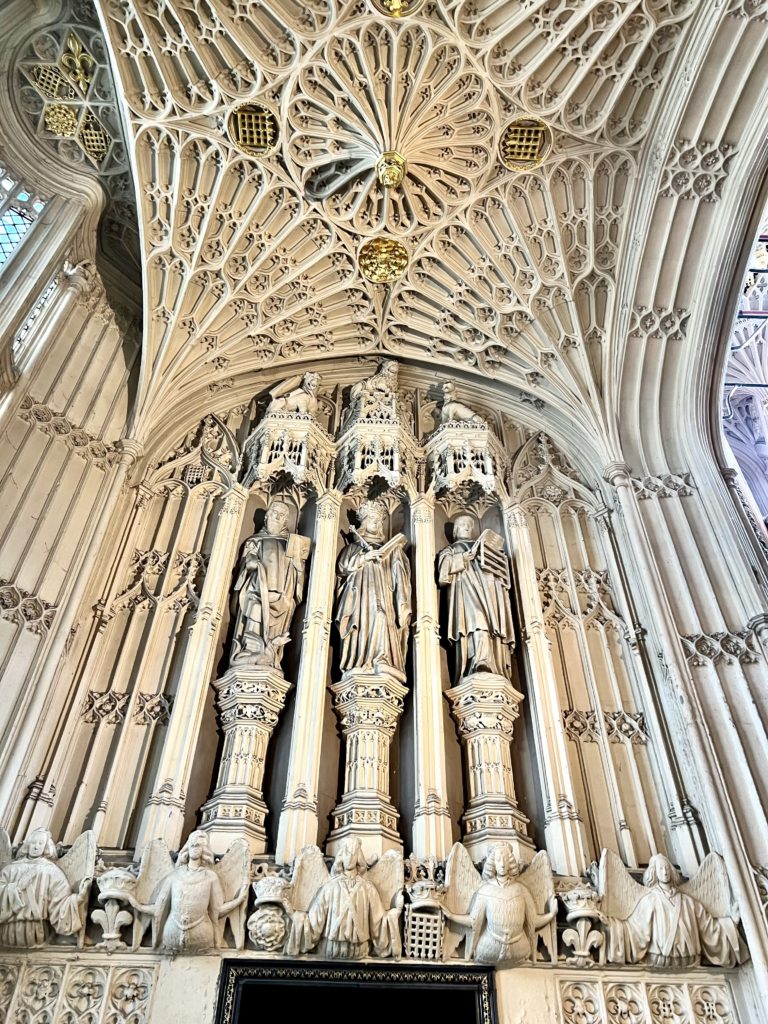
The Coronation Church
39 monarchs have been crowned in Westminster Abbey, beginning with England’s first king William the Conqueror.
In fact, Henry III specifically built the abbey as a coronation church. The long transepts allow plenty of seating for the glitterati.
The coronation ceremony follows a procedure that’s largely unchanged over time. The monarch is presented to the people by the Archbishop of Canterbury. Shouts of “God save the King or Queen” ring out from the grandstands.
The monarch signs an oath to govern properly. While sitting in the Coronation Chair, he or she is anointed with holy oil, given the symbols of monarchy, and crowned. Finally, the monarch is moved to the throne where he or she receives the homage of the subjects.
Elizabeth II’s coronation was the first one shown on live TV.
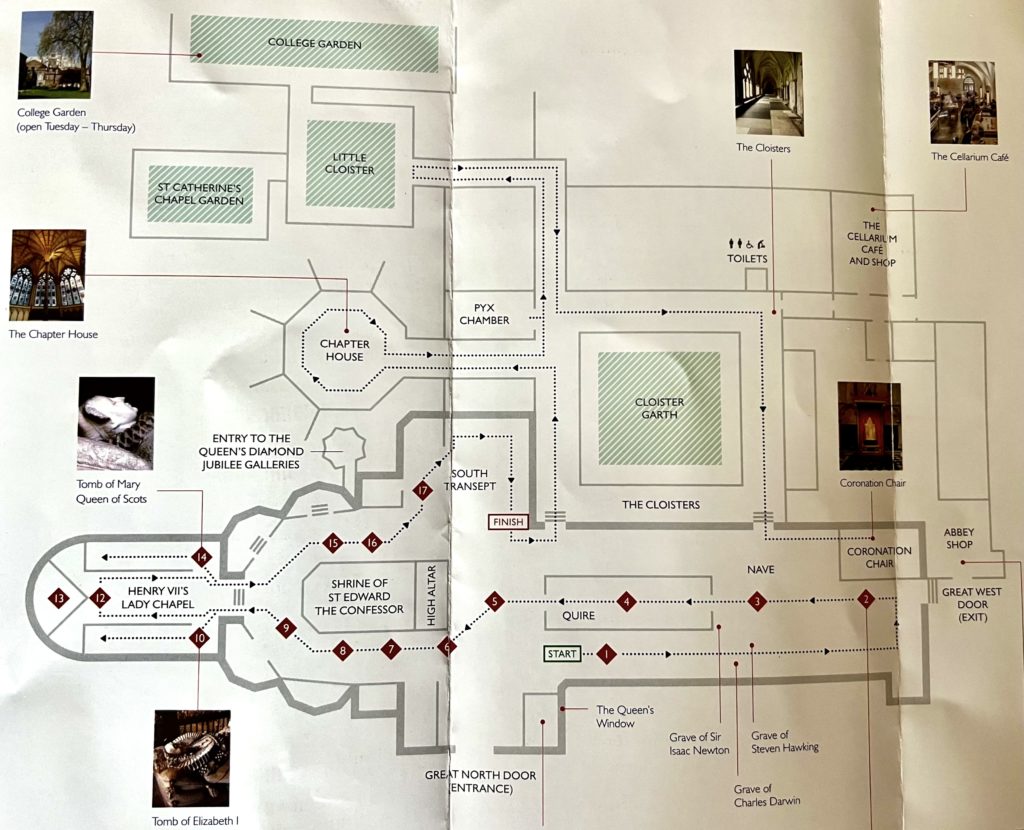
Guide To Westminster Abbey: What To See
Here are the must see highlights of the interior of the Abbey.
I’ve described them roughly in the order you’ll encounter them if you follow the trail on the map above.
1. Entrance
You enter the abbey via the door at the north transept. Your first impression is of a soaring vaulted space.
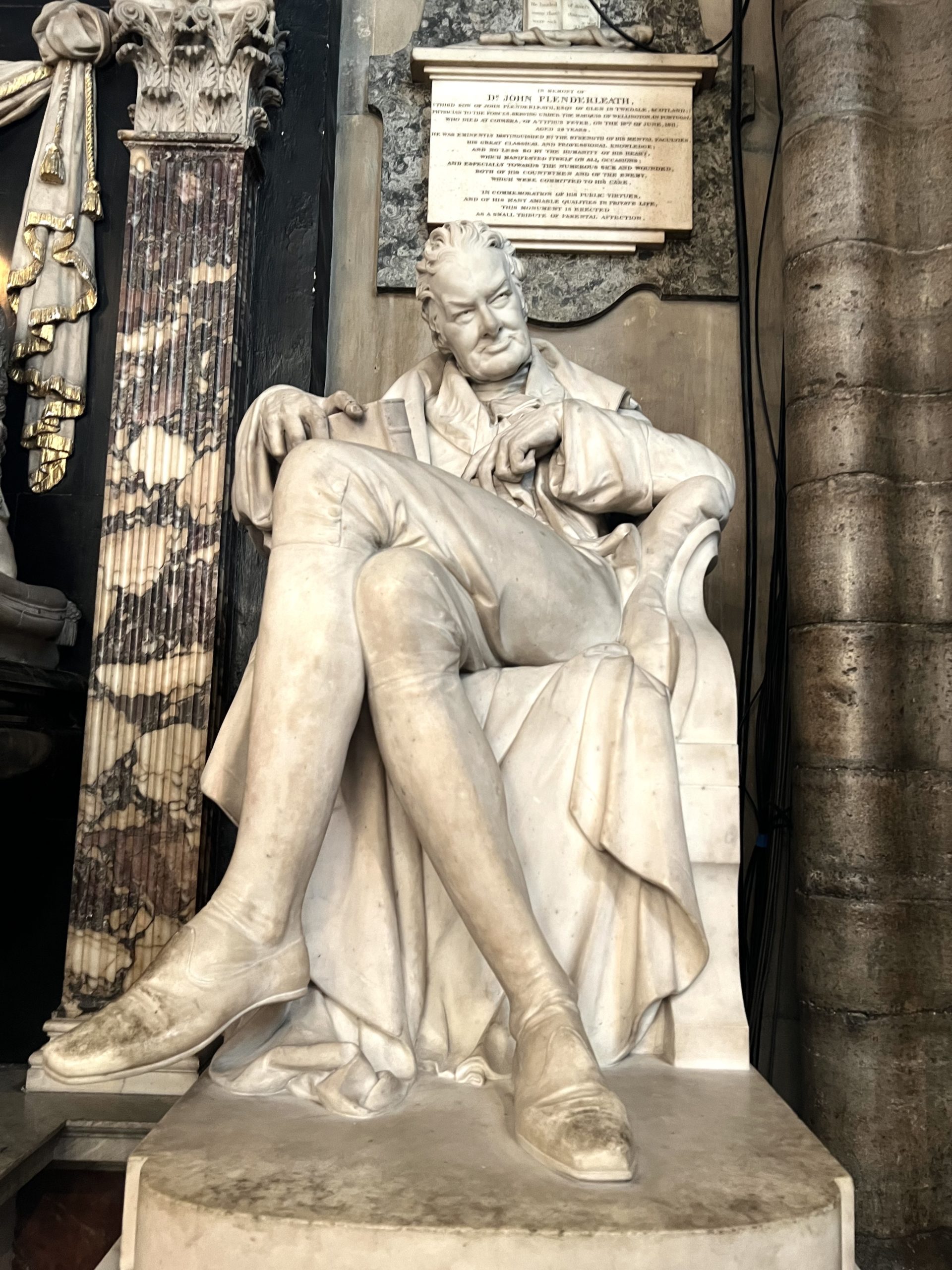
The history starts the second you walk in the door. You’ll see important figures from British history in the “Statesmen Aisle.”
There are larger than life statues honoring the leading Prime Ministers from the 18th and 19th centuries, including Viscount Patterson, Robert Peel, and Benjamin Disraeli.
The tableaux suggests a strong link between the abbey and the British government.
The largest memorial in this area is dedicated to Prime Minister William Pitt. He is buried nearby with his son William Pitt the Younger. There is a plaque honoring the younger near the west door.
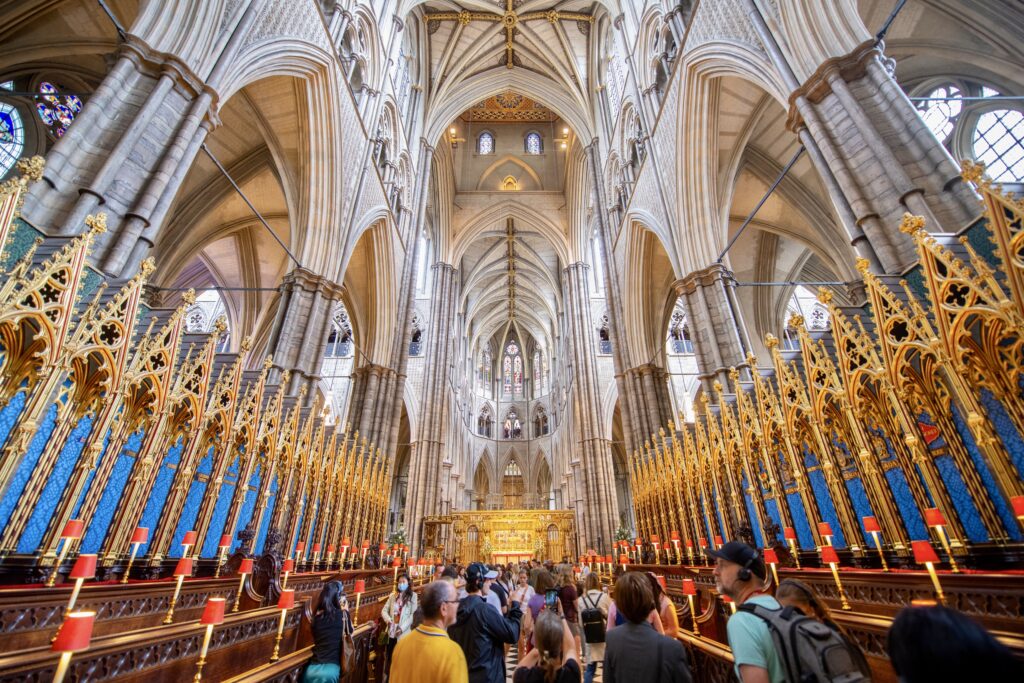
The nave is the central part of the church intended to hold the congregation. The abbey’s is a classic English nave.
Like other parts of the cathedral, it also honors important men and women.
Set against the west facade facing the nave is the magnificent monument to Sir Issac Newton. He was a great British philosopher, scientist, and mathematician.
The sculpture reflects Newton’s interests. It features optical and mathematical instruments, books, and a globe showing the signs of the zodiac and constellations. Newton is buried just in front of the monument.
The naturalist and biologist Charles Darwin is buried nearby. In the center of the nave in the west end is a green marble stone commemorating Sir Winston Churchill.
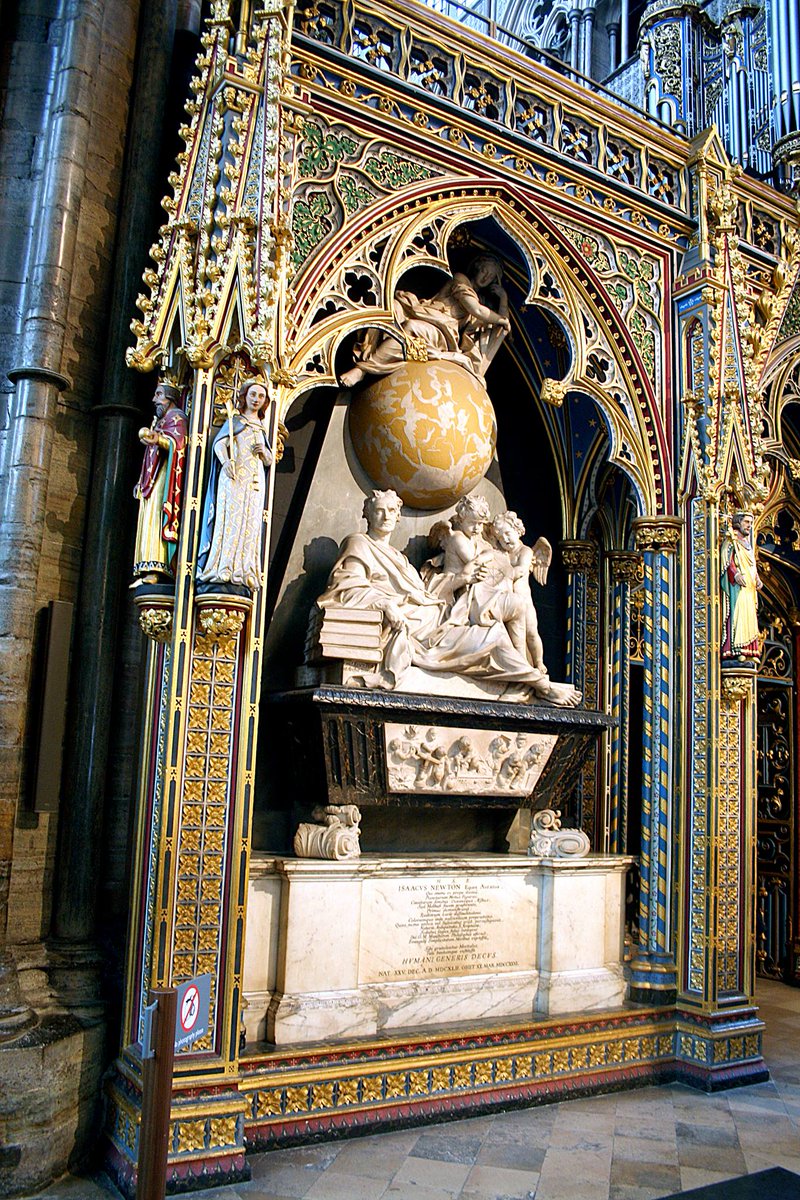
The most famous grave in the abbey that of the Unknown Soldier. It’s surrounded by a border of red poppies. I love that an unknown British soldier should be buried among the kings and queens.
The abbey’s world renowned quire is an intimate space. It’s effectively a church within a church.
The quire is divided from the nave by a elaborate screen designed by Edward Blore in 1834. It was gilded in the 1960s.
The quire was where the monks worshipped. Although not in these stalls, which date from the Victorian era. Today, the choir is occupied by eight regular choral services each work.
4. High Altar
The present High Altar dates from 1867. It was designed by George Gilbert Scott.
In front of the altar is one of the abbey’s most precious possessions, the medieval Cosmati Pavement. It was laid down in 1268 on the order of Henry III.
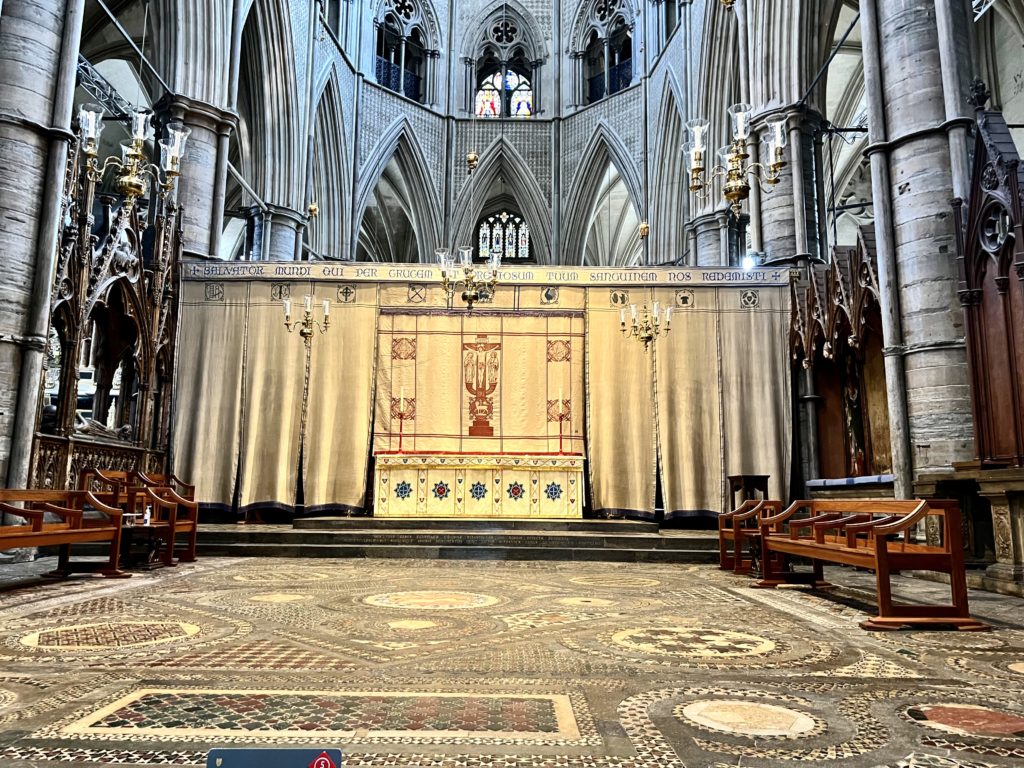
The tiles are made up of more than 80,000 pieces of onyx, porphyry, and glass set into Purbeck marble. The pavement was cleaned and restored before the wedding of William and Kate.
5. Shrine of Edward The Confessor
The Chapel of St. Edward is the spiritual heart of the abbey. It was here that the first pope visited the abbey.
Edward the Confessor’s remains were moved, or “translated,” many times before landing here. It was said that they were responsible for miracles.
The shrine was the work of Henry III, Edward’s biggest fan. He encrusted it with gold and jewels so that it shone like a beacon in then candlelit church.
Today, the shrine is hidden from view behind grills. You can only get a good look at it on a verger tour. (More on those below in the tips section.)
As he wanted, Henry III’s tomb is right nearby in a Purbeck marble tomb. It’s beautifully decorated with mosaics. Henry’s effigy is supposed to be a real likeness.
6. Henry VII’s Lady Chapel
The most beautiful part of Westminster Abbey is the stunning Henry VII Chapel in the eastern end.
The ancient chapel is the last great masterpiece of English medieval architecture, the crowning glory of the abbey, and the mausoleum for much of England’s royalty.
After its debut, the chapel was grandiosely nicknamed a “wonder of the world.”
The chapel is the work of England’s first Tudor monarch, Henry VII. He was the king who vanquished the York king, Richard III , in the Battle of Bosworth and seized control of England.
The chapel was dedicated to the Blessed Virgin Mary in 1503. It’s known as the Henry VII Chapel, although technically its name is the Lady Chapel.
The chapel’s architect is unknown. But historians believe that Robert Janyns, Jr. is the design genius.
Built between 1503-16, Henry VII broke the bank for his new chapel. It’s essentially an ornate homage to and keepsake of the Tudor dynasty. The whole chapel has the festive air of a medieval pageant.
Although built during the Renaissance period, Gothic architecture was still in vogue at the time. So, the chapel was built in the Perpendicular Gothic style .
This style is more ornate than French Gothic and uses highly decorative tracery effects. The chapel contrasts with the plainer Gothic style of the rest of the abbey.
The chapel’s most striking feature is its ornate high vaulted vaulted ceiling. The column piers splay out into a fan shape.
There’s elaborate highly decorative tracery everywhere. It obscures the structural system and hanging carved pendants.
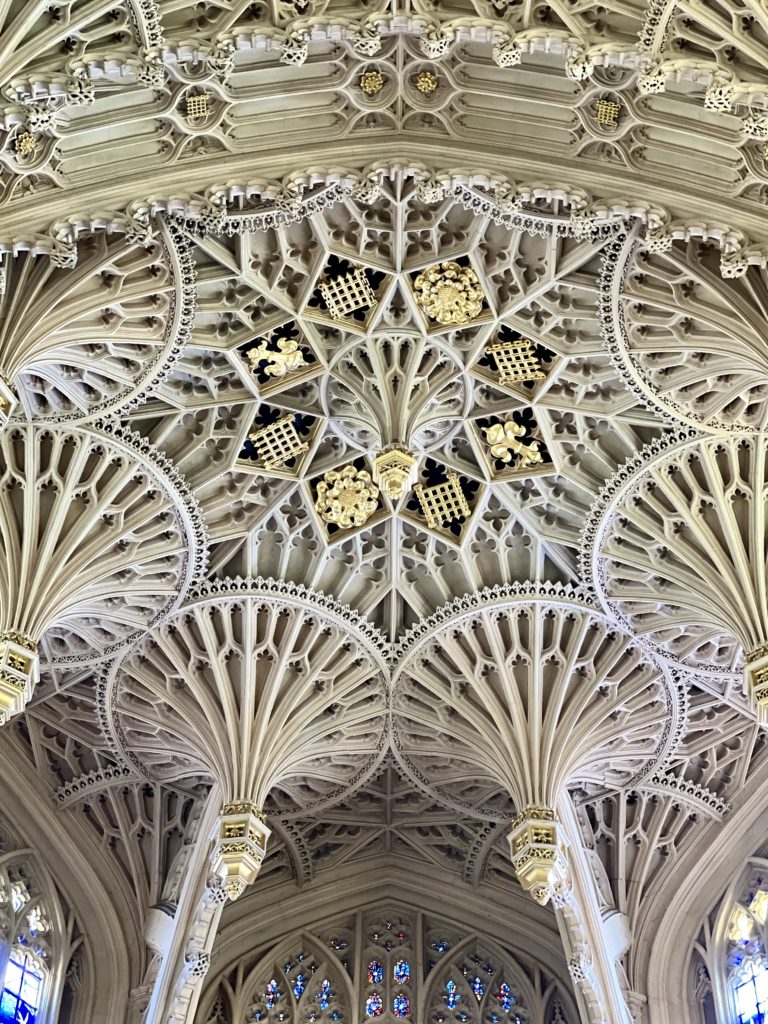
The pendants seem to defy gravity. They hang down like stalactites hanging from the roof of a fairy cavern.
The choir stalls were designated for all living Knights of the Most Honourable Order of the Bath . It was established in 1725 and is one of the premiere meritorious orders of the crown.
When a knight became part of the order, he received a stall that was adorned with his crest and coat of arms. You can see Lord Nelson’s stall plate on the south side.
Every four years, new knights are installed in a colorful ceremony. It’s attended by the Great Master, currently the Prince of Wales.
Throughout the chapel, you’ll see the motif of the “Tudor rose.” The rose is a mixture of the white rose of York and the red rose of Lancaster.
The motif was used heavily by Henry VII to emphasize the importance of the Tudor dynasty. It reiterated the legitimacy of his claim to the English throne, which was hotly debated during the War of the Roses .
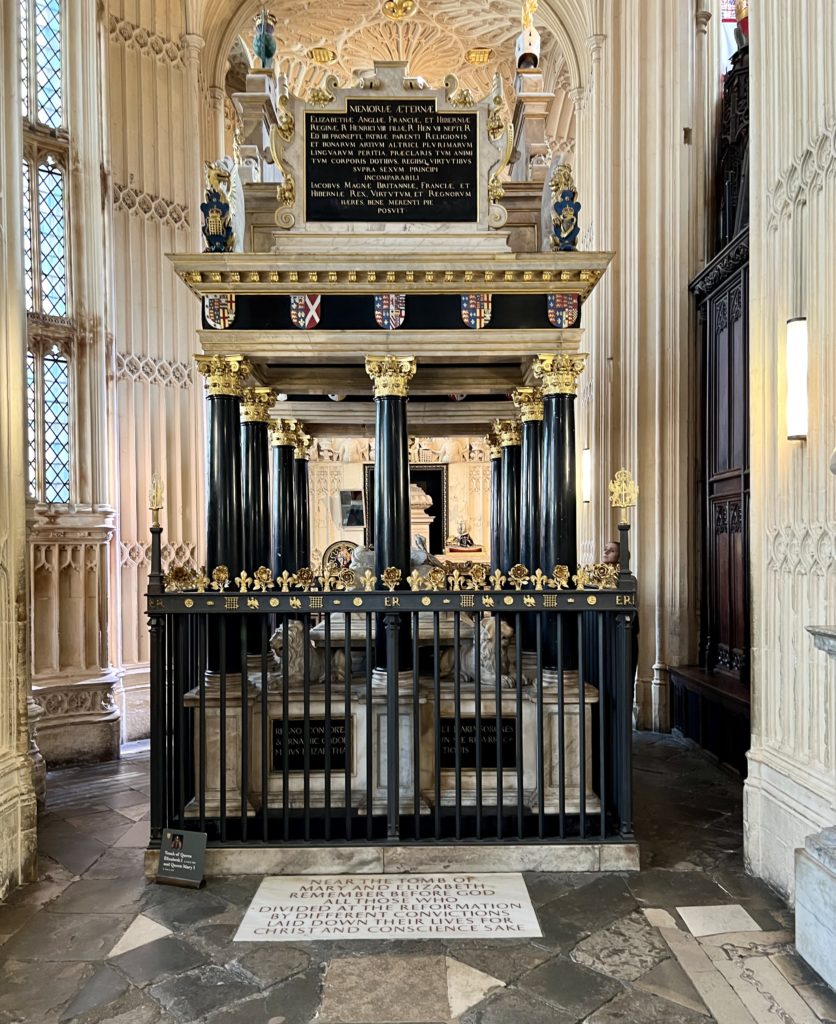
7. Royal Tombs : Who Is Buried In Westminster Abbey?
Many monarchs are memorialized with impressive tombs and monumental effigies in Westminster Abbey. Some of them were among the most important works of art from their age.
Times change though. Many recent royal burials are marked only by floor stones.
The royal tombs are mostly in the Henry VII Chapel, though not all. 15 kings and queens are buried in the Henry VII Chapel.
Henry VII and his wife, Elizabeth of York, share a magnificent Renaissance tomb. Their bronze gilt effigies were sculpted by Florentine artist Pietro Torrigiano, who had studied with Michelangelo . It lies behind the altar.
You’ll also find Henry VII’s granddaughter, Queen Elizabeth I. She was the daughter of the infamous Henry VIII and his second wife Anne Boleyn. Elizabeth’s royal orb symbolizes she was queen of the entire globe.
She’s buried in the chapel along with her half-sister, Mary I. At odds in life, they ironically lay together in death.
Henry VII’s mother, Margaret Beaufort, is also buried in the chapel. She was a rather evil (though ostensibly pious) lady who helped Henry VII secure the throne.
Beaufort likely would have been a CEO in today’s world. She died in 1509, shortly after Henry VIII’s coronation.
King James I is also buried in the vault beneath the monument.
His tomb was only discovered in 1867 when Dean Stanley searched and excavated the royal tombs looking for James’ final resting place, which had gone unrecorded.
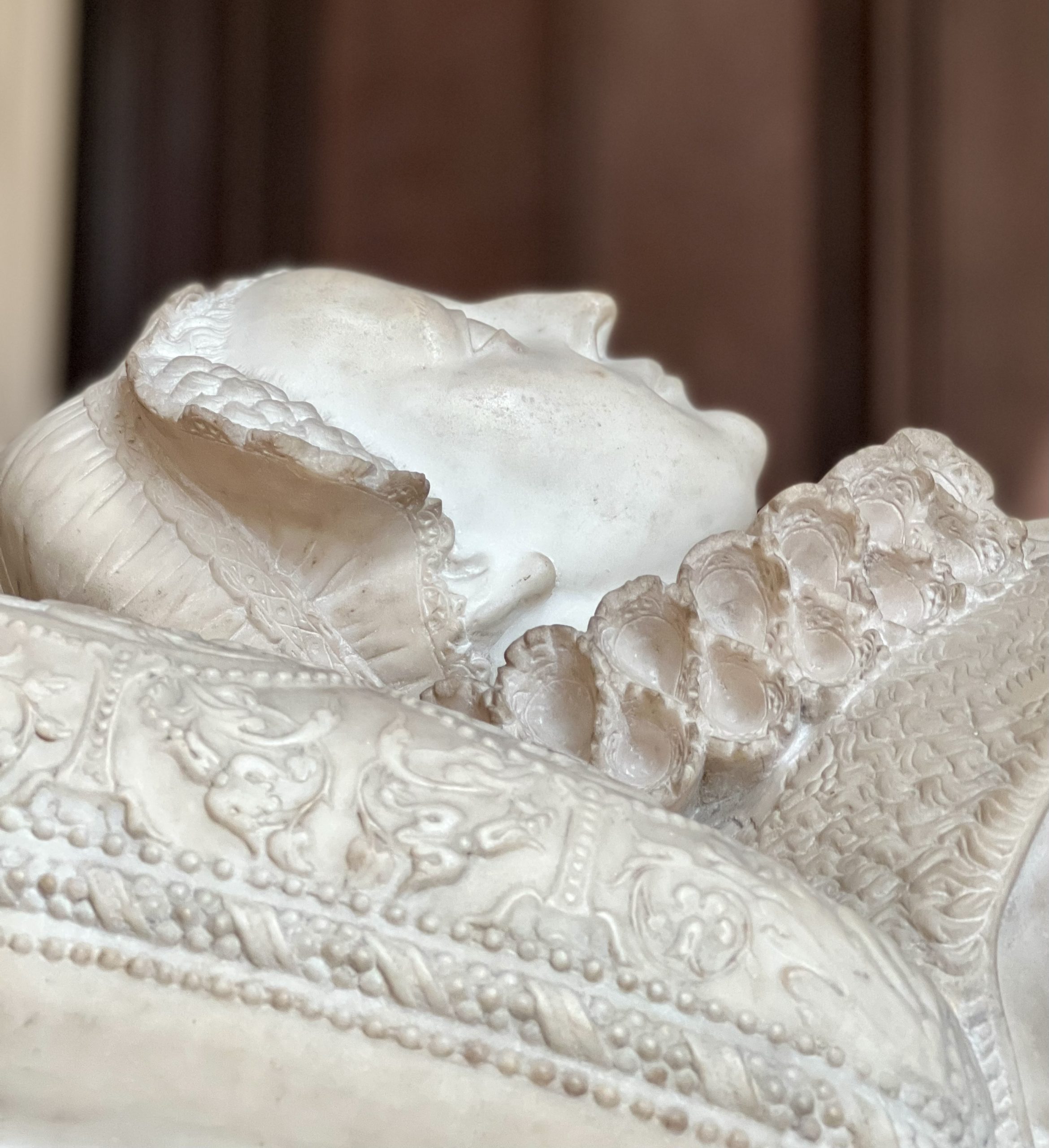
Mary Queen of Scots, who Elizabeth I executed for treason, is also buried there. Her tomb is grander than Elizabeth’s.
Having neglected his mother in life, Mary’s son James I commissioned a costly and majestic white marble monument in memory of his mother.
The Stuart monarchs and Hanoverian monarch are also buried there.
Another famous funerary item in the chapel is a white marble urn, which reputedly contains the remains of the “Princes in the Tower,” Edward V and his younger brother Richard, Duke of York.
The casket was designed by the architect Christopher Wren.
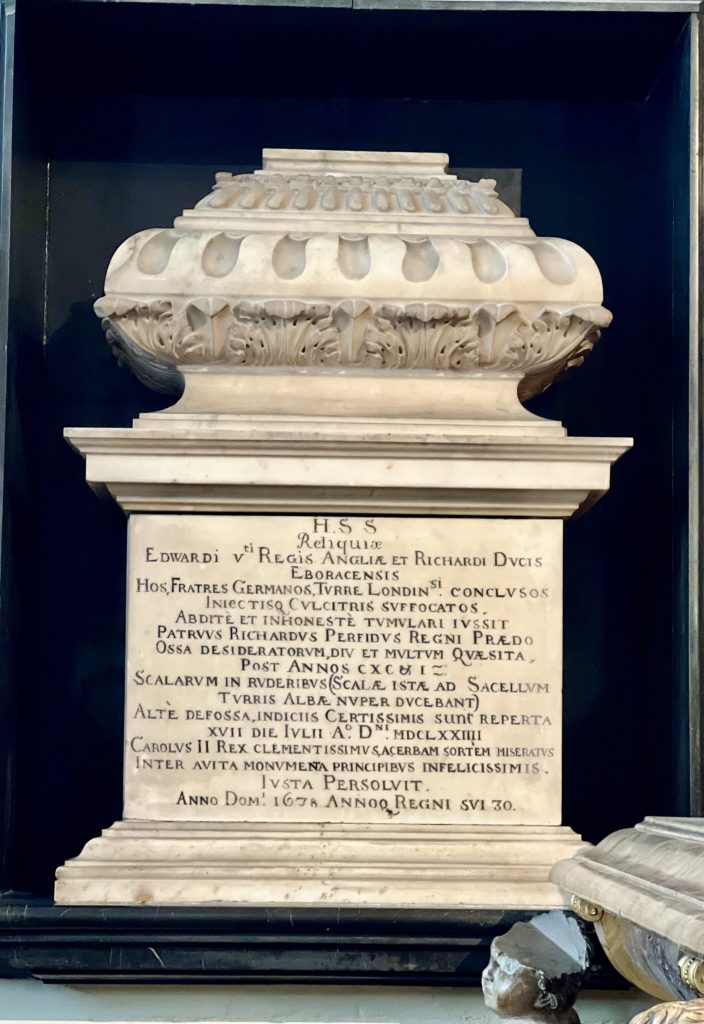
The princes were the sons of Edward IV, the brother of Richard III. While living in the Tower of London , the two princes disappeared in 1483.
Their uncle Richard III was subsequently crowned king. The princes’ fate is the greatest true crime cold case in English history, which I’ve written about at length .
Thanks mostly to posthumous Tudor propaganda, Richard III was accused of murder. In 1674, nearly two centuries later, workmen discovered the bones of two unidentified children in the tower.
It was immediately assumed the bones were those of the two princes. They were placed in the urn in the abbey on the order of Charles II. However, there’s no archeological, historical, or scientific evidence for that assumption.
You can also find the remains of the boy king Edward VI. He was Henry VIII’s only surviving son with his third wife Jane Seymour.
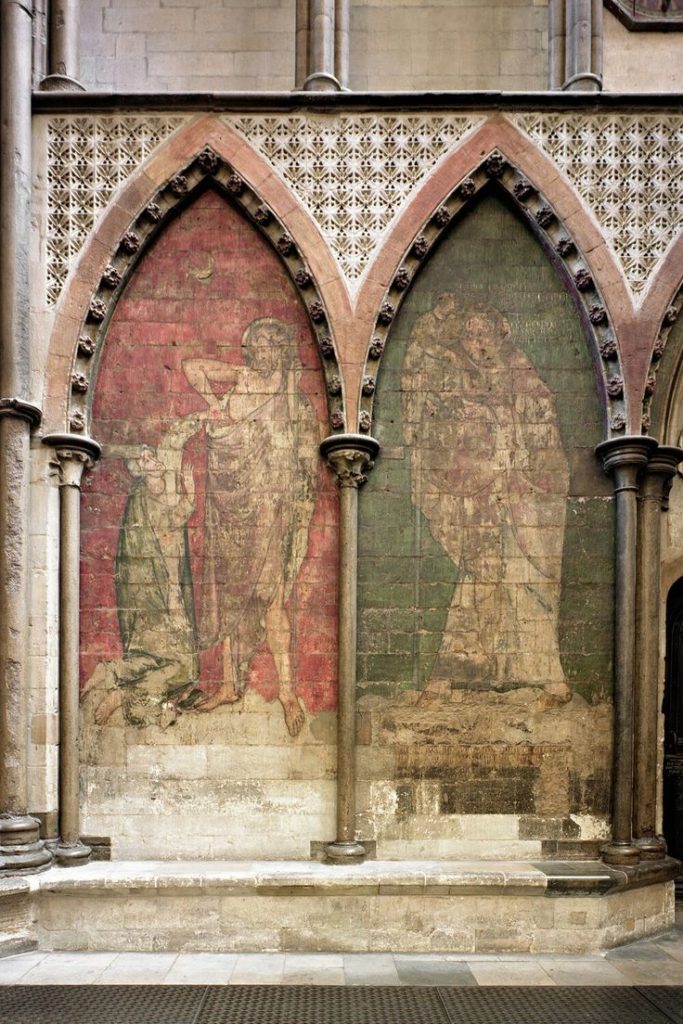
8. Medieval Paintings
In the south transept, you’ll find some important medieval paintings.
The paintings depict the incredulity of St. Thomas and St. Christopher carrying the baby Jesus.
In 1936, they were discovered behind two monuments during cleaning in the south transept.
The paintings are thought to date from around 1270. They’ve been attributed to Master Walter of Durham, the King’s Painter under Henry III.
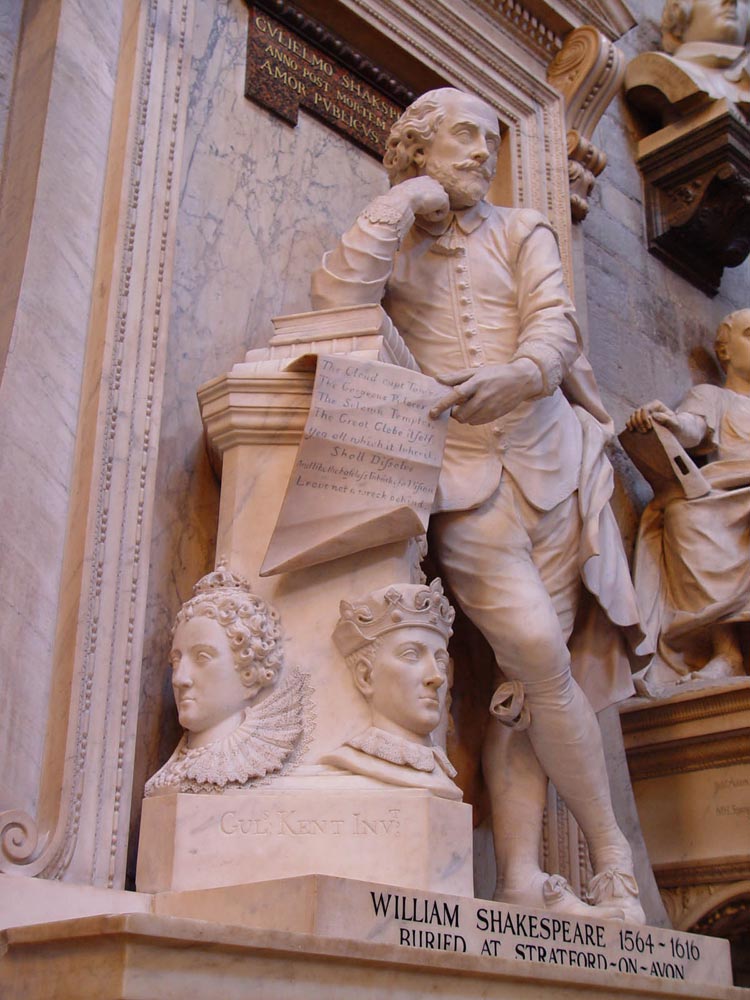
8. Poet’s Corner
The Poet’s Corner is also in the south transept. For lovers of English literature, strolling through Poets’ Corner can be a pilgrimage in itself.
This is where men and women of letters have been buried or commemorated for centuries. The tradition began almost by accident.
Geoffrey Chaucer was the first person buried in this part of the Abbey. Not because he was a poet, but because he worked at Westminster Palace next door.
The poet Edmond Spenser wanted to be buried near Chaucer. The precedent was set. The Poets’ Corner was born.
Other famous writers commemorated in Poets’ Corner are William Shakespeare, Robert Browning, Lord Bryon, Alfred Lord Tennyson, Lewis Carroll, CS Lewis, Charles Dickens, Rudyard Kipling, Thomas Hardy, Henry James, and Jane Austen.
There are even actors like Lawrence Olivier.
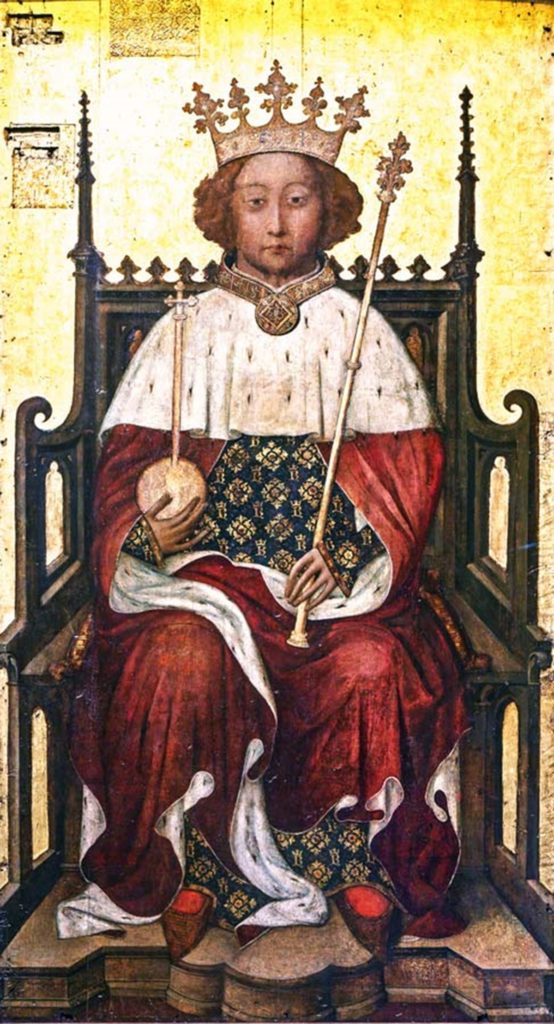
As space became more limited in the Poet’s Corner, names of newly honored writers are sometimes placed in stained glass or marble plaques. This is the case for Lord Byron, Oscar Wilde, and Christopher Marlow.
9. Painting of Richard II
A 14th century painting of Richard II hangs in the west end of the Abbey. You might miss if you don’t seek it out.
It’s an incredibly important work of art. It was the first portrait of an English sovereign to be painted in his lifetime. It’s one of the best medieval paintings in existence in any country.
The panting is 7 x 3.5 feet, but seems larger.
You can compare the painting to the king’s tomb effigy. His tomb is a double tomb with his Queen Anne of Bohemia. It’s near the shrine of Edward the Confessor.
For a period in the 18th century, a hole appeared on one side of the tomb. Visitors put in their hand, stealing his bones.
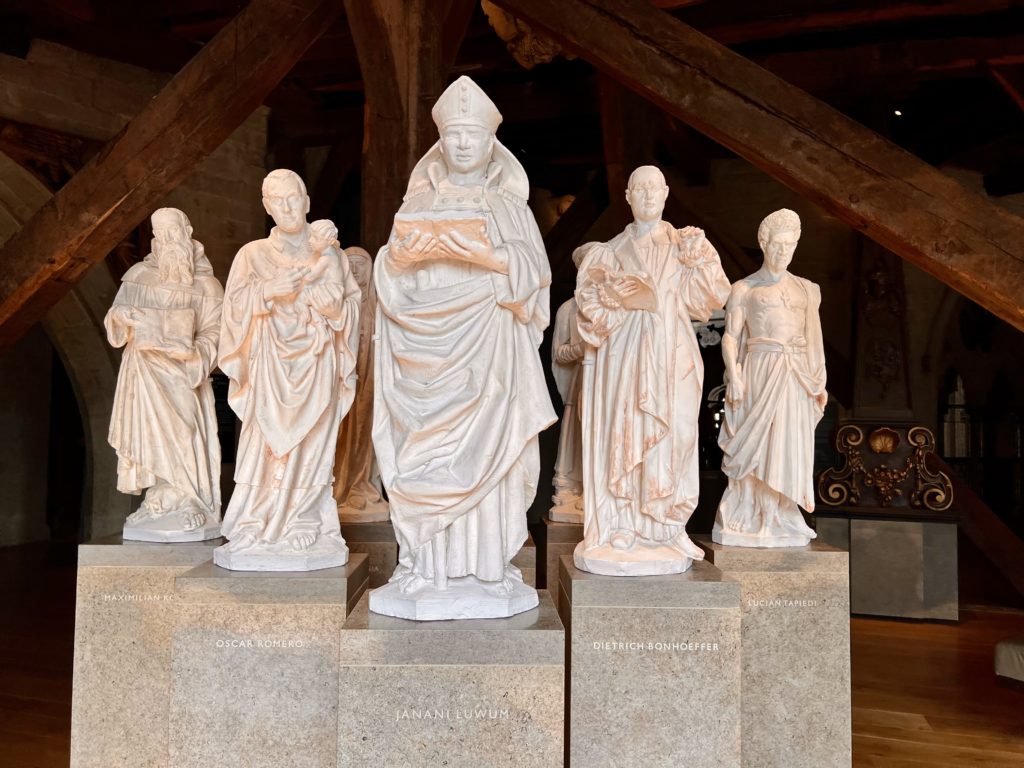
11. Queen’s Diamond Jubilee Galleries
You’ll want to pay the extra 5 pounds to climb up to the Queen’s Diamond Jubilee Galleries in the abbey’s Triforium. A triforium is a gallery above the arches of the nave and within the thickness of an inner wall.
The galleries opened to the public in 2018, after being hidden away for 800 years. They’re accessible from the new Weston Tower, the first addition to the abbey since 1745.
The galleries are in the eastern Triforium, which dates from 1250. The space were initially intended to be used for chapels. But high chapels fell out of fashion. The space was left empty.
The galleries have their own entrance to the right as you enter the abbey near Poet’s Corner. You can buy a ticket when you arrive at the abbey.
The galleries are 52 feet above the ground floor. It’s 100+ steps to the top.
You’ll have beautiful views of the abbey nave from atop. There’s also a lift, if you don’t want to hike up.
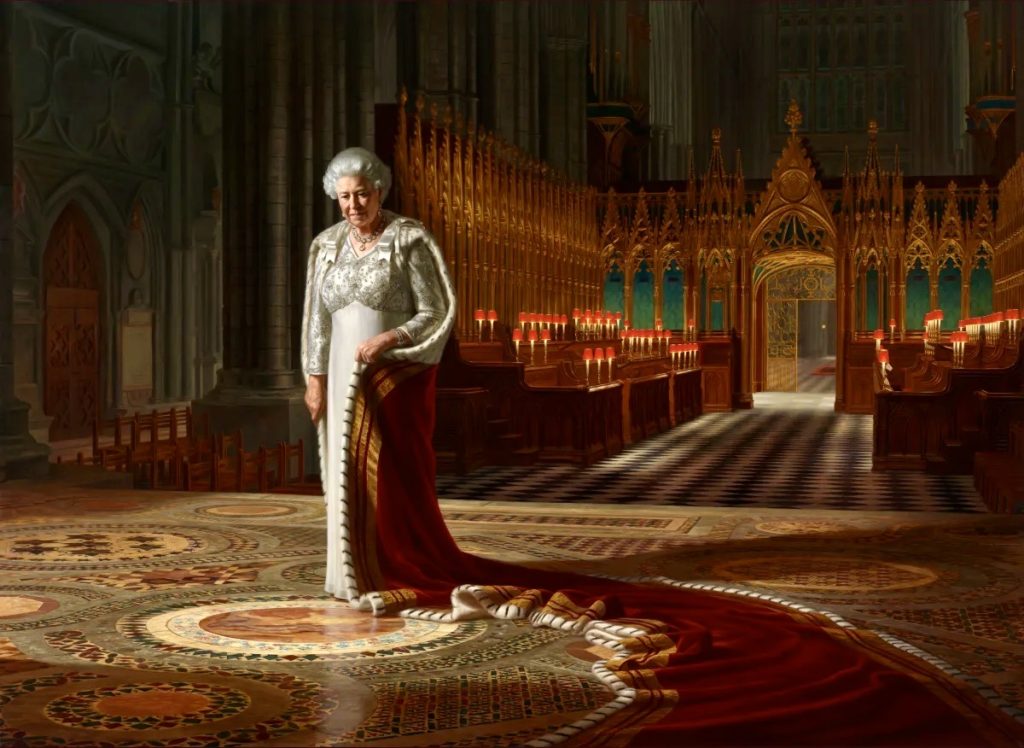
Over 300 special exhibits tell the story of the abbey’s 1,000 year history.
You’ll see funeral effigies of the monarchs, rare books, tapestries, crowns, sculptures, swords, and coronation capes. You can even see the marriage license of William and Kate.
One of the most famous objects on display is the Westminster Retable. It was originally designed for Henry III’s high altar in 1269. It’s made of painted and gilded wood and has undergone extensive conservation.
There’s also a remarkable funeral effigy of Henry VII. It was likely modeled on his death mask, yielding an accurate physical representation. It may have been created by Italian artist Pietro Torrigiano.
There’s a massive 9 x 11 feet portrait of Elizabeth II by Ralph Heiman. It shows her on the Cosamati pavement in front of the high altar, on the exact spot where she was crowned in 1953.
Unfortunately, you can’t take pictures in this part of the abbey. The guards are especially vigilant in the area where you look down into the nave.
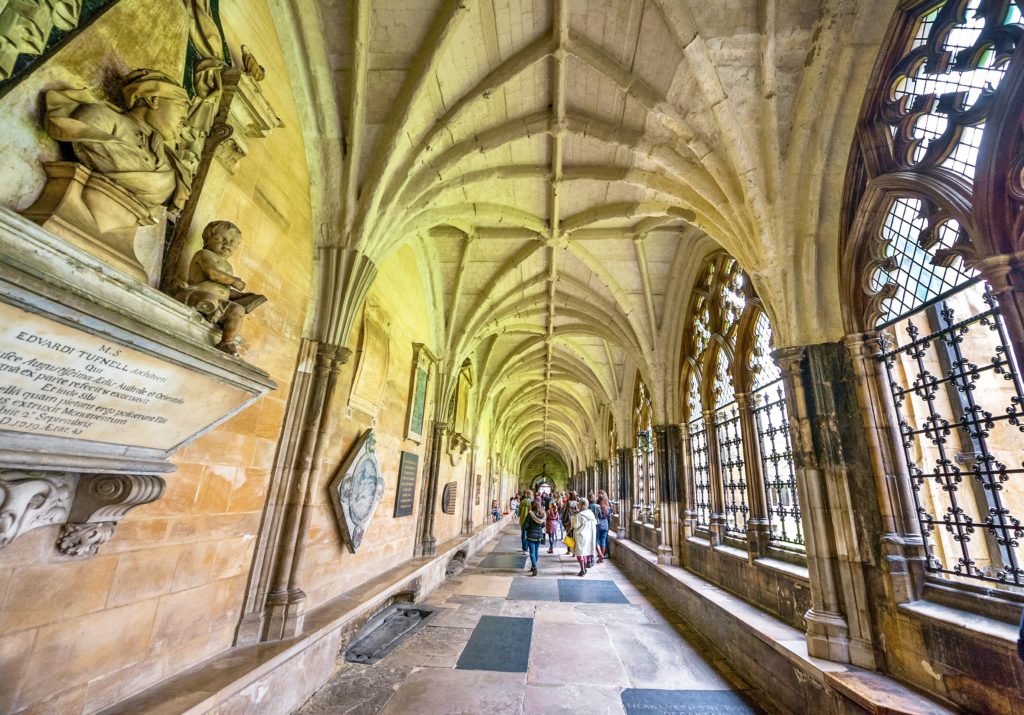
12. Cloisters
On the southeast side of the abbey as you’re heading out, you’ll find the place where the monks formerly lived, the medieval cloisters. They date from the 13th and 14th century.
The cloisters also housed the monks’ library and were used for recreation.
13. Chapter House
Off the east cloister is a vestibule leading to the Chapter House. This room is one of the largest chapter houses in Britain.
This is where the monks would meet each morning to listen to prayers and get their assigned duties.
The Chapter House was most likely built between 1246-55 on the orders of Henry III. Henry wanted his Chapter House to be “as the rose is the flower of flowers.”
The floor has medieval tiles. The beautiful tiles are some of the finest medieval tiles pavements in England. They were laid as a series of “carpets” running west to east from the entrance.
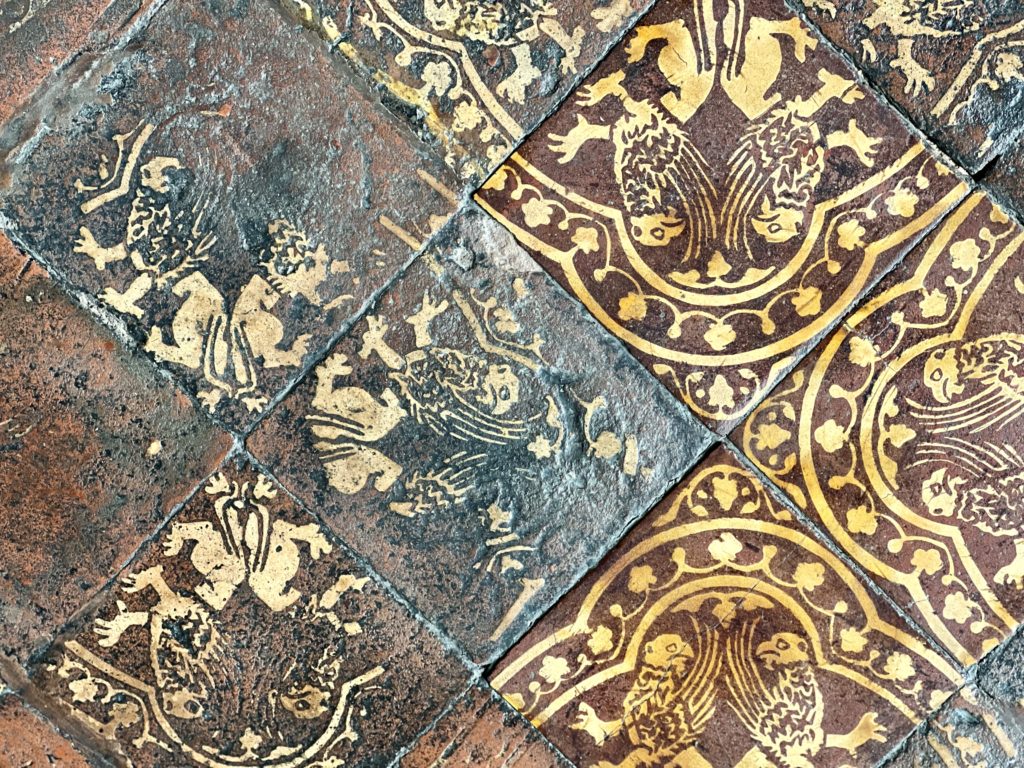
The designs were stamped via a pattern into clay and then filled with impressions with a lighter colored clay. You can see the coats of arms of Henry III with the three lions of England.
Some rare medieval paintings also survive on the Chapter House walls. They were painted around 1400 in the International Gothic style of art.
These paintings are the best preserved paintings from this era in all of England. They depict scenes from the apocalypse in a series of visions describe by St. John.
In the early 14th century, the crypt below the chapter house was used to store the regalia and royal money chests.
But it was broken into during the reign on Edward I when he was away on campaign. Though to be an inside job, nearly 50 monks were sent off to the Tower of London. They were only exonerated after a long trial.
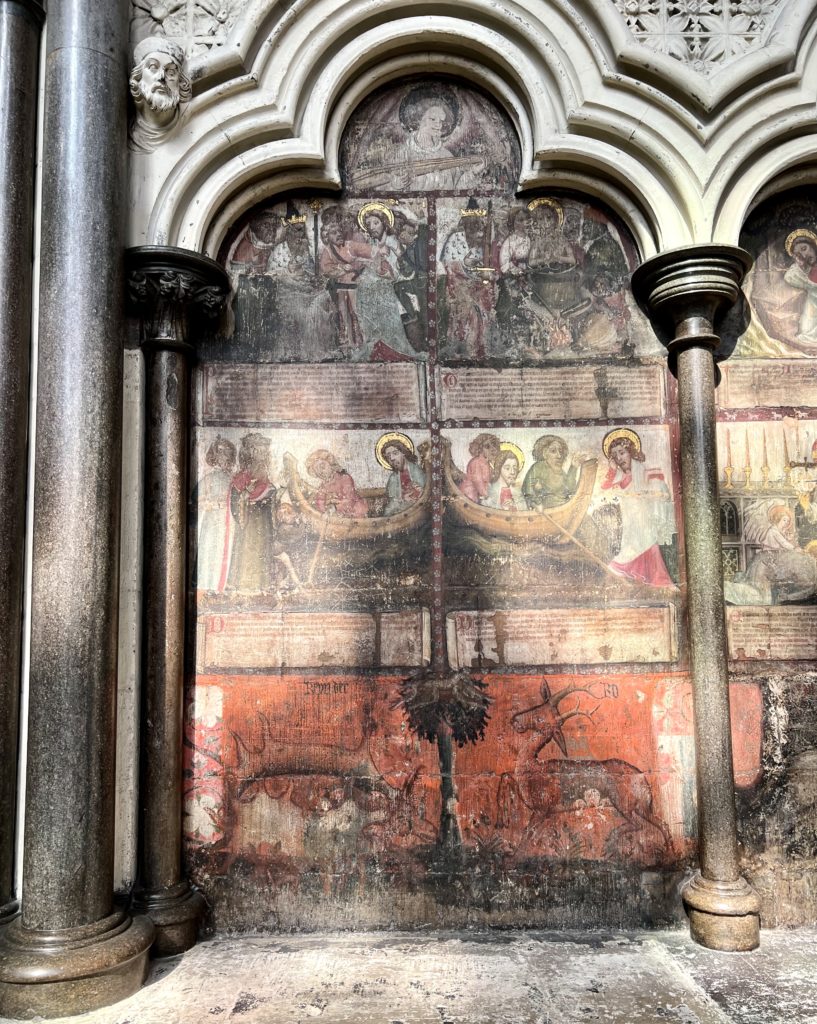
14. Pyx Chamber
The ancient Pyx Chamber is a room off the southwest corner of the cloisters. It dates from somewhere between 1065-90. It was originally the sacristy for Edward the Confessor’s old church, and is one of the few surviving remnants.
The Pyx Chamber has round arches and massive supporting columns. The chamber has a 13th century tiled floor.
If you walk through the dark rooms, you’ll come to the Little Cloister. This was the monks’ infirmary.
Beyond the Little Cloister is the abbey garden. At 900 years, it’s the oldest garden in England. This was where the monks grew herbs to make medicine. The garden is open to the public on certain days on the week.
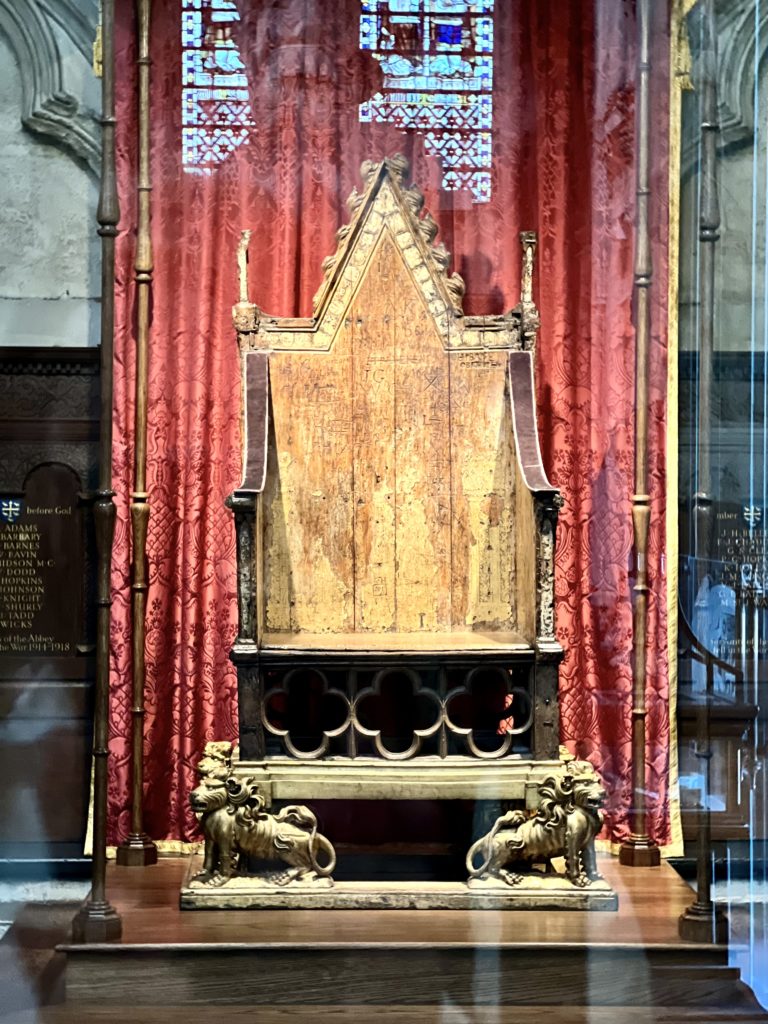
10. Coronation Chair
The Coronation Chair is on display just before you leave Westminster Abbey. It’s the oldest piece of furniture in Britain still used for its original purpose.
While coronations have taken place at the Abbey since 1066, the chair has only been used for the last 700 years. The lions around the base were added in 1727.
Originally, it was sumptuously decorated and gilded. But it’s been rather abused over the years, with graffiti carvings and the like.
The chair once held the famous Stone of Scone, also known as the Stone of Destiny. In 1296, the stone was captured by Edward I as spoils of war, taken to the abbey, and fitted into the wooden chair.
In 1996, the stone was restored to the people of Scotland and moved to Edinburgh Castle. But it will return for the next coronation upon the death of Elizabeth II.
Unfortunately, you can’t get too close to the Coronation Camber, which is behind glass. But that’s understandable given its age and significance.
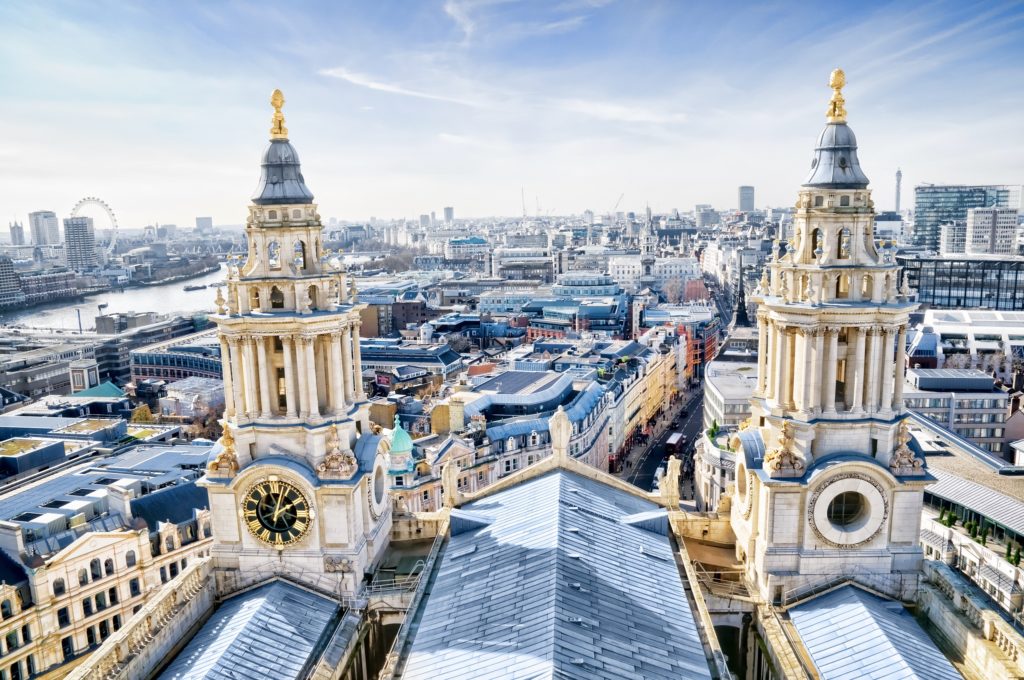
Practical Guide & Tips For Westminster Abbey
1. should you visit westminster abbey or st. paul’s cathedral.
Ideally, you should visit both of these iconic landmarks on a visit to London. But you may not have time. And they could not be more different. If pressed, I would pick the abbey.
Westminster Abbey is more centrally located in the heart of the city. It’s steeped in history and will appeal to lovers all of things ancient and Gothic.
In addition, if you are interested in royal history, the abbey is where you can pay homage to your favorite king or queen.
St. Paul’s is also a worthy bucket list attraction and Christopher Wren’s defining architectural masterpiece. The Baroque architecture, mosaics, monuments, and the dome itself are all stunning.
One key advantage St. Paul’s has over Westminster Abbey are the viewing galleries in the dome. You have fantastic views of all of London. You can read my complete guide to St. Paul’s Cathedral .
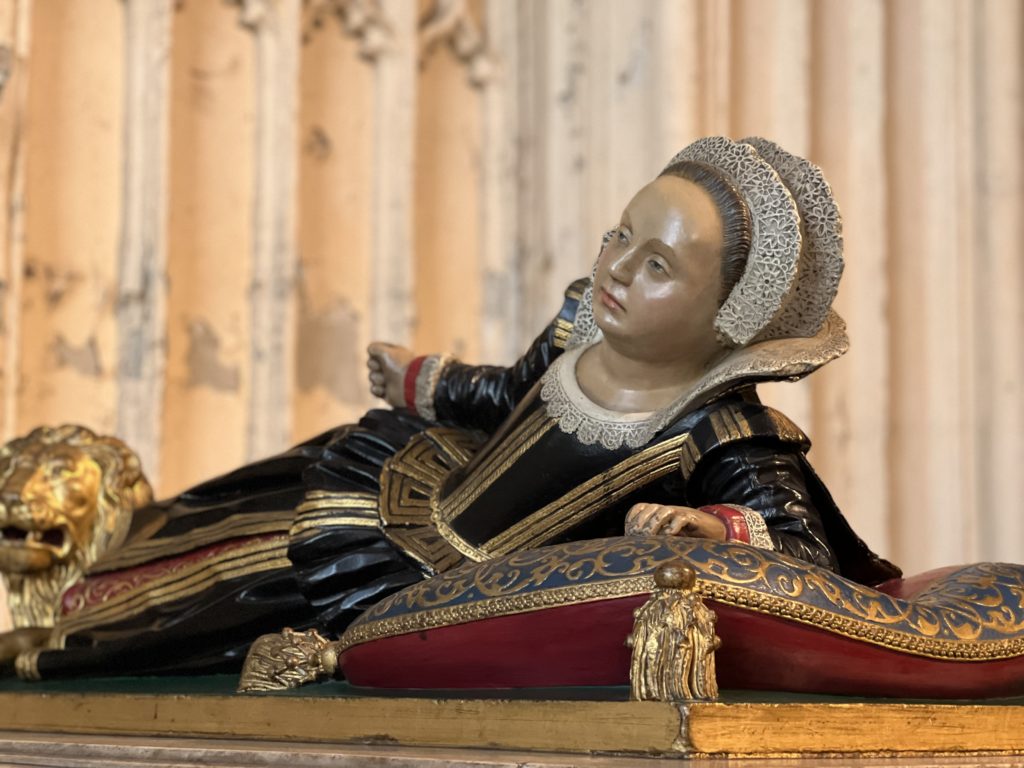
2. Where To Stay Near Westminster Abbey
Want to stay near Westminster Abbey? It’s a good area for sightseeing with many attractions nearby.
The best place to stay is the St. Ermin’s Hotel , a place of sophistication and elegance. You enter through a tree-lined courtyard.
The Guardsman is also a fine choice. It’s a beautiful boutique hotel in heart of London with the feel of a members club. It has a location fit for kings and queens near Buckingham Palace.
Taj 51 Buckingham Gate has five star luxury suites, with restaurants and an in house spa.
3. When To Visit Westminster Abbey
Try to arrive about 20 minutes before opening time at 9:30 am. There may already be a line. But tourist groups will start coming later and the abbey will be even more crowded.
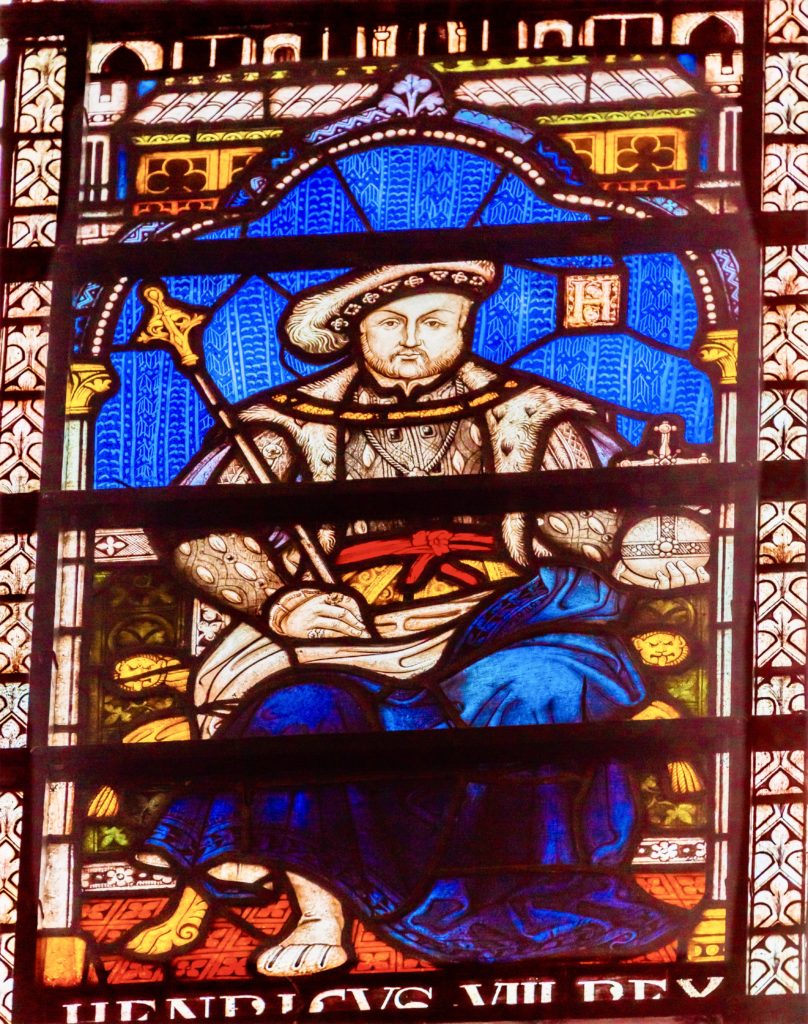
4. How Long To Visit Westminster Abbey
This totally depends on your interest in the individual monuments and effigies. I estimate 90 minutes to 2 hours for most people.
But you could easily spend 3 hours there, if you have a more leisurely schedule and want to read everything.
5. Verger Tours Of Westminster Abbey
Vergers are abbey staff who attend to the cathedral’s important visitors and help the clergy. Verger tours last approximately 90 minutes.
You can only book one at the information desk after your arrival at the abbey. You can’t book them online. They cost an additional £10.
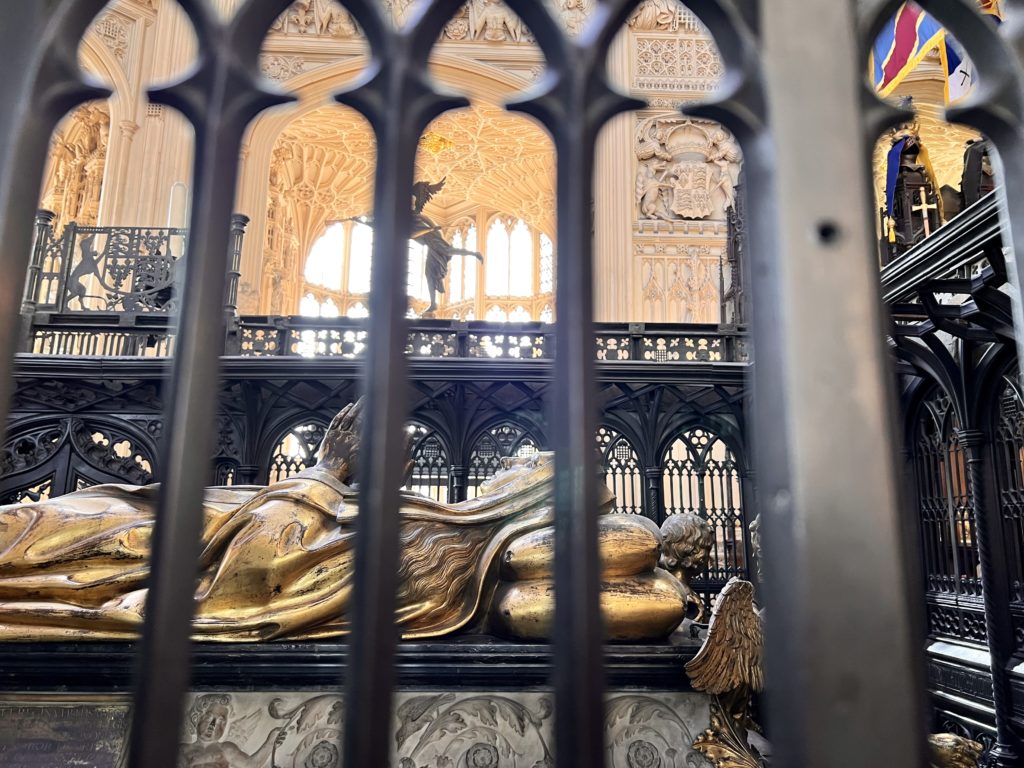
I highly recommend taking one if you can! The vergers are incredibly knowledgable abbey experts. They can take you to places not accessible on a general visit, such as the tomb of Edward the Confessor.
But you need to plan your visit in advance to coincide with the tours. They leave at 11:00 am, 11:30 am, and 2:00 pm.
6. Other Practical Information
Address : 20 Deans Yard London
Hours : Click here for hours. The abbey isn’t open on Sunday.
Ticket Prices :
The standard ticket price for the abbey is £ 25. You have free entry with the London Pass , but cannot enter via the fast trick line.
It’s free to visit the abbey during a service, but you cannot sightsee. An audioguide is free with admission.
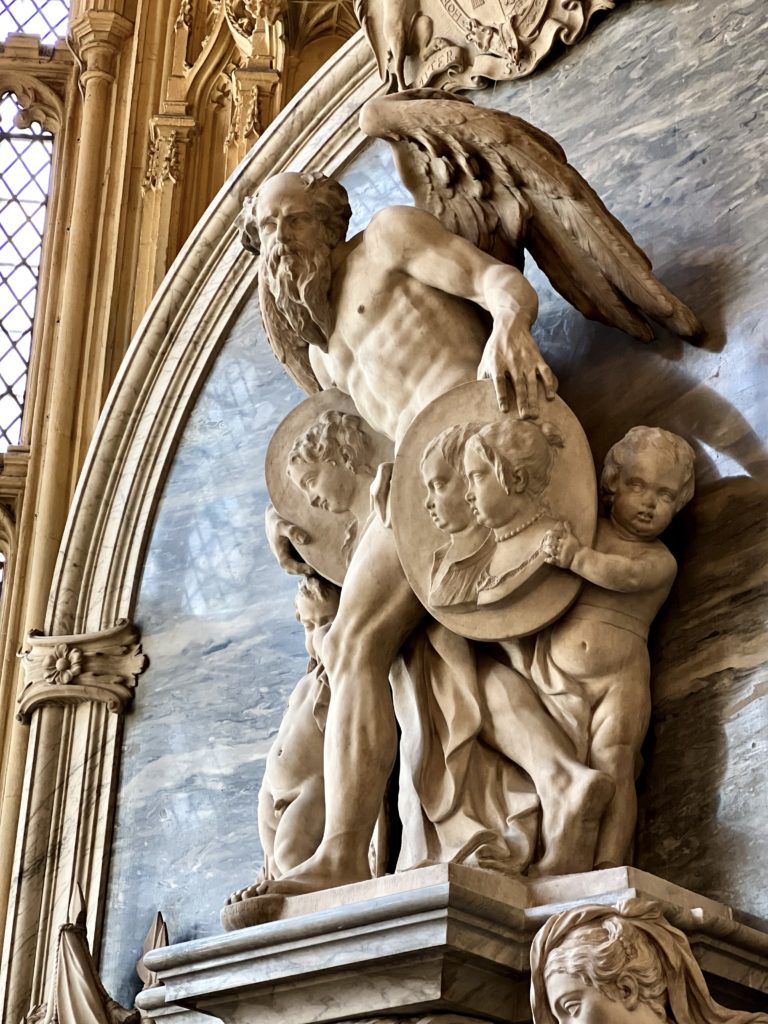
Tube Station : Westminster is the closest. Victoria and St. James are the next nearest.
Westminster Abbey App : The abbey has a multimedia guide that you can download in advance on your phone.
Photography : You can take photos for non-commercial use in the abbey, but not in the Queen Galleries.
I hope you’ve enjoyed my guide to Westminster Abbey. You may enjoy these other London travel guides:
- 3 Days in London Itinerary
- 5 Days in London Itinerary
- One Day In Bath Itinerary
- Guide To Free Museums in London
- Guide To the National Gallery of Art
- Harry Potter Places in London
- Guide To the Churchill War Rooms
- Guide To St. Paul’s Cathedral
- Guide To The Wallace Collection
- Tourist Traps To Avoid in London
- Guide To the Tower of London
If you need a guide to Westminster Abbey, pin it for later.
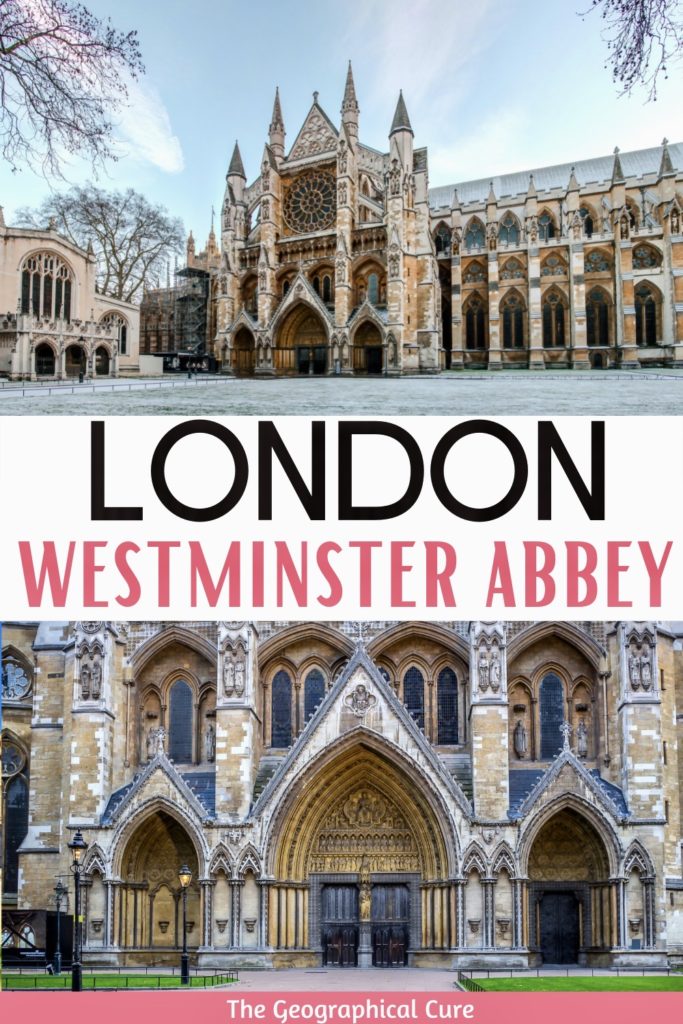
Leave a Comment Cancel reply
Save my name, email, and website in this browser for the next time I comment.
Last Updated on May 2, 2024 by Leslie Livingston

Visiting Westminster Abbey – Tickets, tours & FAQs
By: Author Tracy Collins
Posted on Last updated: July 1, 2024
- Everything you need to know to plan and book your visit to Westminster Abbey
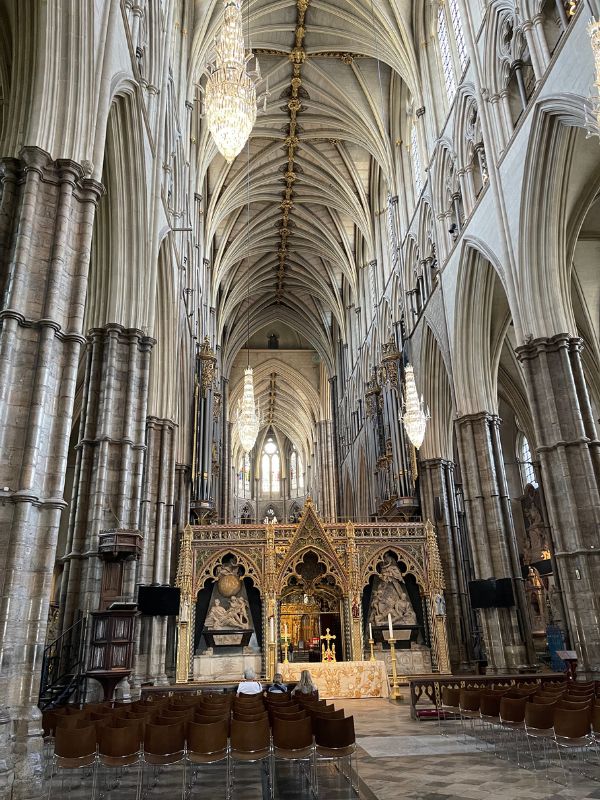
Visiting Westminster Abbey: Tickets + Tours
Westminster abbey facts and figures, what to see at westminster abbey, getting to westminster abbey, opening hours, when is the best time to visit, services at westminster abbey.
- What other London attractions are located near Westminster Abbey?
Tips for planning your visit
Our top 3 picks: westminster tickets & tours.
#1 TOP PICK

⭐️⭐️⭐️⭐️⭐️ Westminster Abbey Tour with Diamond Jubilee Galleries
✔️ Skip the line entry ✔️ Exclusive access to the Diamond Jubilee Galleries ✔️ Small group tour with guide

Westminster Abbey Entrance Ticket ✔️ Book with Get Your Guide for free cancellation (up to 24 hours before) ✔️ Exchange at ticket office at the Abbey

Guided tour of Westminster Abbey and Houses of Parliament
✔️ Combined small group tour ✔️ Explore 2 top London destinations ✔️ Guide
Nearest Tube station – Westminster ( Circle, District and Jubilee lines )
How long to set aside for your visit? 1½ – 2 hours
- Westminster Abbey Entrance Ticket
Good to know – Entry to Westminster Abbey is included in the London Pass .
Combi tickets
- Westminster Walking Tour & Westminster Abbey Entry – Walking tour of the top 20 sights of Westminster (3 hours) and Westminster Abbey Entrance Ticket
- Skip the Line Westminster Abbey Tour with Diamond Jubilee Galleries – Skip the queues and dive into the history of England’s most important Gothic building, including the exclusive Queen’s Diamond Jubilee Galleries.
Guided tours
Prefer a guided tour of Westminster Abbey?
- Guided tour with early access to Westminster Abbey – Buy ticket
- Private 2 ½ hour tour of Westminster Abbey with skip-the-line and a London Blue Badge Guide. – Book here
- Skip-the-line Westminster Abbey small group tour with a guided visit & tour around the Houses of Parliament – Book here
- Verger-guided tours are available for £10 but can only be booked on arrival. Spaces are limited and are subject to change or cancellation at short notice.
- Small group tour including entry and tour of Westminster Abbey & tour of Big Ben(external) – Book here
- Walks Tours – London in a Day small group tour – includes Westminster Abbey, the Tower of London and the Changing of the Guard.
Visiting Westminster Abbey
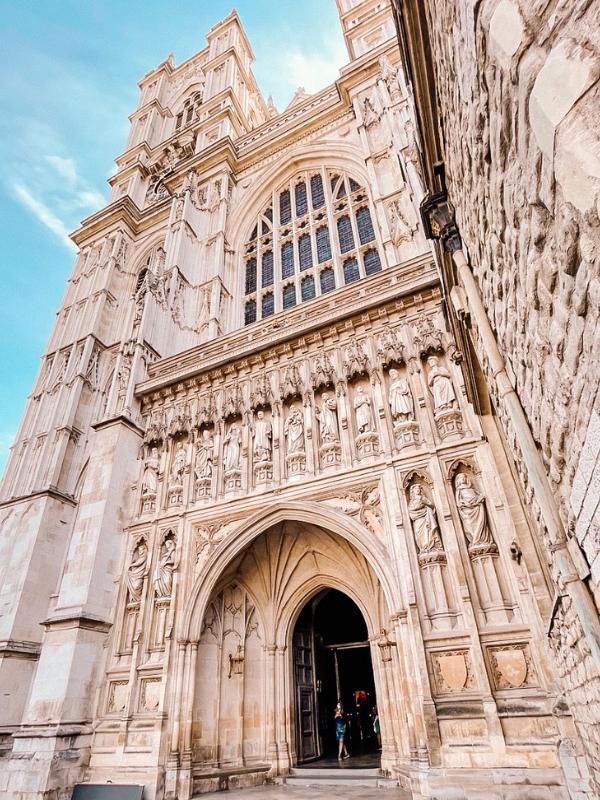
- Westminster Abbey was founded in the 10th century and is where every British monarch since 1066 has been crowned.
- The Coronation Chair (which has been used since the 14th century) can be seen in the abbey.
- It was constructed between 1245 and 1517 and is considered one of the finest examples of Gothic architecture in the world.
- The tombs of 17 monarchs and located in the Abbey.
- 16 royal weddings have taken place in the Abbey including the marriage of Prince William and Kate Middleton in 2011.
- Poets’ Corner contains memorials to many of England’s greatest writers, including Chaucer, Shakespeare, and Austen.
- The abbey’s famous “Oak Screen” was carved from a single oak tree and is considered one of the finest examples of medieval wood carving in England.
- Westminster Abbey was designated as a UNESCO World Heritage Site in 1987.
- The abbey’s bell tower, known as the Great West Tower, is the largest and highest of its kind in the UK. Its bell – known as “Great Tom” – is the largest bell in the country.
- Many famous people are buried in the Abbey including Sir Isaac Newton, Stephen Hawking, George Frederic Handel, Laurence Olivier and Charles Dickens.
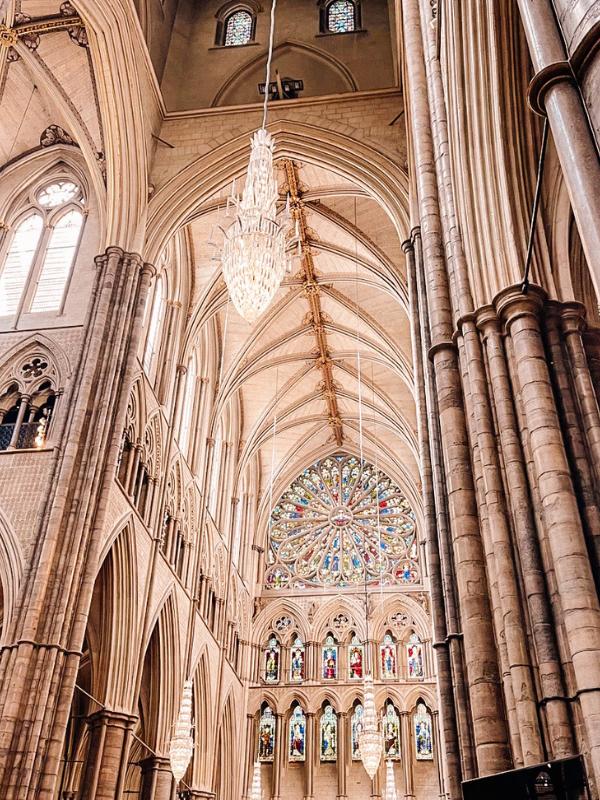
If you are visiting Westminster Abbey as part of your London itinerary it is good to know a little before you visit so you don’t miss anything which is of particular interest.
- Poet’s Corner – located in the south transept more than 100 poets and writers are buried or have memorials here.
- Coronation Chair – is located in a specially-built enclosure within St George’s Chapel at the west end of the Nave. The chair has been used for the Coronation of British monarchs since 1399.
- Royal Tombs – at the eastern end of the church are the tombs of 30 kings and queens
- The Lady Chapel – is located at the Eastern end of the church and has a spectacular fan-vaulted ceiling
- The grave of the Unknown Warrior – on 11th November 1920 a body was brought from France to be buried here. The grave is located at the west end of the Nave.
- The Cloisters – is the area where the monks would have spent most of their time
- The Quire – is where the choir sit and is located in the centre of the Abbey.
- Pyx Chamber – is one of the oldest parts of the Abbey and was built around 1070 and is located off the East Chapter.
- Chapter House – is a meeting place where the monks gathered with the abbot the Chapter House is located in the East Cloister.
- The Queen’s Diamond Jubilee Galleries – Located 16 metres above the floor of the Abbey the galleries display treasures and tell the history of the Abbey. Additional charge – timed tickets .
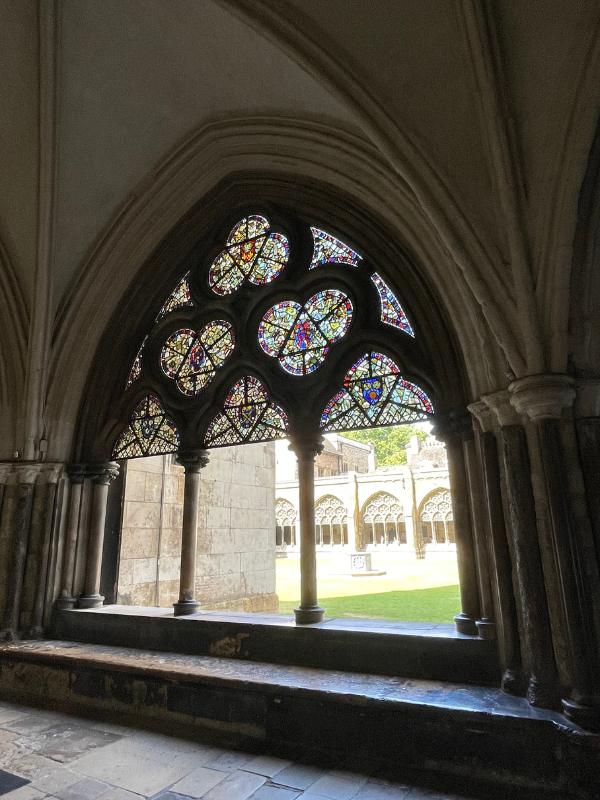
- Tube: The closest tube station is Westminster (Circle, District and Jubilee lines) which is less than a 5 minute walk to the Tower of London.
- Overground rail: Victoria Station
- Bus routes: There are a number of bus routes that pass by the Abbey including 11, 24, 88, 148, 211
- Uber boat: Westminster Pier
- Sightseeing buses: All major sightseeing buses pass by the Westminster Abbey
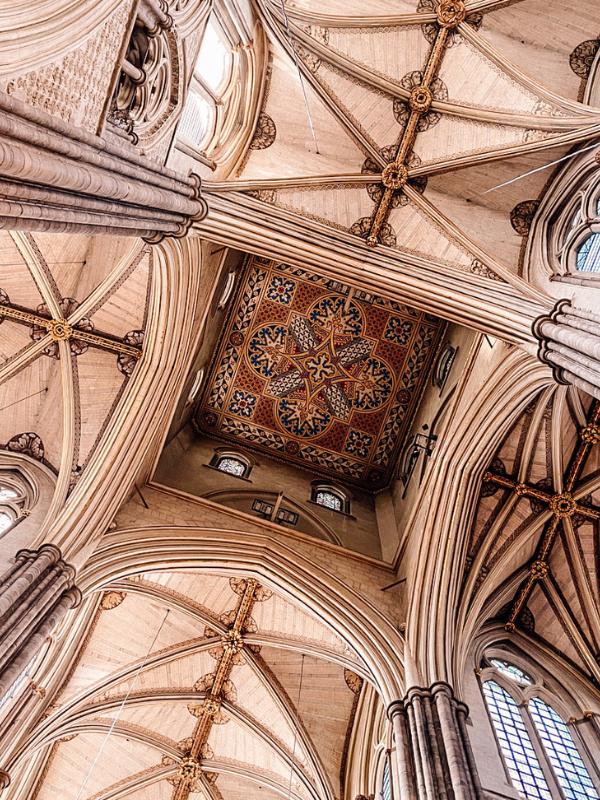
Westminster Abbey is a church and as such is open for services on Sundays but not for sightseeing.
- Monday – Friday: 9:00 AM – 3.30 PM
- Saturday – 9:00 AM – 3:00 PM
The Queen’s Diamond Jubilee Galleries
- Monday – Friday: 10:00 AM – 3.00 PM
- Saturday – 9:30 AM – 3:00 PM
- Westminster Abbey is one of the most popular tourist attractions in London so expect it to be busy!
- It can be especially crowded on Saturdays and during London’s peak season.
- If possible plan your visit for a weekday.
- Visit as early in the day as you can – be there before opening time or book a tour which allows early access or skip the line like this one .
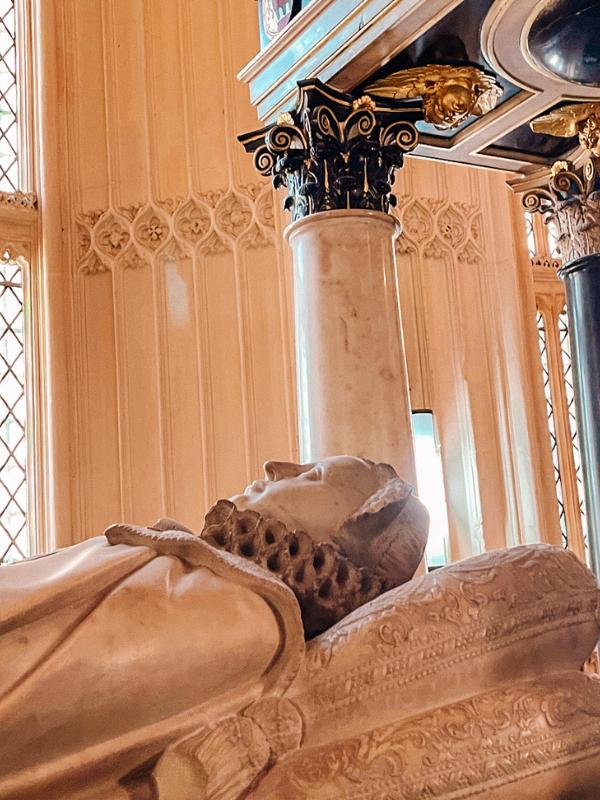
There are regular services at Westminster Abbey which can be attended by the public and are free of charge.
- Morning Prayer
- Holy Communion
- Evening Prayer
- Sung Eucharist
Choral services are sung daily during term time by the Choir of Westminster Abbey. Sundays are the best time to visit to hear the choir as there are a number of services held. Alternatively, attend for Evensong during the week which is held around 5.00 PM.
Do check the official calendar when planning your visit.
What other London attractions are located near Westminster Abbey ?
- The Houses of Parliament (Palace of Westminster)
- Churchill War Rooms
- 10 Downing Street
- Buckingham Palace
- Personal photographs are allowed in the church but the use of a flash is forbidden. No pictures are allowed during services nor permitted at any time in the Shrine of St Edward the Confessor, St Faith’s Chapel or The Queen’s Diamond Jubilee Galleries.
- Food and drink – Meals are served throughout the day at the Cellarium Café and Terrace. There is also a Kiosk that offers snacks, a light meal and drinks. A popular and affordable afternoon tea is served at the Cellarium Café and Terrace .
- A multimedia guide is included with the entry ticket – it is available in 14 languages. The app can be downloaded before you visit – Apple here , Android here or you can use a device supplied upon entry to the Abbey.
- The floor of the Abbey and steps are uneven so ensure that you are wearing sensible footwear.
- Bag checks are carried out before entry to the Abbey. There is no facility to check large bags or suitcases.
- There is no dress code but visitors are requested to dress respectfully.
READ NEXT – Things to do and see in Westminster
- Visiting the Tower of London
- Visiting the London Eye
- Visiting Windsor Castle
- Visiting Kensington Palace
- Hampton Court Palace
- St Paul’s Cathedral
- Best apps for London
London Travel Guide & Itinerary Planner Ebook (+ 4 BONUS ebooks)
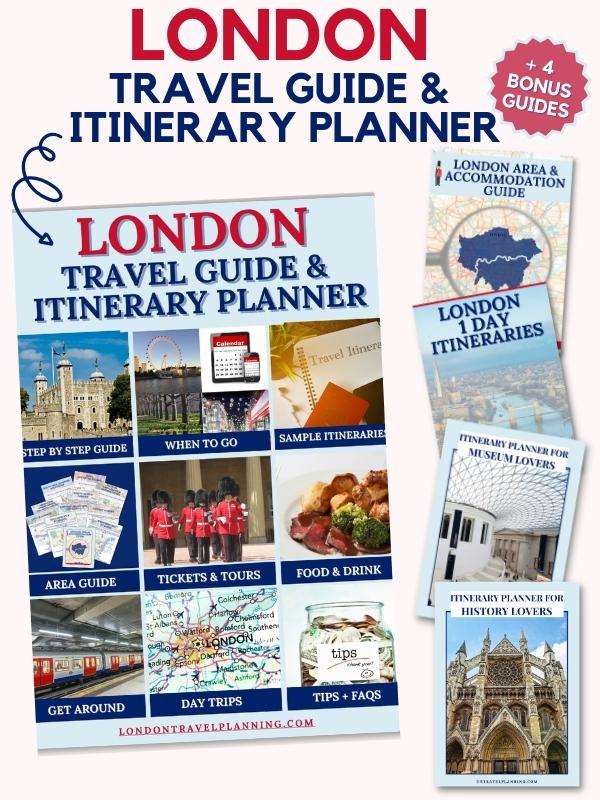
- Search Please fill out this field.
- Newsletters
- Things To Do
Westminster Abbey
Everything You Need to Know Before Visiting
Gautier Houba / TripSavvy
Westminster Abbey was founded in AD960 as a Benedictine monastery. This was when most European Christians were Roman Catholic, but following the Reformation in the 16th century the Church of England was formed. Many traditions remain in the Abbey but services are conducted in English, and not Latin.
Westminster Abbey is the nation's Coronation Church and also the burial and memorial place for historical figures from the last thousand years of British history. Westminster Abbey is still a working church and all are welcome to attend the regular services.
- Westminster Abbey Parliament Square London SW1P 3PA
Nearest Tube Stations
- Westminster
- St. James's Park
Nearby you'll find a popular Harry Potter Film Location in London .
Opening Times
- Monday to Saturday: 9.30am - 4.30pm
- Monday, Tuesday, Thursday, Friday: 9.30am-4.30pm (last admission 3.30pm)
- Wednesday: 9.30am-7.00pm (last admission 6.00pm)
- Saturday: 9.00am-3.00pm (last admission 1.30pm)
- On Sundays the Abbey is open for worship only.
Check official website for current opening times .
90 minute verger-led tours, in English only, are available to individuals for a small additional charge. Audio tours (English version narrated by Jeremy Irons) take around an hour and available in seven other languages: German, French, Spanish, Italian, Russian, Mandarin Chinese, and Japanese. They are available at the Abbey's Information Desk near the North Door.
Photography and Cellphones
Photography and filming (pictures and/or sound) of any kind is not allowed in any part of the Abbey at any time. Visitors can take pictures in the Cloisters and College Garden for personal use only. Postcards showing the interior of the Abbey are available to buy in the Abbey shop. The use of mobile phones is permitted in the Cloisters and College Garden. Keep mobile phones switched off within the Abbey church.
Official Website
www.westminster-abbey.org
See Westminster Abbey for Free
You can see inside Westminster Abbey for free. The Abbey never charges people who want to worship but they rely on admission fees from visitors to cover running costs. Evensong is the most beautiful of services where the Abbey choir sings. The Choristers of the Choir are educated at Westminster Abbey Choir School and are all extremely talented. Evensong is at 5pm on Mondays, Tuesdays, Thursdays, and Fridays, plus at 3pm on Saturdays and Sundays.
What To See
Even without an audio guide, or guidebooks, I would say you could enjoy a visit to Westminster Abbey as it's an awe-inspiring building. I was gob-smacked the first time I went inside: at the architecture, the history, the artifacts, the stained glass windows, oh by everything!
Top Tip: The Abbey staff are extremely knowledgeable and always willing to answer questions. I've learned much more from speaking to Abbey staff than from guidebooks.
Do try to see the various British royalty tombs and the Coronation Chair near the Shrine of St. Edward the Confessor, plus the additional Coronation paraphernalia in the Abbey Museum. Poet's Corner has tombs and memorials for such well-known writers as Geoffrey Chaucer, Charles Dickens, Rudyard Kipling, Thomas Hardy, D H Lawrence, and Alfred Lord Tennyson.
The Grave of the Unknown Warrior is a fascinating story of a body brought back from France after the First World War, along with 100 barrels of French soil to bury him. The black marble slab is from Belgium and the gold lettering was made from shell cases collected on the fields in France .
The only Congressional Medal of Honor given outside of the US was presented to the Unknown Warrior on 17 October 1921 and this hangs in a frame on a pillar nearby. College Garden is thought to be oldest garden in England at nearly 1,000 years old. Pick up a leaflet at the garden entrance to learn about the planting. College Garden is open Tuesday, Wednesday and Thursday.
- Family Top Tip: Children can dress as a monk and have their photo taken in the Cloisters. Go to the Abbey Museum and ask to borrow a costume!
- Christmas Top Tip: St. George's Chapel has a stunning nativity scene each Christmas which adults and children always adore.
Where to Dine Locally
Opposite the Abbey is the Methodist Central Hall . There is a cafe in the basement which is nothing fancy (plastic chairs and vinyl tablecloths) but does serve decent hot and cold food at reasonable London prices. It's a huge dining space and I've always found it a haven from the hustle and bustle of Parliament Square. The Supreme Court is opposite too and has a great cafe in the basement.
Related Articles
More related articles.

Visiting Westminster Abbey: Helpful tips, photos & history
- David Angel
- London , England , United Kingdom
About the Author: David Angel is a British photographer, writer and historian with 30+years experience exploring Europe. His work regularly appears in global media including the BBC, Condé Nast Traveler, and The Guardian.
This is my guide to visiting Westminster Abbey, an essential stop on many London itineraries. This guide will help you make the most of your visit .
Visiting Westminster Abbey is one of the highlights of any trip to London. We’ll show you what to see in Westminster Abbey, from architectural highlights to the many great monuments inside.
I’ll also share Westminster Abbey tips to make your visit as smooth as possible and show you how to buy tickets in advance to avoid the lengthy queues.
Visiting Westminster Abbey is one of the absolutely essential things to do in London. Whether you’re spending as little as a day in London or as much as a month, you simply cannot miss it. Along with Big Ben, St Paul’s and Tower Bridge, this is one of the most famous London landmarks .
Many know it best as the venue for the wedding of Prince William and Kate Middleton in 2011. Yet the history of Westminster Abbey goes back well over a thousand years. The place is crammed wall-to-wall with history.
What is Westminster Abbey, London ?

Westminster Abbey is the nearest thing England and Great Britain has to a national church. It has been the venue for coronations of kings and queens of England since 1066, when William the Conqueror assumed the Crown.
It is also the resting place for many British monarchs, with 17 kings and queens buried at Westminster Abbey. Subsequently, many Westminster Abbey burials have included British luminaries, from the fields of politics, literature and science.
The nearest equivalents in Europe are the Pantheon in Paris, and the Panteao Nacional in the Alfama district of Lisbon Throw in a few royal weddings and funerals, and you have a church at the very heart of the nation. For sheer volume of history, no other church – or even building – in the UK comes close. Along with the Houses of Parliament and St Margaret’s Church next door, it is a UNESCO World Heritage Site .
Westminster Abbey should not be confused with Westminster Cathedral. The Abbey is an Anglican church, whereas Westminster Cathedral, 1 km along Victoria Street, is a much later building. It’s the Cathedral of the Roman Catholic Diocese of London.
W estminster Abbey History
The first church to be built on the site near the River Thames was begun in 960 AD. By the time of King Edward the Confessor , this London abbey had assumed great importance. He was laid to rest in the church after dying in January 1066, and his shrine remains intact to this day.
Little else survives from the time of Edward the Confessor, other than a wooden door dating from around 1050 and the Pyx Chamber next to the Cloister. This was part of the monks’ dormitory, and most likely dates from around 1100.
Most of what we now see dates from the 13 th century, King Henry III commissioned a Gothic church with pointed arches and a lofty vaulted ceiling. The main body of the church – the nave and choir date from this period.
As with many great medieval churches, other additions were made over time. These include the sublime Lady Chapel, built in the English Perpendicular style in the early 16 th century.
The twin towers at the west end of the church were added in the 18 th century.
Tips For Visiting Westminster Abbey
Westminster abbey visiting hours.

Westminster Abbey opening hours differ slightly throughout the year.
The church is open between 9.30 am and 3.30 pm Monday to Friday. There is additional late opening on Wednesdays between 4.30 pm and 6.00 pm, but several of the most interesting parts of the church aren’t open during these sessions.
Westminster Abbey visiting hours vary on Saturdays. During the spring and summer season – May to August – it’s open between 9.00 am and 3.00 pm. During winter it is only open between 9.00 am and 1.00 pm.
On Sundays, the Abbey is only open for services, with no time scheduled for tourist visits.
W hen is the Best Time To Visit Westminster Abbey ?
If you’re visiting during peak season, especially spring and summer, we strongly suggest you book ahead or arrive at 9.30 am when the Abbey opens. Otherwise you could be in for a long wait.
If you’re keen to avoid the London crowds altogether, then the best time to visit London is during winter. It’s the one time of year when you can enjoy your London sightseeing without having to queue for everything. The weather may be grey, but it’s the most romantic time to visit London. It’s also when places like Westminster Abbey can be savoured most.
W estminster Abbey Tickets

Tickets for Westminster Abbey can be bought online, or you can walk up and buy a ticket.
The advantage of booking Westminster Abbey online is that you are allocated a time slot. You may not always get in quite on time, but this is a far better bet than just turning up, especially in peak season.
It can take an hour or more waiting for Westminster Abbey admission – not the best idea in hot or wet weather.
The Westminster Abbey entrance for visitors is in the north transept. It’s next to the much smaller St Margaret’s Church, on the Parliament Square side of the building.
Westminster Abbey Ticket Prices
The standard online Westminster Abbey entry fee is £21 for adults, while the walk-up cost is £23. Children under 5 accompanied by an adult are allowed in for free.
Children aged 6-16 can visit Westminster Abbey for £9 if tickets are booked online, or £10 if tickets are bought at the Abbey.
Concessionary tickets (over-60s and students) cost £18 online, or £20 at the Abbey.
How to Get to Westminster Abbey ?

The Abbey is in the heart of historic Westminster, across Parliament Square from Big Ben and the Houses of Parliament.
Wherever you choose to stay in London, Westminster is easy to reach. Westminster Tube station is a good option. It’s on the Circle, District and Jubilee lines, and is situated next to Westminster bridge, directly opposite the Big Ben clock tower. It’s a five-minute walk from there to Westminster Abbey.
Otherwise, several major bus routes have stops very close to Westminster Abbey. These include the 11, 24, 148 and 211. Some stop a few minutes away at Victoria Street, stop R.
Things to See in Westminster Abbey ?

Visitors enter Westminster Abbey church via the north transept door. You turn right to explore the nave, where the congregation sits during services. The Tomb of the Unknown Soldier can be found near the west window. The Coronation Chair is also housed here, in St George’s Chapel. You then reach the south transept, where you’ll find the Poets’ Corner.
After this, you enter the chancel, which contains the magnificent choir, high altar and the wealth of tombs in the ambulatory chapels around the edge of the building. You glimpse the Shrine of Edward the Confessor, which is off limits to most visitors, before reaching the astounding Lady Chapel. It’s one of the best examples of Perpendicular architecture, a uniquely British form of late Gothic style.
Within the body of the Church, there is also the Westminster Abbey museum, housed high up in the triforium level above the church. Officially known as the Queen’s Diamond Jubilee Galleries, it’s an astounding exhibition space, and a wonderful use of part of a church you would never normally see.
It holds a collection of Abbey treasures, from ancient manuscripts to statues and sculptures, and the marriage licence of Prince William and Kate Middleton, now known as the Cambridges.
After visiting the main body of the Church, you can avoid the crowds in the beautiful Cloister. This also affords amazing views of the south side of the church. You can also visit the splendid Gothic Chapter House and the nearby Little Cloister, a tiny secret garden with a view to the Victoria Tower of the Houses of Parliament
Westminster Abbey Guided Tour ?
When visiting Westminster Abbey, you will most likely get a lot more out of your visit if you take a tour. The Westminster Abbey verger tour is conducted by a member of the Abbey staff, and the explanations go beyond that of the audio guide. This is the one way you can also get a better view of the Shrine of Edward the Confessor.
As well as taking a guided tour of Westminster Abbey, you can also book a combined tour. One possibility is the Westminster Abbey and Changing of the Guard tour, which also includes the famous daily ceremony outside Buckingham Palace.
W ho is Buried at Westminster Abbey

Seventeen English monarchs are buried in Westminster Abbey. These include Henry III, Edward I, Henry V and Henry VII, the founder of the Tudor dynasty, and his grand-daughter Elizabeth I. Many other royals and members of the nobility are also interred there.
There are far too many Westminster Abbey tombs and memorials to list. However, it’s worth noting some of the great British figures who are buried in the Abbey.
Geoffrey Chaucer, the medieval author of The Canterbury Tales, was buried there as he was a tenant resident in the Abbey Close. Later, more and more literary figures were buried in the same area in the south transept, and it became known as Poets’ Corner.
These Include Dr Samuel Johnson, compiler of the first Dictionary in English, and the 19 th century genius Charles Dickens.
Great British scientists buried in Westminster Abbey include Sir Isaac Newton (who discovered gravity), and Charles Darwin (who proposed the Theory of Evolution). Most recently, modern great Sir Stephen Hawking was also interred in Westminster Abbey.
Westminster Abbey Services
Another way of getting inside Westminster Abbey is to attend one of the daily services there. It’s the one way to see Westminster Abbey free of charge, but don’t make the mistake of thinking this is a chance to do some sightseeing on the cheap. Think of it more as an experience, one that we wholeheartedly recommend.
A Westminster Abbey Evensong can be memorable, especially as the service is sung. You sit in the Quire stalls, close to the Abbey Choir. It’s an incredible setting, underneath the soaring Gothic arches and vaulted ceiling. Holy Communion services are often held in the Nave, but also around some of the side chapels and at Edward the Confessor’s Shrine.
Places to Visit Near Westminster Abbey

Many popular places to visit in London are close by including the following:
- Houses of Parliament
- Churchill War Rooms
- Buckingham Palace
- St James Park
- Banqueting House
- 10 Downing Street

David Angel is a British photographer, writer and historian. He is a European travel expert with over 30 years’ experience exploring Europe. He has a degree in History from Manchester University, and his work is regularly featured in global media including the BBC, Condé Nast Traveler, The Guardian, The Times, and The Sunday Times. David is fluent in French and Welsh, and can also converse in Italian, German, Portuguese, Spanish, Czech and Polish.
You can find more places to visit in our England travel guide .
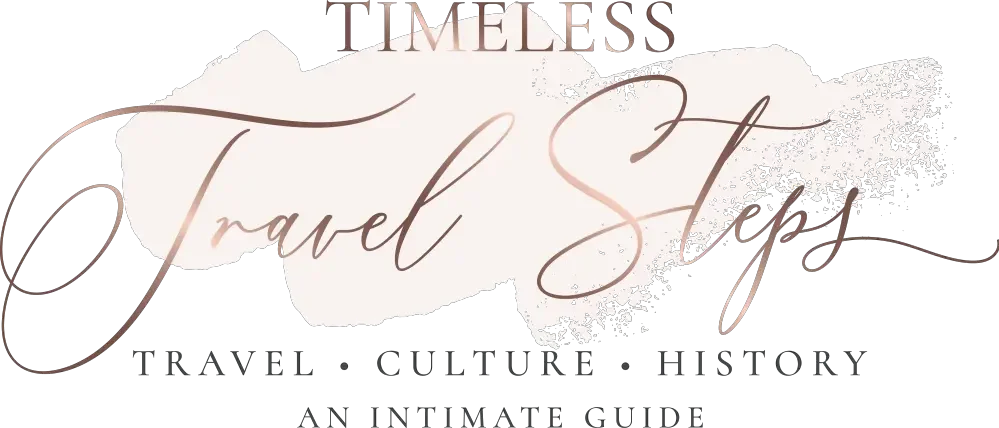
Westminster Abbey, Henry VII Lady Chapel + Visiting Guide
Westminster Abbey, and the Henry VII Lady Chapel are not just London’s top attractions , but also a monumental piece of British history and culture . Westminster Abbey is particularly famous for its rich history and impeccable Gothic architecture, which makes it worth visiting. Founded in 960 AD, Westminster Abbey is a Royal Peculiar that falls directly under the authority of the monarch. As a UNESCO World Heritage Site, it stands as one of the most significant landmarks in England .
For over a thousand years, this magnificent Gothic church has stood witness to some of the most significant events in the nation’s history, from royal coronations of William the Conqueror in 1066, and the wedding of Prince William to Catherine Middleton in 2011, to the burials of 18 monarchs and over 3,300 renowned scientists, writers, and prominent figures.
Although I had visited Westminster Abbey and Lady Chapel a few times before, I recently visited again because I was fascinated to learn more about the Queen’s Diamond Jubilee Galleries, which I hadn’t visited. This visit allowed me to see the Abbey from a fresh perspective, deepening my appreciation for areas like the Choir Screen, Poet’s Corner and especially the Lady Chapel which is often not written about.
In this post, I’ll provide you with all the essential tips you need to make the most of your visit. You’ll find practical information on ticket prices and the best times to visit, ensuring you can plan your trip efficiently and avoid the crowds. I will guide you through the must-see highlights within the Abbey, with a special focus on the Henry VII Lady Chapel, renowned for its stunning beauty and historical significance.
Whether it’s your first time or a return visit, this guide will help you uncover the rich tapestry of history and culture woven into the very fabric of this extraordinary place.
Timeless Travel Steps is supported by our readers. If you purchase through an affiliate link on my site, at no cost to you, I may earn a commission from qualifying purchases. Please read our Disclosure for further information.

Westminster Abbey, London
Westminster Abbey dates back to 960 AD, when a Benedictine monastery was established on the site by Saint Dunstan and King Edgar the Peaceful. This early foundation marks the beginning of continuous religious activity at Westminster.
King Edward the Confessor significantly rebuilt and expanded the Abbey, beginning around 1045. He constructed a grand Romanesque church dedicated to St. Peter, which was consecrated in 1065, shortly before his death. This rebuilding laid the groundwork for the Abbey’s development into a major religious center, ultimately becoming the site of royal coronations and burials.

Essential Tips for Visiting Westminster Abbey and Lady Chapel
Hours, ticket information, and guided tour.
Hours: Westminster Abbey opens at 9:30 am from Monday to Friday, with the last entry at 3:30 pm and at 9:00 am on Saturdays, with the last entry at 3:00 pm.
Ticket Information and Online Purchases: To visit Westminster Abbey, you’ll need to purchase a ticket. Tickets are available for adults, children (6-17), and are free for children 5 and under. For those who are 65+ and for students, you pay a reduced price. The Queen’s Diamond Jubilee Galleries require an additional £5 (free for children 17 and under). Buy tickets online to skip the ticket lines and get quicker entry or purchase a London Pass .
Even if you have pre-booked tickets online, expect a small queue due to high demand.
Opt for a guided tour led by the Abbey’s vergers. This is an informative tour, that takes you to areas not usually open to visitors and information not usually found in any guide books. The duration is 90 minutes, and you can only book this on the day of your visit.
Always check the official website for any changes in opening hours due to special services or events.
When is the Best Time to Visit Westminster Abbey and Lady Chapel
The Best Times to Visit Westminster Abbey and Lady Chapel to avoid crowds varies from first thing in the morning and after lunch. Aim to arrive at opening time before the crowd begins to arrive at 10:00 am onwards. Alternatively, visit around 2:30 pm after the peak hours of 11 am to 2 pm. Avoid school holidays, if at all possible, as this is a peak season for tourists.
How Long do you need at Westminster Abbey and Henry VII Lady Chapel
If you’re wondering how much time you need at Westminster Abbey , I’d suggest that realistically, you should set aside at least 2 to 3.5 hours . This includes a visit to the Queen’s Diamond Jubilee Galleries, which can take between 45 minutes to an hour. You certainly need to add extra time if visiting during peak times. I spent about 4+ hours and thoroughly enjoyed my exploration even though it was really busy on the day I visited.
Dress Code, Bag Policy and Photography at Westminster Abbey
Dress Code: As in any place of worship, Westminster Abbey has a dress code also. Dress conservatively, with shoulders covered, no mini skirts or short short shorts. Remove hats inside the Abbey.
Westminster Abbey’s Bag Policy states that for safety and comfort, large backpacks and suitcases are not permitted. There are no storage facilities, so plan to leave these items elsewhere.
Photography is restricted inside the Abbey. No photography at all is allowed in the Queen’s Diamond Jubilee Galleries

PRO TIP: If you choose to explore Westminster Abbey on your own, an established walking route is available to guide you. Collect an audio guide in your chosen language at the main entry point. The audio guide covers all the key highlights, with each highlight numbered along the route. except for the exterior of the church. There’s signage and helpful guides throughout the Abbey to help direct you along the path.
Westminster Abbey, Henry VII Lady Chapel Highlights: What Not to Miss at Westminster Abbey
Upon arriving at Westminster Abbey, head towards the Great North Door entrance, where you’ll pass through security checks before entering the Abbey. Inside, Westminster Abbey is a treasure trove of history, architecture, and culture, offering you a journey through over a thousand years of British heritage. Here’s a walkthrough of the must-see highlights:
The Queen’s Window
Upon entering through the Great North Door, you’ll be awestruck by the extraordinary architecture inside the Abbey. Start by admiring the stunning Queen’s Window, a recent addition in 2018, made with traditional hand-blowing technique. Designed by artist David Hockney, the window features vibrant colours and modern designs, portraying a vivid rural landscape that contrasts beautifully with the Gothic architecture.
The Grave of the Unknown Warrior
As you proceed down the aisle, you will come across the Grave of the Unknown Warrior, whose body was brought from France to be buried here on 11th November 1920. The grave, containing soil from France, is covered by a slab of black Belgian marble sourced from a quarry near Namur. Surrounded by poppies, this poignant memorial remains untouched by any visitor’s foot and honours the countless soldiers who lost their lives in World War I.

The Coronation Chair
As you move towards the Great West Door, which also serves as the exit, you will encounter the iconic Coronation Chair, encased in a glass cube, with further reinforced protection. This historic artefact has played a central role in the coronation of English and British monarchs since it was commissioned by King Edward I in 1296. It has been used in the coronation ceremonies of 39 English and British monarchs, including, most recently, the coronation of King Charles III.
Originally crafted to sit on the Stone of Scone—a symbol of Scottish kingship taken by Edward as a spoil of war—the chair represents the unification of England and Scotland under a single monarch. The Stone of Scone, also known as the Stone of Destiny, was returned to Scotland in 1996, but the Coronation Chair remains an enduring symbol of continuity and tradition.
During coronation, the chair is placed in front of the High Altar on the Cosmati Pavement, adding to its historical and spiritual significance.
The Nave and Renowned Graves
I was utterly captivated at this point in my visit to Westminster Abbey and Lady Chapel. The grandeur of the imposing Nave, that spans the length of the Abbey, is an architectural marvel and truly a jaw-dropping sight!
The Nave of Westminster Abbey is a breathtaking example of Gothic architecture, stretching impressively from the Great West Door to the choir screen. Its design features soaring, pointed arches supported by slender, intricately carved pillars that create a sense of verticality and lightness. The Nave’s vaulted ceiling is unique. Ribbed and complex, drawing the eye upwards and enhancing the sense of grandeur.
Natural light floods the Nave through large, ornate stained glass windows that line the upper walls. These windows, depict various biblical scenes and figures, illuminating the interior with colourful light and depth to the space.
You can easily miss what lies beneath these arches. Look down and you’ll notice the floor of the Nave is lined with memorials and graves, including those of notable figures such as Sir Isaac Newton, Charles Darwin, and Stephen Hawking, making it a place of significant historical importance.

The Crossing in Westminster Abbey
The Crossing in Westminster Abbey is the central area where the Nave, transepts, and Quire intersect. When you are at this pivotal space, look up for a stunning fan-vaulted ceiling supported by massive stone pillars, exemplifying the Gothic architecture this Abbey is known for. This space serves as a hub for movement within the Abbey, connecting key areas and enhances the flow of processions and ceremonies.
The Choir Screen
The Choir Screen in Westminster Abbey is an ornate, intricately designed barrier that separates the Nave from the Quire. The screen features statues of ten monarchs, including those of King George V and Queen Mary, which were added in the 20th century by sculptor Sir William Goscombe John.
The Quire at Westminster Abbey
Step beyond the Choir Screen and visit the Quire. The Quire is a beautifully ornate section of Westminster Abbey where the choir performs during services, providing a captivating glimpse into the Abbey’s rich musical heritage. The Quire is adorned with intricately carved wooden stalls and elegant fittings, with specific seating plan as to who sits where.

High Altar and Cosmati Pavement
Moving ahead from the Quire, you will find the High Altar, the spiritual focal point of the Abbey. The High Altar is distinguished by its ornate screen and the magnificent reredos behind it, which features intricate carvings and religious iconography. The altar is used for major religious ceremonies and is a key element of the Abbey’s religious life.
In front of the High Altar lies the Cosmati Pavement, a stunning mosaic floor from medieval times, commissioned by Henry III in 1268. This intricate flooring was created by a Roman craftsman. Composed of coloured glass, stone, and precious materials set into a framework of Purbeck marble, in a geometric pattern said to represent the universe.

TIP: Follow the media or numbered guide from the High Altar, which will lead you towards your left, on a clockwise route. This path will take you past the Shrine of St. Edward the Confessor, one of the most sacred sites in the Abbey. Continuing on, you’ll encounter the tombs of Henry III and Henry V, each reflecting their historical significance and royal heritage. The route then guides you to the tombs of Elizabeth I and Mary I, where you can reflect on these two monarchs’ fascinating and turbulent history.
Edward the Confessor’s Chapel
St. Edward the Confessor’s Chapel, is a sacred and historically significant part of the Abbey. The chapel was built to house the remains of King Edward the Confessor, who reigned from 1042 to 1066 and was canonized as a saint in 1161 due to his deep religious devotion and piety.
His shrine, an elaborate structure made of Purbeck marble, is surrounded by steps to allow pilgrims to approach closely, but this area is sometimes closed off during peak times. Edward’s reign marked the end of the Anglo-Saxon era, and his death without an heir led to the succession crisis and the Norman Conquest.
READ: The Battle of Hastings 1066: A Synopsis.
The Henry VII Lady Chapel at Westminster Abbey
The Lady Chapel , also known as the Henry VII Chapel, is situated at the far east end of Westminster Abbey, beyond the High Altar and the Sanctuary, aligning with traditional designs, where the most sacred parts of the church are positioned at its easternmost point.
The Lady Chapel at Westminster Abbey was built between 1503 and 1516 by King Henry VII. It was designed by the architect Sir Reginald Bray. The chapel is dedicated to the Virgin Mary and serves as the burial site for notable figures. There are about 15 tombs in the Chapel including Henry VII, Elizabeth of York, Mary, Queen of Scots and, Elizabeth I.
As you ascend the steps flanked by the standards of the Knights of the Order of the Bath, the grandeur of the chapel immediately unfolds before you. With the banners of the knights above you, bright and airy, the intricate fan-vaulted ceiling, the chapel, elaborate tombs, and stunning stained glass windows create a breathtaking first impression, adding a somewhat ceremonial element to your visit. It’s like a hidden gem within the wider splendour of the Abbey. A truly magnificent setting, one that is worth experiencing. Here are some of the important tombs not to miss:

The Tombs of Elizabeth I and Mary I in the North Aisle of the Lady Chapel
As you head clockwise as per the guide, you’ll be guided to the left side of the Lady Chapel. It is a serene and dignified space, featuring intricate Gothic architecture and decorative elements.
The tomb of Elizabeth I is an elaborate monument with a white marble effigy of the queen lying in state. The effigy is adorned with her royal insignia, including a scepter and an orb, symbolizing her authority and sovereignty. The orb is adorned with the Tudor rose, representing her father’s House of Tudor, while the scepter bears the symbols associated with her mother, Anne Boleyn. The tomb is richly decorated emphasizing her legacy as one of England’s most significant monarchs.
Mary I’s tomb is less ornate than that of Elizabeth I, but it is equally significant. The two tombs are positioned side by side, symbolizing their connection and the complex history between them.

About Mary I and Elizabeth I
Elizabeth I and Mary I were half-sisters, both daughters of Henry VIII, but they had different mothers—Anne Boleyn and Catherine of Aragon, respectively. Elizabeth I and Mary I were not particularly close growing up. Despite their strained relationship in life, were united in death, as their tombs lie side by side in the North Aisle of the Lady Chapel at Westminster Abbey.
Mary I ruled England and Ireland from 1553 to 1558, but she did not rule over Scotland, so she did not rule Britain in its entirety. Her reign is particularly noted for her attempts to restore Roman Catholicism in England, earning her the nickname “Bloody Mary” due to the persecution of Protestants.
The Sword of King George VI
The sword, encased in protected glass at the entrance of the Lady Chapel in Westminster Abbey is the Sword of King George VI . It was presented to the Abbey by Queen Elizabeth II in 1952 in memory of her father, King George VI. The sword is displayed as a symbol of bravery and service, particularly honouring the role of the Royal Air Force during World War II.
Oliver Cromwell at The Lady Chapel
On the floor, in front of the altar of the Lady Chapel at Westminster Abbey, lies a plaque dedicated to Oliver Cromwell. Cromwell, a key figure in the English Civil War and the subsequent establishment of the Commonwealth, was initially buried with great honour in the Abbey following his death in 1658.
However, after the Restoration of the monarchy in 1660, Cromwell’s body was exhumed and subjected to posthumous execution. The plaque marks the location of his original burial site.
After his body was exhumed and subjected to a posthumous execution in 1661, Oliver Cromwell’s remains were buried in an unmarked grave at Tyburn, near present-day Marble Arch in London. His head was placed on a spike above Westminster Hall, where it remained for many years before eventually being buried in the grounds of Sidney Sussex College, Cambridge.

Mary, Queen of Scots at The Lady Chapel
Mary, Queen of Scots, ruled Scotland from 1542 to 1567 and was a significant historical figure whose life was marked by political and personal challenges. Seeking refuge in England, she was imprisoned by her cousin, Queen Elizabeth I, for 19 years. In 1587, Mary was executed for her alleged involvement in plots to assassinate Elizabeth and claim the English throne.
Initially buried at Peterborough Cathedral, her remains were exhumed in 1612 by her son, King James I of England (James VI of Scotland), and reinterred in the Lady Chapel at Westminster Abbey.
Mary’s tomb in the Lady Chapel is an elaborate structure. You’ll find her tomb slightly raised compared to the others. James I wanted it this way to underscore her royal lineage and the high regard in which he held his mother.
Tombs of Kings and Queens
Alongside Mary, Queen of Scots, you’ll find the following prominents tombs also:
The tombs of Henry VII and Elizabeth of York , the founders of the Tudor dynasty, are buried in a magnificent central tomb.
Margaret Beaufort, Mother of Henry VII and a key figure in establishing the Tudor dynasty, is also in this room, next to his son.
James I (James VI of Scotland), Son of Mary, Queen of Scots, is buried near his mother’s tomb. Anne of Denmark, the wife of James I, also laid to rest next to him.
At the far end of the room, there are two notable tombs:
The tomb of Edward VI, the only legitimate son of Henry VIII, who reigned from 1547 to 1553. His tomb is relatively modest compared to those of other monarchs.
The tomb of Margaret Douglas, Countess of Lennox, who was the daughter of Margaret Tudor (Henry VIII’s sister) and mother of Henry Stuart, Lord Darnley, who was the husband of Mary, Queen of Scots and father of James I (James VI of Scotland).
Innocents’ Corner
Innocents’ Corner in Westminster Abbey is a poignant space dedicated to the memory of children who have passed away. Here, you’ll find a shrine for the bones found in the Tower of London . These bones are believed to be those of the young “Princes in the Tower,” Prince Edward V and his younger brother Richard, Duke of York, sons of King Edward IV, who disappeared in 1483.
Their remains were discovered in 1674 during construction at the Tower and re-examined in 1933 before being interred in Westminster Abbey. The mysterious disappearance and presumed murder of the princes remain subjects of historical intrigue.
Royal Air Force Chapel
The Royal Air Force Chapel is located within Lady Chapel in Westminster Abbey. It commemorates those who served and died in the Royal Air Force during World War II. The chapel features stained glass windows depicting scenes from the Battle of Britain and other significant moments in RAF history.
READ: The Best of Battle Abbey, East Sussex.

The Poet’s Corner
From the Lady Chapel, head towards the Poet’s Corner. This space, located in the South Transept of Westminster Abbey, is renowned as the burial and memorial site for many of Britain’s most distinguished literary figures. It began with the burial of Geoffrey Chaucer in 1400 and expanded to include other notable writers such as Edmund Spenser, Ben Jonson, and Charles Dickens. Memorials honour those buried elsewhere, like William Shakespeare and Jane Austen.
This is an area where you can spend some time locating your favourite authors, such as Lord Byron or T.S. Eliot. This area also offers access to the Jubilee Galleries.

Queen’s Diamond Jubilee Galleries
The Queen’s Diamond Jubilee Galleries, located high above the Abbey floor in the eastern triforium of Westminster Abbey, were opened to the public for the first time in June 2018. Access to the Queen’s Diamond Jubilee Galleries is either by a staircase of 108 steps or by elevator, making it accessible to most visitors.
Once at the top, you are rewarded with a jaw-dropping view of the entire length of the Abbey’s Nave, looking down from about 70 feet above, and get a unique view of the Cosmati Pavement and the High Altar. The vantage point also provides spectacular views of nearby landmarks such as the Palace of Westminster and Big Ben through the Abbey’s ancient windows.
The space itself is a marvel of medieval architecture, with its original 13th-century vaulted ceilings and stonework carefully restored and preserved.
Highlights of the Queen’s Diamond Jubilee Galleries’ Exhibits
Strictly no photography allowed here, but here are some of the highlights in the exhibition:
1. One of the most significant artefacts on display is the Coronation Chair of Queen Mary II . This chair was specially made for her coronation alongside her husband, William III, in 1689. It is a rare and fascinating piece of history, providing insight into the coronation traditions of the time.
2. Dating back to the late 14th century, the Litlyngton Missal is an illuminated manuscript that was used in the daily services of the Abbey. It is named after Abbot Nicholas Litlyngton, who commissioned it, and is renowned for its beautiful illustrations and detailed craftsmanship.
3. The Galleries house several important Anglo-Saxon charters , including the original charter of King Offa of Mercia, dating from the 8th century. These documents are crucial to understanding the early history of the Abbey and the region.
4. One of the oldest surviving altarpieces in England, the Westminster Retable, dating from around 1260, is displayed in the Galleries. It features intricate carvings and paintings depicting scenes from the life of Christ, showcasing the exceptional artistic skills of medieval craftsmen.
5. The collection includes various rare texts and manuscripts, providing a deep dive into the Abbey’s literary and historical archives.
6. Other exhibits include the Marriage Licence of Prince William and Catherine Middleton; funeral effigy of Horatio Nelson (buried in St Paul’s Cathedral ), a Lady in a Wimple, and display cases which you can open to explore.
Beyond Westminster Abbey and The Lady Chapel: The Cloisters, Chapter House, Pyx Chamber, St Katherine’s Chapel, and College Garden
After exploring the main areas of Westminster Abbey and the magnificent Henry VII Lady Chapel, there are several other notable sections within the Abbey grounds that are worth exploring. These include the Cloisters, the Chapter House, the Pyx Chamber, St. Katherine’s Chapel, and College Garden.

The Cloisters
The Cloisters are a quadrangular covered walkway that encloses a central courtyard, historically used by the monks of Westminster Abbey for meditation and exercise. Today, the Cloisters provide a serene atmosphere featuring Gothic arches and vaulted ceilings, along with places to sit. Tombs of significant historical figures are located along the Cloisters, offering a walk through history.
The Chapter House
The Chapter House is a quiet delight! One of the oldest and most architecturally impressive parts of Westminster Abbey, the Chapter House was built in the 13th century and served as a meeting place for the monks. It was here that the early parliaments of England gathered. The room is octagonal, features stunning stained glass windows and a beautifully decorated ceiling with a central column branching out like a palm tree.
What I really enjoyed discovering at the Chapter House was the Wall Paintings. The Chapter House walls are adorned with 14th century medieval paintings that depict biblical scenes. Though hazy and faded with age, still conveys a rich artistic heritage.
The Oldest Door in Britain
The oldest door in Britain is located in Westminster Abbey. This significant historical artefact is situated in the corridor leading to the Chapter House. This ancient door, dating back to early medieval around 1050, is made of oak and is believed to be the oldest still in use in the country.
The Pyx Chamber
The Pyx Chamber, dating back to around 1070, is one of the oldest surviving parts of Westminster Abbey. It was originally used as a treasury and later as a sacristy. It housed the Pyx, the box used to store the king’s gold and silver, which was used in coinage trials.
The chamber is characterized by its thick stone walls and sturdy oak doors from the 14th century, highlighting the medieval architecture and security measures of the time.
READ: A Historical Overview, and Essential Tips about the Chapter House, Pyx Chamber and Cloisters at Westminster Abbey, London.
St. Katherine’s Chapel
St. Katherine’s Chapel, also known as the Little Cloister, has a history dating back to the medieval period, and offers a tranquil and reflective space within the Abbey grounds.
College Garden
One of the oldest gardens in England, dates back over 900 years and was originally used by the Benedictine monks of Westminster Abbey. The monks cultivated medicinal herbs and food plants here. Today, College Garden is a beautiful and peaceful green space that features a variety of plants, flowers, and trees, making it a delightful spot for nature lovers.

The Exterior and West Towers at Westminster Abbey
The Exterior of Westminster Abbey is highlighted by its magnificent Gothic Revival West Towers, completed in the mid-18th century. Some highlights to look out for:
Above the Great West Door of Westminster Abbey , you’ll find ten statues of 20th-century Christian martyrs. These include notable figures such as Martin Luther King Jr., Oscar Romero, and Dietrich Bonhoeffer, who were chosen to represent various denominations and parts of the world. These statues were unveiled in 1998 and serve as a powerful reminder of the sacrifices made for faith and justice.
The Clock at Westminster Abbey is situated above the North Transept. Installed in 1738 by clockmaker John Seddon, it features a single large hand to mark the hours, following the traditional clock design of the period.
The two Western Towers of Westminster Abbey were completed in the mid-18th century by Nicholas Hawksmoor, a pupil of Sir Christopher Wren. These Gothic Revival towers, made from Portland stone, add a majestic touch to the Abbey’s facade and house the Abbey’s ten bells, which are rung on various ceremonial occasions.
In sum…
Westminster Abbey and the Henry VII Lady Chapel are truly remarkable sites, and I hope this guide has given you all the information you are looking for. To ensure you make the most of your visit, remember to book your tickets in advance online. Not only does this help you avoid long queues, but it also guarantees entry, as the Abbey can be very busy, and tickets may not be available on the day, especially during peak tourist seasons.
For those looking to save on admission costs, consider purchasing the London Pass, which includes entry to Westminster Abbey along with many other top attractions in the city. Various other bundles and discount options may be available, so be sure to explore all your choices to find the best deal.
Before you go, take a look at some of the following most read posts about London:
Free Things to do near Chancery Lane, London.
Off-Beat, Free, & Ticketed Things to do in Greenwich, London + Tips.
Famous Food in London: Best Classic British Dishes you Must Try.
12 Famous Parks in London.
The Serenity of St Dunstan-in-the-Fields, London.
For all articles about London, head to Charming City London.
Happy and Safe Travels Always, Wherever Travel Takes You, xx
For more travel insights and tips, consider following Georgina on Instagram and Facebook . Don’t miss out on her latest adventures and expert advice . Subscribe to stay updated and join a community of fellow travel enthusiasts eager to explore the world through Georgina’s eyes.
Is this article helpful? If so, please share it with friends and family. Pin It to Pinterest to read later.

Introducing Georgina, the insightful Content Creator behind Timeless Travel Steps. A champion of off-season journeys and cultural immersion for the mature traveller, Georgina has explored 4 continents and over 30 countries. Her blog offers practical tips and personal insights into responsible, comfort-oriented travel along with slow travel destinations. Accompanied by classical, country, and jazz tunes, Georgina's solo adventures and time with her adult children, A & M, enrich her unique travel narrative. Join her for inspiring, immersive global explorations.
Similar Posts

Leadenhall Market: London’s Best Kept Secret

8 Quirky Ideas to Experience at Christmas in London

Guided Tours for Top 10 Experiences in London

21 Best Castles in Southern England to Visit from London [2024] + Map

Discover London with Georgina

Christmas in London Magical Ice Skating Rinks
The 5 Best Westminster Abbey Tours [2024 Reviews]
In a place that’s dripping in history from every cobblestone and vine-covered building, there stands a breathtaking cathedral we know as Westminster Abbey. If these walls could talk, we’d hear stories covering centuries of dramas, war, love, and much more.
This breathing time capsule is one of the most captivating places in the world, and with these carefully curated tours you’ll get a backstage pass to the secrets and stories that make it so special.
The top tours of Westminster Abbey are much more than just sightseeing – you’ll have a local expert take you through an incredible journey to learn things you simply can’t in a history book. Let’s jump right in!
Best Westminster Abbey Guided Tours
Quick answer: the 5 best rated westminster abbey tours for 2024.
- London Guided Tour of Houses of Parliament & Westminster
- Private Tour London Highlights, entries Westminster Abbey, The Tower of London
- Westminster Abbey Tour & Big Ben Exterior
- Priority Access Tour of Westminster Abbey with London Eye Option
- Guided Tour of London Westminster Abbey, Big Ben, Buckingham
Westminster Abbey Tour Reviews
1. skip the line into houses of parliament & westminster abbey fully-guided tour.
- Duration: 4 hours
- Departure: “Winston Churchill” statue, Parliament Square, Westminster, London
- Departure Time: 9:00 AM & 1:30 PM
- Includes: Entrance to Westminster Abbey and Houses of Parliament, fully-guided tour inside both, headsets, small groups
Even if you aren’t particularly interested in British history, I can’t recommend going on this tour enough. The London Guided Tour of Houses of Parliament & Westminster Tour is fascinating, from the hallowed halls of the Abbey to the sacred ground where Royal Coronations have unfolded since 1066.
You may know it from the fairytale-like wedding of Prince William and Kate Middleton, but it’s so much more than that. With various start times available, this tour is also very easy to fit in to any schedule and it starts off by venturing into the belly of the beast: The Houses of Parliament.
Now, I know what you’re thinking – “parliament, really?”, but trust me, this is no ordinary stroll. You’re ditching the soulless audioguide for a friendly Blue Badge tour guide who’s practically a walking encyclopedia of British democracy.
We’ll start in the Chamber of the House of Commons, where the folks with the power to make or break Britain gather and where you’ll learn about the important decisions that are made here.
Then, we’ll cruise on over to the chamber of the House of Lords, where the bluest bloodlines in the country used to sit back and make decisions that shaped a kingdom (and world, consequently).
Our tour guide did a great job explaining some of the most important events here, in a way that was not only very educational, but also very amusing.
Even though many of the rooms didn’t allow for us to take photos, his teachings and storytelling made such an impact that the memories will stay in our minds for a long time.
Overall, this is a tour that’s as entertaining as it is informative, leaving you with a whole new perspective on London and England, as a whole.
Tour Information & Booking
100% refund for cancellations within 24 hours of tour experience, other experiences you may enjoy:, 2. private tour london highlights, entries westminster abbey, the tower of london.
- Duration: 8 hours
- Departure: Broad Sanctuary, London SW1
- Departure Time: 9:00 AM
- Includes: Private tour, Blue Badge guide, skips the long lines
This next tour is the most comprehensive of the bunch, so if you’re looking to dive deep into England’s history, you’re in good hands. From the most sophisticated royals to the most brutal tales of torture, this tour will take you on a whirlwind experience full of excitement.
The Private Tour London Highlights, Entries Westminster Abbey, The Tower of London adventure is perfect if it’s your first time in this incredible city.
Make your way to the Broad Sanctuary around 9:00 am and meet your guide, who will provide a briefing to the group of what to expect for the day. They did a great job at customizing the tour to fit our specific interests.
The first stop for the day is Trafalgar Square, where you’ll learn about the important protests here, see Nelsons Column, and more.
Stroll on over to Whitehall to see where the PM lives and works and see various war memorials before going to Westminster Abbey. Once there, you’ll learn all about the important events that have taken place at the beautiful church, including the centuries-old chair used for coronations.
The famous Buckingham Palace is up next, which was the Royal Residence of the Queen before her passing. Next is St. James Park, where you’ll learn even more about the Royal Family and get a chance to breathe some fresh air and soak in all of the experience, so far.
Parliament Square is one of my favorite London stops. You’ll be surrounded by views of Big Ben, Houses of Parliament, and will even get to ride either the double-decker red bus or tube through the glitzy financial district.
St. Paul’s Cathedral and the Tower of London are next, with plenty of crazy stories about both locations narrated to you before enjoying some delicious fish and chips in a local pub. Finally, take some photos at the Tower Bridge, where you’ll get to take a rest or continue venturing throughout the city.
3. Westminster Abbey Tour & Big Ben Exterior
- Duration: 2.5 hours
- Departure: The Supreme Court, Parliament Sq, London
- Departure Time: 10:30 AM
- Includes: Entrance fees to Westminster Abbey, Blue Badge guides
Perhaps you’re looking to explore more of London, but don’t have the schedule available for a full-day tour. This next adventure is the perfect alternative, with plenty of start times available for you.
The Westminster Abbey Tour & Big Ben Exterior has an expert guide to take you through some of the most interesting spots in the city!
If you’re traveling with children, I can’t recommend this tour enough. The guide was so captivating and entertaining, and the tour was just the right length of time that none of the smaller ones became impatient and actually had a lot of fun!
Start out by meeting your guide at the Supreme Court located in Parliament Square, where you’ll get to see the iconic Big Ben from the exterior. Learn all about Big Ben, like how it’s the world’s biggest 4-faced clock, and how even during WWII, the chimes continued to sound and the clock face wasn’t blacked out to keep a sense of normalcy.
It’s a prime example of Victorian Engineering, maintaining itself as one of the most iconic symbols of both London and the United Kingdom. Should you have any questions or comments, your guide is there to answer and expand on them for you.
Next up is the amazing Westminster Abbey, which is one of the most remarkable historical landmarks, with a rich past filled with a spectrum of emotions and events.
Royal coronations and weddings have taken place here, and you’ll even get to see the Coronation Chair dating back to 1300! Thanks to the small group size, everyone will have enough time to tour through while also getting some free time to explore at your own leisure.
4. Priority Access Tour of Westminster Abbey with London Eye Option
- Duration: Approximately 2 hours
- Departure: Westminster Abbey Shop, 20 Dean’s Yard, London
- Includes: Priority access to Westminster Abbey, tour with live guide, max of 20 passengers, coffee and pastries, optional Fast Track London Eye ticket
This is another quick yet comprehensive London tour which I feel perfectly balances the ultra-popular tourist sights with the more “local” feel.
The Priority Access Tour of Westminster Abbey with London Eye Option is a great activity to take on your own, with the entire family, or with your significant other. Even if your schedule is packed to the brim, you should be able to fit this one in easily.
Starting off meeting your guide at Westminster Abbey, you’ll head inside the living monument of kings and queens with your small group. The guide did a fantastic job at regaling us with tales from over a millennium of English history, from 40 coronations, and dazzling weddings.
There are many recent events that have taken place here, such as the recent coronation of Charles III, the marriage of William and Kate, and the state funeral of Queen Elizabeth II.
After the thrilling and educational tour of the Abbey, you’ll descend into the medieval Cellarium, where Benedictine monks once stored their provisions. Today, it’s a slightly more lighthearted locale: a restaurant that serves up tasty food and beverages.
Enjoy some complimentary coffee and pastries in this 14th-century spot through the cloister, while you chat about the events so far.
After the tour, you have the option of soaring sky-high on the iconic London Eye ferris wheel! If you aren’t scared of heights, I really recommend taking advantage of this opportunity as it offers some of the best views of the city out there. You’ll even get to avoid the queues with your included fast track ticket!
5. Guided Tour of London Westminster Abbey, Big Ben, Buckingham
- Departure: Parliament Square, Parliament Sq, London
- Includes: Guided tour of Westminster Abbey and City of Westminster, 5-star licensed guide, skip-the-line to Westminster Abbey, walking tour of the city of Westminster, group tour max 20 people
Last but certainly not least, we have the Guided Tour of London Westminster Abbey, Big Ben, Buckingham experience. This 4-hour excursion is a great way to get out of the hotel and learn about the varied and dramatic history of this capital city.
Learn about the intricate and varied architecture, the British royal family, politicians, and other important figures and monuments from an expert guide.
The tours usually start out in the morning, so head out early to meet your guide at the Sir Winston Churchill Statue in Parliament Square before going inside the depths of the Westminster Abbey.
While you can’t typically take photos inside, this is an amazing experience with history and beauty at every turn. There’s certainly a ton to see here, but my personal favorites were the Coronation Chair, Poets’ Corner, and the Lady Chapel.
With convenient skip-the-line tickets, you don’t have to worry about waiting in a queue and can simply head right in. The stunning Gothic nave, royal chapels, and so much more awaits you!
The guide does a fantastic job at giving the group little gems of information that I’d never heard anywhere else, further enriching the experience for us.
Next up is the Palace of Westminster with the famous Big Ben clocktower, where you’ll learn about the history of the monument that’s made appearances in countless movies, TV shows, and other media.
Then, head on over to Buckingham Palace where you’ll get to see some of the most famous royal rooms and hear intriguing tales about various royals.
FAQs About Westminster Abbey Tours
What is westminster abbey.
Westminster Abbey is the most historic church in England. It is not only a church but there are celebrations and ceremonies for the British royal family. Westminster Abbey was built in the 960s as a Benedictine monastery and has been the site of every Royal coronation since 1066.
What will I see in Westminster Abbey?
The Nave , this is the main part of the church where you enter. You will see the grave of the Unknown Warrior, who represents all the soldiers who died in World War I. You will see the memorials of famous people like Winston Churchill, William Shakespeare and Martin Luther King Jr.
The Coronation Chair , is located in the nave. This is the chair that has been used for every royal coronation since 1308. You will also see the Stone of Scone which is a symbol of Scottish royalty under the seat of the chair.
The Poets’ Corner , which is located in the south transept. This is where many writers and poets are buried and commemorated, such as Geoffrey Chaucer, Charles Dickens, Jane Austen, and C.S. Lewis.
The Lady Chapel , which is in the eastern part of the church. Most people consider this the most beautiful part of Westminster Abbey with the fan-vaulted ceiling, carvings and stained glass windows.
The Royal Tombs , are in various chapels in the church. There are tombs of famous and influential monarchs like Edward the Confessor, Henry III, Henry V, Henry VII, Edward VI, Elizabeth of York and George II.
The Pyx Chamber , is located off the east cloister. This medieval vaulted room was used to store the royal treasury and the standard weights and measures. You will see some of the original chests and iron bars that were used to secure the valuables.
The Chapter House , is located in the east cloister. This circular room that was used for meetings by the monks and later by the Parliament. There are some of the oldest wall paintings in England that depict scenes from the Bible and the Apocalypse.
The Cloisters , which you can get to from the Dean’s Yard. These covered walkways surround the central courtyard are some of the oldest parts of the Abbey with many memorials and monuments.
The Queen’s Diamond Jubilee Galleries , which are in the medieval triforium above the Nave. These new galleries opened in 2018 to celebrate Queen Elizabeth II’s 60 years as the Queen.
How long do I need to see Westminster Abbey?
You can see most of the Abbey in 1.5 to 2 hours. It really depends on if you want to see all of it and how long you linger in the various areas.
How much does it cost to see Westminster Abbey?
An adult ticket is $30 which allows you to see all of the main attractions of the Abbey, like the nave, the tombs, Poet’s Corner, the Lady Chapel, and the Queen’s Diamond Jubilee Galleries.
Do I need a guided tour of Westminster Abbey?
While you do not need a guided tour, having a tour guide will provide you with more insights and insider information about the history of the Abbey. You will also be able to access to some areas that are not open to general visitors.
Tour Guides
The London Guided Tour of Houses of Parliament & Westminster is our Editors Choice for the best Westminster Abbey tour.
Robert Baker
Related articles, the 5 best stonehenge tours from london [2024 reviews], 🍷 the 5 best florence wine tours [2024 reviews], the 7 best vatican tours ⛪ [2024 reviews], the 5 best seine river dinner cruises [2024 reviews].
- Top Destinations
- Mexico City, Mexico
- Tokyo, Japan
- Paris, France
- Rome, Italy
- London, United Kingdom
- All Destinations
- Upcoming Experiences
- Private Walking Tours
- Small-Group Tours
- Tours for Kids
- Museum Tours
- Food, Wine and Market Tours
- Newly Added Tours
- Audio Guides
- Pre-Trip Lectures
- Admin Dashboard
- My Experiences
- My Favorites
- Cookies Preferences
- Client Orders
- Monthly Commissions
- My Advisor Profile
- Advisor Toolkit
- Guide Dashboard
Credit Balance
Transactions are based on current exchange rates and performed in USD. There maybe slight variations in the price estimates.
Westminster Abbey Tour with Skip-the-Line Tickets

- Walking the path of grand royal coronations and storied weddings, you'll seamlessly weave into the rich tapestry of British history that comes alive within these hallowed halls.
- Experience a journey through time with your Context guide, whose unmatched expertise and profound insights guarantee an enthralling and enlightening tour.

- You prefer a comprehensive experience over a quick visit, ensuring you don't miss the Abbey's hidden gems.
- You're intrigued by the idea of visiting the final resting places of poets, scientists, statesmen, and monarchs who shaped British history.
- Tour cost includes timed skip-the-line access tickets to Westminster Abbey
- Our skip-the-line tickets will get us to a special lane where our group will have to stand in line due to security and crowd control measures.
- If you are looking to learn more about London prior to a visit, check out our Online Lectures and Audio Guides.
- Additional information about accessibility at the abbey is available here.
Reviews can only be left by Context customers after they have completed a tour. For more information about our reviews, please see our FAQ .
You May Also Like
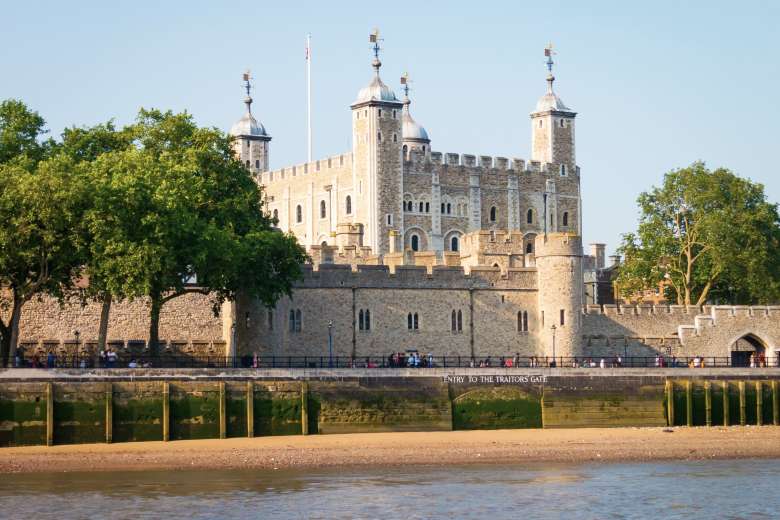
Tower of London Tour
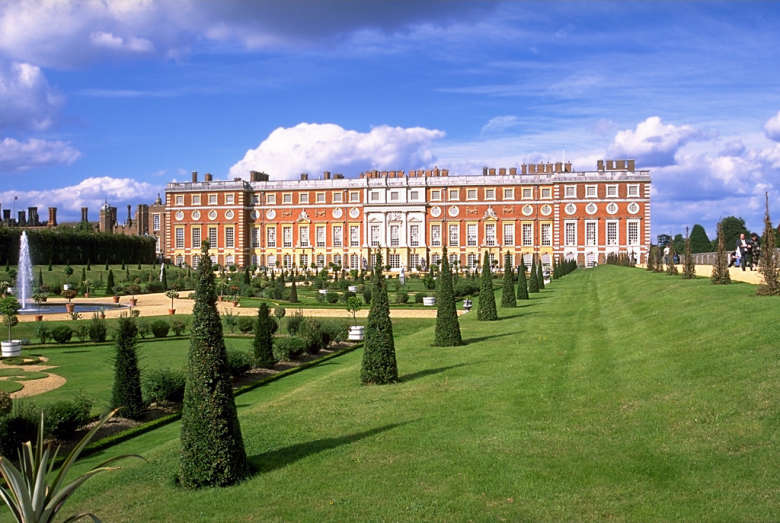

Hampton Court Palace Tour
Unlock centuries of history: book our westminster abbey tour with our skip-the-line tickets, book a tour.
- Our Experts
- Working with Context
- View All Cities
- Sustainable Tourism
- Refer a Friend for $50
- Travel Updates
- Advisor Login
- Expert Portal
Subscribe to our Newsletter
- Privacy Statement & Security
- Cancellation Policy
Westminster Abbey

Price & Hours
- Facilities 4.0
- Atmosphere 4.5
This medieval church, graced by many royal weddings and coronations, offers a magnificent peek at London's far-reaching history. Westminster Abbey is generally busy – and the staff keeps you moving at a pretty swift pace – so do a little research ahead of time to avoid missing your personal must-sees. For instance, if you're a bibliophile, consider a visit to the Poets' Corner. This is the final resting place of famed authors Geoffrey Chaucer, Charles Dickens and Rudyard Kipling, among others. If you're fascinated by all the intrigue surrounding the British royalty, you might like to visit the shared tomb of enemies and half sisters Elizabeth I and Mary Tudor.
If you prefer to see the abbey at your own pace, but still want a little guidance on the history you're encountering, take advantage of the multimedia guides, which are included in the price of admission and available in 14 languages. Alternatively, you can take a guided tour (led by the abbey's vergers) and see special places inaccessible to the public, including the tomb containing Saint Edward the Confessor. If you decide to take this tour, you'll pay 10 pounds (around $14) on top of the general admission price.
Although most travelers agree that Westminster Abbey is indeed a must-see attraction, some lament the high admission price and overwhelming crowds. Keep in mind, while photos are allowed in the church, they are prohibited in some areas, including the Queen's Diamond Jubilee Galleries.
Westminster Abbey is usually open to visitors Monday through Friday from 9:30 a.m. to 3:30 p.m. and Saturday from 9 a.m. to 3 p.m., though you should check the abbey's calendar for any scheduled closings before you plan your tour.
Admission for adults costs 30 pounds (about $39.50) and can include one child ages 6 to 17. Otherwise, children age 6 to 17 pay 13 pounds (about $16). If you have a London Pass, your entrance fee is covered. (There is no charge to attend services, when photography is strictly forbidden.)
The closest Tube stop is Westminster, on the Jubilee, District and Circle Lines. For more information about tour times and admission prices, visit the Westminster Abbey website .
Tours & Tickets

Westminster to Greenwich Sightseeing Thames Cruise in London
(2242 reviews)
from $ 21.10

Westminster Guided Walking Tour with Abbey Entry
(1021 reviews)
from $ 116.20

Guided Tour of London Westminster Abbey, Big Ben, Buckingham
(365 reviews)
from $ 113.53
More Best Things To Do in London, England

#1 Buckingham Palace
Buckingham Palace, King Charles III's London home, is open for touring (except for the king's private quarters, of course) from July to October. On the tour, you'll have access to the 19 State Rooms where the king and members of the royal family host guests for state, ceremonial and official affairs. Opulently accented with chandeliers, candelabras, paintings by Van Dyck and Canaletto, and exquisite English and French furniture, these rooms display some of the most magnificent pieces from the Royal Collection. Along with the grand interiors, the State Rooms, where kings and queens have entertained guests on both official and ceremonial occasions, are also a witness to history. Those who followed the wedding of Prince William and Kate Middleton closely will recognize the Throne Room, which served as the backdrop for the pair's official wedding photographs.
For tours in the summer, recent travelers suggested taking advantage of the multimedia guide (included with admission and available in multiple languages), so that you hear a detailed history of each room at your own pace. The palace advises you set aside at least two hours to see the State Rooms (and that you wear comfortable shoes), while recent travelers advised that you use the facilities prior to the start of the tour; there are no public restrooms available until you reach the garden. Except in the Garden Café, no food or drinks (except bottled water) are permitted in the palace.
Explore More of London, England

Things To Do

Best Hotels

You might also like

# 5 in Best Destination Wedding Spots in Europe

# 1 in World's Best Places to Visit

If you make a purchase from our site, we may earn a commission. This does not affect the quality or independence of our editorial content.
Recommended
The 26 Best Beach Resorts in the World
Marisa Méndez|Erin Vasta|Rachael Hood|Catriona Kendall September 5, 2024

30 Fun Fall Weekend Getaways for 2024
Holly Johnson August 29, 2024

The 19 Best Fall Family Vacations for 2024
Amanda Norcross August 27, 2024

The 28 Best Water Parks in the U.S. for 2024
Holly Johnson|Timothy J. Forster May 8, 2024

The 18 Best Napa Valley Wineries to Visit in 2024
Lyn Mettler|Sharael Kolberg April 23, 2024

The 25 Best Beaches on the East Coast for 2024
Timothy J. Forster|Sharael Kolberg April 19, 2024

The 50 Best Hotels in the USA 2024
Christina Maggitas February 6, 2024

The 32 Most Famous Landmarks in the World
Gwen Pratesi|Timothy J. Forster February 1, 2024

9 Top All-Inclusive Resorts in Florida for 2024
Gwen Pratesi|Amanda Norcross January 5, 2024

24 Top All-Inclusive Resorts in the U.S. for 2024
Erin Evans January 4, 2024

- Skip to primary navigation
- Skip to main content
- Skip to primary sidebar
- Skip to footer
TravelAwaits
Our mission is to serve the 50+ traveler who's ready to cross a few items off their bucket list.
16 Reasons Westminster Abbey Is Famous (And Why You Should Visit!)

r.nagy / Shutterstock
- Activities and Interests
- Destinations
- History and Culture
- UNESCO World Heritage Sites
- United Kingdom
Westminster Abbey is a UNESCO World Heritage site and one of the best-known landmarks of London. It’s close to the Houses of Parliament and is easy to reach by bus, Tube, or boat.
The building itself is an outstanding medieval Gothic church, with some even older parts. The vast collection of tombs, statues, and other memorials is a fascinating three-dimensional encyclopedia of British history. If that weren’t enough, this royal church has been the site of many famous events.
Westminster Abbey is about as awe-inspiring a church as you could imagine. It offers daily services and even boasts the shrine of a saint at its heart.
Here are 16 reasons to visit Westminster Abbey on a trip to London .
1. It Boasts More Than 1,000 Years Of History
The Saxons built a church to honor Saint Peter on the site in the early 700s. Around 960, that church became a small Benedictine abbey. In the mid-1000s, the last Saxon king, Edward, built a new abbey called West Minster. He also built the original Palace of Westminster.
King Edward’s Westminster Abbey was consecrated in December of 1065. The Pyx Chamber and Undercroft and Britain’s oldest door are all that remain of that building.
The present Gothic-style abbey was built in the 1200s by King Henry III as a grander replacement.
The Henry VII Lady Chapel was added in the 1500s, and the two towers by the Great West Door are from the 1700s.
Westminster Abbey continues to change and grow, as the recent Triforium Project demonstrates.

Dmitry Naumov / Shutterstock
2. It’s A UNESCO World Heritage Site
The Palace of Westminster (Houses of Parliament), Saint Margaret’s Church, and Westminster Abbey together make up a UNESCO World Heritage site .
At the nearby medieval Jewel Tower , interpretive signs show how the old palace and the abbey functioned as one site, with no busy street separating them.
3. The Figures Of The Great North Door Are Incredibly Detailed
Visitors enter the abbey by the Great North Door, where detailed carvings and gargoyles set the medieval stage.
4. There Are Monuments To British Politicians And Statesmen
White marble statues of three men from the Canning family are among the first things you’ll see inside.
This is the North Transept, also called Statesmen’s Aisle. It’s full of memorials to politicians, many from the Victorian period.
In the nave, you’ll find additional monuments to politicians, some depicting dramatic scenes like Prime Minister Spencer Perceval’s assassination in the House of Commons in 1812. Toga-clad Charles James Fox, who served as Foreign Secretary, is melodramatically draped in the arms of Liberty.

cowardlion / Shutterstock
5. The Building Itself Is Magnificent
As you enter the building, you’ll see just how spacious and beautiful Westminster Abbey is.
The Gothic architecture evokes a spiritual atmosphere. Your gaze is drawn up the vast stone columns. The columns branch out at the tops, where ribbed vaulting supports the high ceiling. The pointed arches of the windows and doors, the great circular rose windows , the extensive use of stained glass, the flying buttresses, and the delicate appearance of the stonework are all characteristic of the world’s great Gothic medieval cathedrals.
Later, you’ll see the Henry VII Lady Chapel. Its ornate ceiling uses an ingenious design called fan vaulting, supported by pendants.
6. It Honors Britain’s Best Engineers, Architects, And Scientists
The windows and monuments in the nave honor engineers, architects, and scientists. Robert Stephenson’s window shows the famous Rocket locomotive.
Think of a great name from British science and engineering, and chances are you’ll find that person here. In 2018, Professor Stephen Hawking joined Sir Isaac Newton and Charles Darwin at Westminster Abbey.
8. It’s Home To Britain’s Tomb Of The Unknown Warrior
On November 11, 1920, the body of an unidentified British warrior killed during World War I was buried here in soil from France. Looking upon his simple grave is a moving experience.
Walking along through the quire (or choir), you are reminded that music is an integral part of the abbey’s daily life.

CEphoto, Uwe Aranas / Wikimedia Commons ( CC BY-SA 3.0 )
9. It’s A Royal Peculiar
Westminster Abbey is one of a small number of churches known as Royal Peculiars. These churches are under the direct supervision of the monarch rather than being the responsibility of a bishop.
10. It’s The Place Where Kings And Queens Are Crowned
Since 1066, Westminster Abbey is where English monarchs have been crowned using some of the Crown Jewels from the Tower of London .
For the ceremony, the Coronation Chair is placed on the Cosmati Pavement . This richly patterned mosaic of stones and glass was created by Italian craftsmen in 1268 and has been beautifully restored .
11. Adventurers And Generals Are Interred There
Fans of Arctic exploration will know that Sir John Franklin and all his men died trying in vain to find the Northwest Passage. Franklin’s memorial in Saint John the Evangelist’s Chapel features a bust of him above a carving of his ships, Erebus and Terror, fatefully trapped in the Hudson Bay ice.
The large monument to General James Wolfe depicts the Battle of the Plains of Abraham in Quebec City, in which the English defeated the French in 1759. The sculpture shows how the soldiers came by boat on the Saint Lawrence River, pulled their cannons up the steep cliffs, and attacked by surprise.

Tupungato / Shutterstock
12. A Saint Is Buried There
The average visitor to Westminster Abbey may not know they’re in the presence of a saint. About 100 years after building the abbey, King Edward became Saint Edward the Confessor . His shrine is the heart of Westminster Abbey. In October , the abbey celebrates Saint Edward’s feast day.
King Henry III honored Saint Edward by building the Gothic Westminster Abbey and the shrine. Henry’s own tomb is not far away.
Until the mid-1300s, Saint Edward was the patron saint of England, but then he was ousted by the feisty dragon-slayer, Saint George.
13. Many British Royals Are Buried There
There are 30 royal tombs in Westminster Abbey. Many of these tombs have life-size effigies on top. These are fascinating, partly because they show how high-ranking people used to dress, but mainly because they are so unusual. I hadn’t expected to see a knight in armor lying on his back.
The Tudor family is prominent. The Lady Chapel contains the tomb of the first Tudor king, Henry VII, and his wife, Elizabeth of York. Their famous son, King Henry VIII, is not buried at Westminster Abbey (he’s at Windsor), but all three of his children are, and so is his fourth wife, Anne of Cleves.
Queen Elizabeth I’s effigy wears an ornate crown and holds an orb and scepter. She lies near her half sister, Queen Mary I, the one who put her in the Tower.
14. It Has Hosted Numerous Royal Weddings And Funerals
Did you watch the wedding ceremony of Kate Middleton and Prince William in April of 2011? In pictures of them exchanging vows, you can see the Cosmati Pavement.
Queen Elizabeth II was married here in 1947, when she was still a princess.
There have been 16 royal weddings at Westminster Abbey, starting in 1100.
Monarchs are no longer buried here, but funerals and memorial services continue. Princess Diana’s funeral in 1997 and the Queen Mother’s in 2002 were both major events for Westminster Abbey.

Yuri Turkov / Shutterstock
15. It Honors Famous Poets, Writers, And Musicians
Coming from the royal tombs into the Poets’ Corner, there’s a change in the place’s mood. It lightens up as you see memorials to notable British artists (not just poets) like the Bronte sisters, William Shakespeare, Jane Austen, and Thomas Hardy. There are more than 100 of these memorials, and the list is still growing.
Charles Dickens hadn’t wanted a big funeral, and he hadn’t asked to be buried in Westminster Abbey. His funeral was a secret, and his marker bears plain text with just his name and dates.
The statue of the musician George Frideric Handel, on the other hand, is holding sheets of printed music and looks to be keeping time with his foot.
The access to the cloisters and the beautiful Chapter House is nearby.
16. The Modern Martyrs Sculptures Are Unique
After you leave the abbey through the Great West Door, look back. The Modern Martyrs sculptures, unveiled in 1998, honor 10 Christians who died for their beliefs. Dr. Martin Luther King Jr. and Saint Oscar Romero are two of them.
What To Know Before You Go
There is an admission charge to enter Westminster Abbey as a tourist.
The abbey holds worship services every day. On some days, the abbey is only open for services, not for tourists. It’s essential to check the website in advance of your visit, whether you plan to visit as a tourist or as a worshipper .
Saint Margaret’s Church, right beside Westminster Abbey, is free to enter, though as with all churches, you should expect to give a donation. It too has a rich history and a variety of monuments, including one to a Beefeater who served the Tudors.
The abbey’s accessibility features are described on the website.
If you need a break, just sit down and look up. It’s an inspiration.

Canadian writer Jill Browne lives in Calgary, Alberta, not far from Banff National Park. She travels regularly to London, England, often solo, and has lots of tips for walking and sightseeing there. Jill blogs about London history on LondonHeritageHotspots as well as on Instagram . She loves to plan family history trips for people, especially when their roots connect them to the British Isles. Her website, Genealogy And Travel is devoted to genealogy travel and family history tourism, no matter where you are. You don't have to fly to get in touch with your ancestry.
An experienced road tripper, Jill has driven across Canada and the U.S. multiple times. She and her geologist husband have explored some of Australia and the North Island of New Zealand by car, and are hoping to go back for more. Jill likes gardens, forests, and anything with plants, really. "Adventure without risking life and limb" is her travel motto, and the byline for her blog, Middle of the Road Less Travelled .

- Switzerland
- New York City
- The Bahamas
- Travel Tips
- Work With Us
- Russell (The Other One)
- Get to Know Us
Westminster Abbey Guide: Important Things to Know Before You Visit
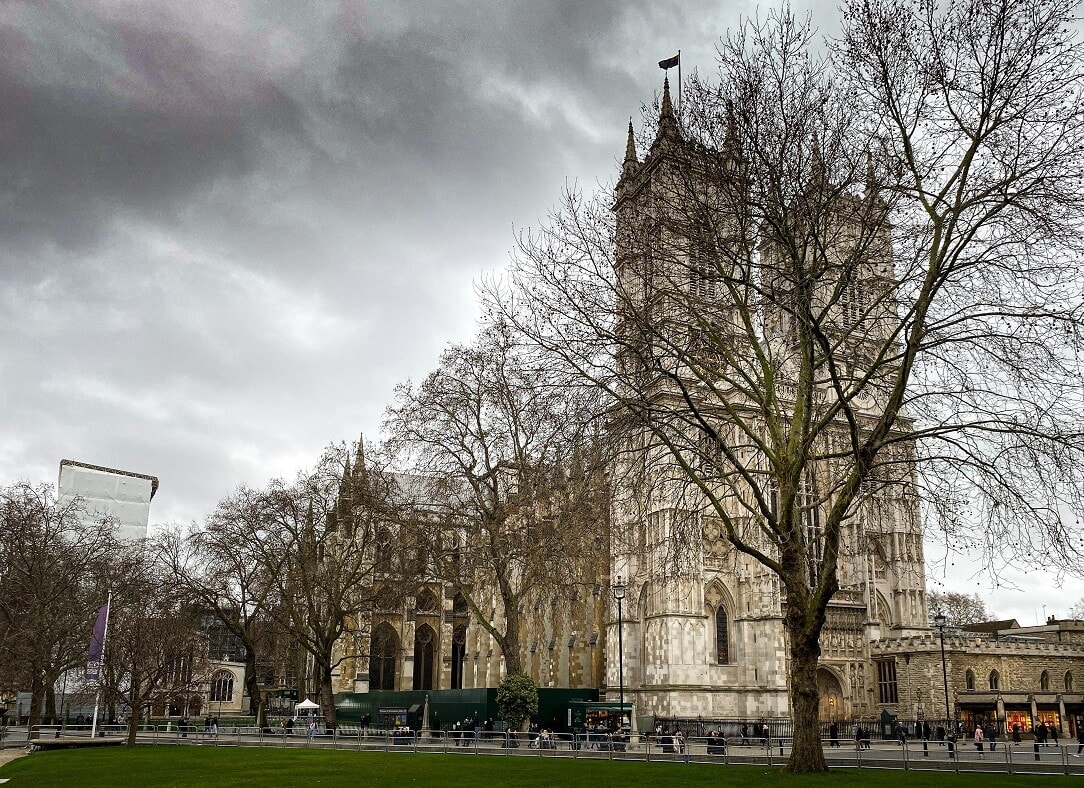
I visited Westminster Abbey for the first time when I was a teenager. While I still remember my visit, I wanted to go to the Abbey again now that I have learned a bit more about British history.
It’s a UNESCO Heritage site and one of those places that you shouldn’t miss when visiting London. Westminster Abbey is a working church with strong ties to the Royal family and British Government. The building is an example of medieval perpendicular gothic architecture at its finest.
There are a lot of things to see at Westminster Abbey so I have created this guide to help you plan your visit. Learn more about its history, the highlights that you shouldn’t miss, and get some important tips to make the most of your time at the Abbey.
Note: This post contains affiliate links. Please see disclosure for more information.
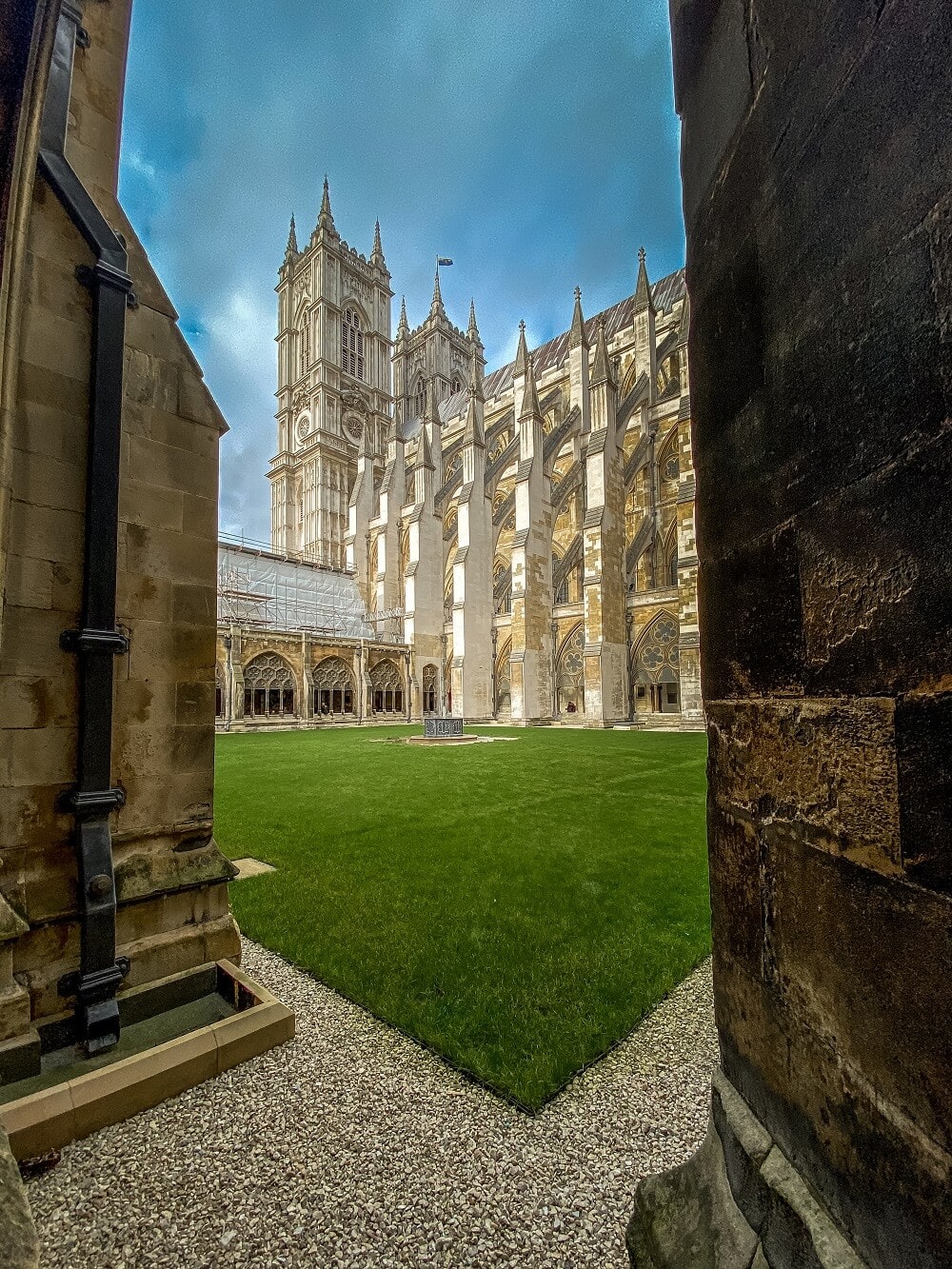
The History of Westminster Abbey
Entry (north transept), north choir aisle, tomb of the unknown warrior, north ambulatory chapels, shrine of st. edward the confessor, tomb of elizabeth i and mary i, the lady chapel, tomb of mary queen of scots, south ambulatory aisle, poets’ corner, queen’s diamond jubilee galleries, pyx chamber, chapter house, coronation chair, americans in westminster abbey, westminster abbey shop, where to eat at westminster abbey, where to get the best photos of westminster abbey, westminster abbey hours, westminster abbey admission, wednesday lates, combined ticket with st. paul’s cathedral, london pass, attending a service at westminster abbey, how to get to westminster abbey, bags in westminster abbey, westminster abbey app, is westminster abbey accessible, how long does it take to visit westminster abbey, is westminster abbey good for kids, should you do a guided tour of westminster abbey, other tourist attractions near westminster abbey, is visiting westminster abbey worth it, expert tips for visiting westminster abbey.
The site has been a place of worship for over 1,000 years. Benedictine monks founded Westminster Abbey in 960 (although there were churches on the site at least since the 7th century). Since 1066, every English and then British coronation has taken place at the Abbey and it is the final resting place for monarchs, poets, musicians, scientists, and politicians. It has also been the venue for 16 royal weddings.
The church built by Edward the Confessor in the 11th century was constructed in the Romanesque style. It was the first in England to be shaped like a cross. Only some areas from the lower part of the monastic dormitory still remain.
In the 13th century, Henry III ordered a new more elaborate church to be built with the shrine of Edward the Confessor at its heart. This is the building we see today. You will notice typical gothic architectural features like pointed arches, ribbed vaulting, flying buttresses, and rose windows. The Rose window above entrance is from 1722 and depicts apostles excluding Judas. The opposite rose window is from 1902 and depicts a variety of figures.
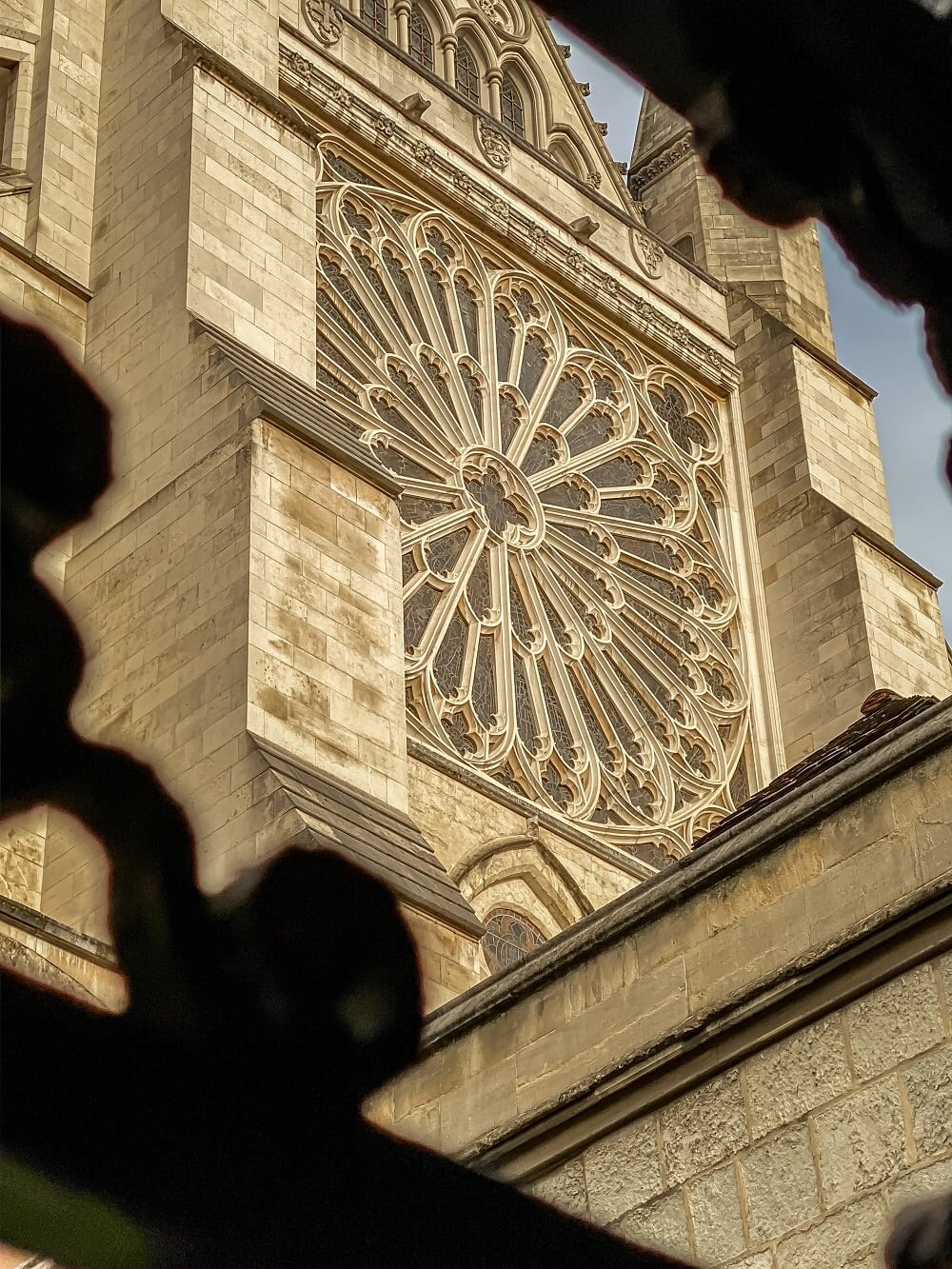
Henry VII added the Lady Chapel dedicated to the Virgin Mary. In the 16th century, Henry VIII granted the Abbey cathedral status to spare it from the destruction that most English abbeys faced during the Dissolution of the Monasteries.
Elizabeth I gave the Abbey its formal title – the Collegiate Church of St Peter. It is not part of the reporting hierarchy within the Church of England and instead, reports directly to the sovereign rather than the Archbishop of Canterbury.
The Abbey was damaged by Puritans during the 17th century but was again protected by its close ties to the government. The two western towers were added in the 18th century.
Westminster Abbey was damaged during World War II, but luckily many treasures were sent away to be hidden when the war started. The Abbey suffered minor damage during the Blitz in 1940. In 1941, the roof was hit by several bombs that started a fire. The burning timbers and molten lead fell into the open area below where the fire could be more easily extinguished.
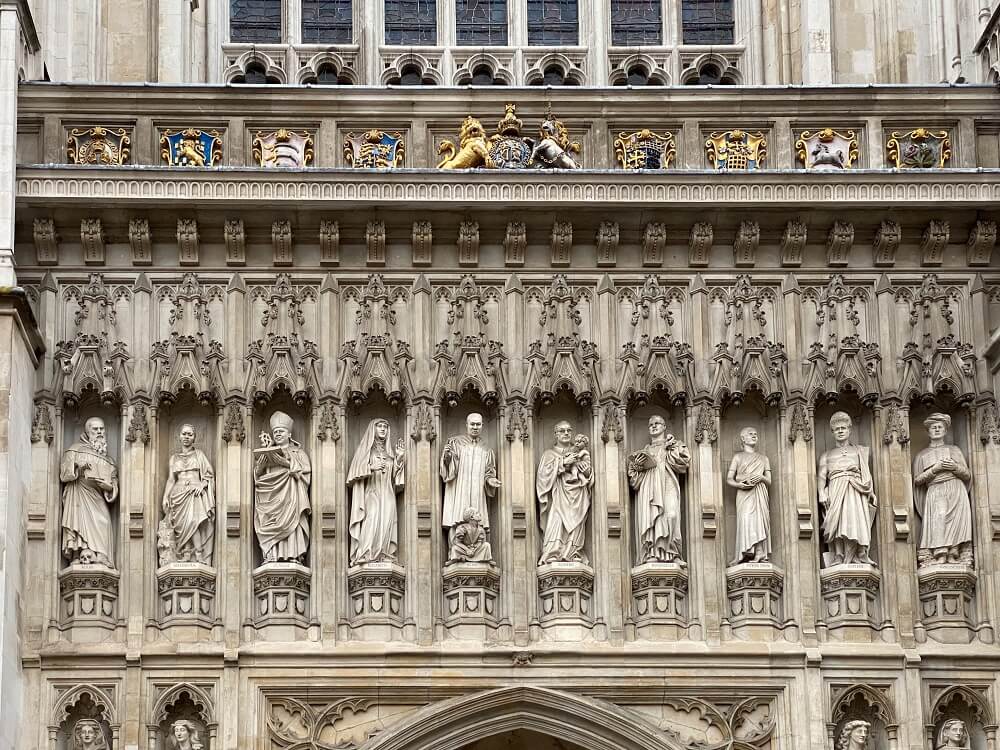
Most recently, in 1998, ten statues of modern martyrs were added in the niches over the West Door which had previously been empty. The modern martyrs are Dr. Martin Luther King Jr, St Oscar Romero, Dietrich Bonhoeffer, Wang Zhiming, St Maximilian Kolbe, Manche Masemola, Esther John, Janani Luwum, Lucian Tapiedi, and Grand Duchess Elizabeth. In 2018, Westminster Abbey was featured in London Lumiere.
It is also the site of some state funerals including the one for Queen Elizabeth II on September 19, 2022.
Please be conscious of the historical nature of the building. Do not lean on or touch any of the monuments.
What to See at Westminster Abbey
Even though it was my second visit to Westminster Abbey I was surprised by how much there is to see. There are over 3,000 people buried in Westminster Abbey! That’s not all. There are historical artifacts and interesting architecture that you don’t want to miss.
I want to manage your expectations – you will not be able to see everything in one visit. Let me help you prioritize and tell you the most important things to see when visiting Westminster Abbey.
The history starts the second you walk in the door. Before your audio tour starts you will see several important figures in British history. It shows that there is a strong link between the Abbey and the government.
There are larger-than-life statues to honor some of the leading Prime Ministers from the 18th and 19th centuries including Viscount Patterson , Robert Peel , Benjamin Disraeli , and William Gladstone (who is buried nearby). It is a bit ironic that the tributes to Disraeli and Gladstone are so close together when they were bitter rivals.
The largest memorial in this area is dedicated to Prime Minister William Pitt . He is buried nearby with his son William Pitt the Younger . There is a plaque honoring the younger near the west door.
Also if you take a minute to admire the stained glass here you will notice that there is one panel that is modern. The window pays tribute to the Queen and depicts a hawthorn blossom scene in Yorkshire. It was designed by David Hockney and installed in 2018.
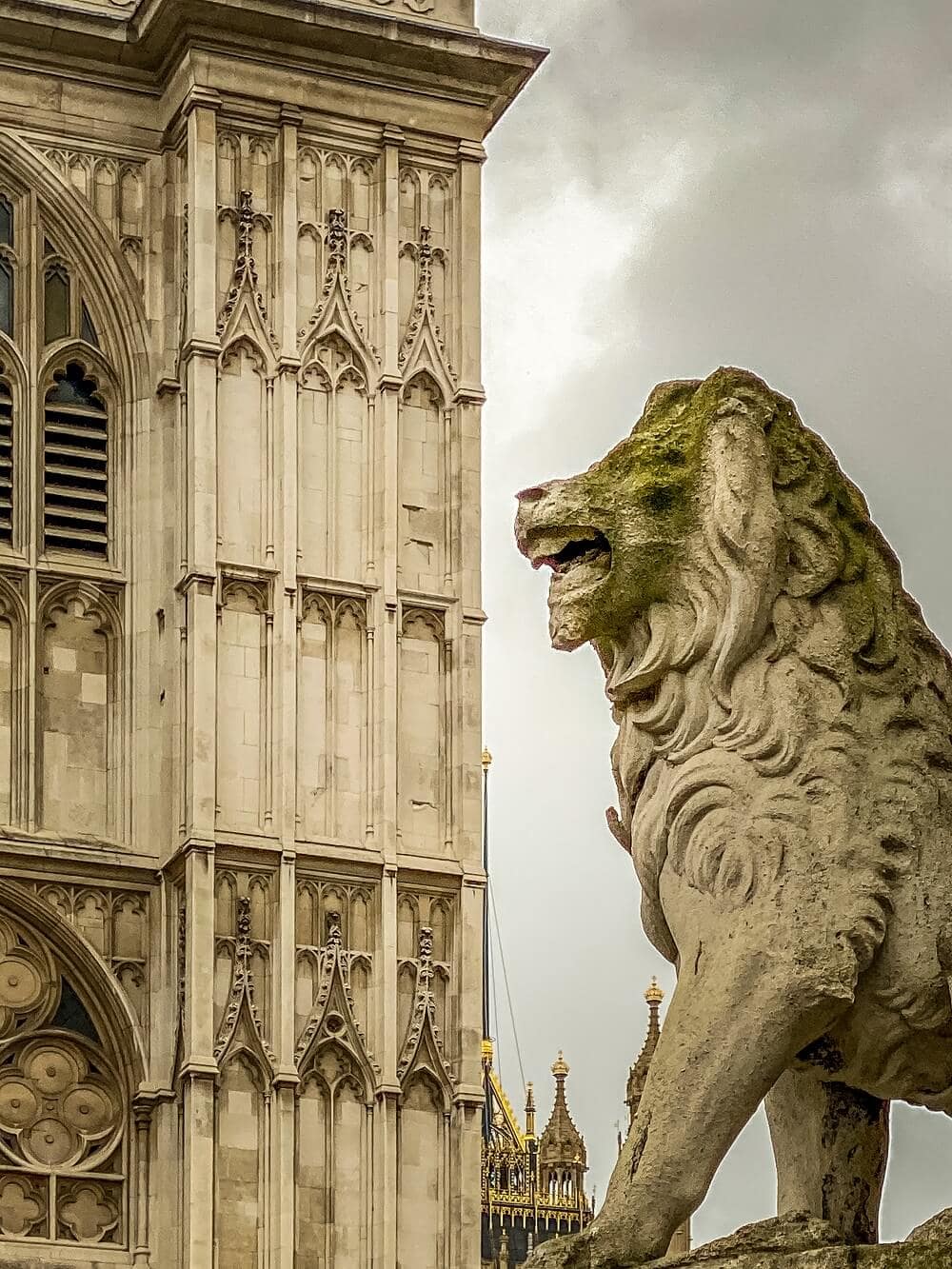
This is where the audio tour starts but it doesn’t mention what to see on this aisle. We enjoyed looking at the plaques and statues. We found a few interesting ones:
- William Wilberforce: As a member of Parliament (and close friend of William Pitt), he took up the cause for the abolition of slavery. The Abolition Bill became law in 1807, long before slavery was outlawed in the US.
- Charles Darwin: It’s a bit ironic that Charles Darwin is buried in a religious building given that he introduced the theory of evolution, but fitting that he is near his fellow scientists. (Isaac Newton and others are in the Nave on the other side of the rope).
- Musicians: Music is integral to the Abbey, so it is fitting there is an area where several musicians and composers including Henry Purcell , Ralph Vaughan Williams , John Robinson , and William Sterndale Bennett are remembered.
The Tomb of the Unknown Warrior can be found at the back of the nave. It is the tomb of a British soldier brought back from France and buried in Westminster Abbey on Armistice Day in 1920. The grave is appropriately framed with poppies, a symbol of both Remembrance and hope for a peaceful future. This is the only grave in the Abbey that is never walked on.
Don’t miss the framed document on the pillar to the north of the grave. It contains the Congressional Medal of Honor that General Pershing awarded to the Unknown Warrior on October 17, 1921, on behalf of the USA. The Congressional Medal of Honor Society’s flag, presented to the Unknown Warrior in October 2013, is also on the pillar.

When the Duke of York (later King George VI) married Lady Elizabeth Bowes Lyon in the Abbey in 1923 she laid her wedding bouquet on the grave as a mark of respect. She had lost a brother during the war. All royal brides married in the Abbey since then have sent back their bouquets to be laid on the grave. Some royal brides who were married elsewhere have done the same.
Near the tomb of the Unknown Warrior is a plaque to honor Prime Minister Winston Churchill . It was unveiled by Queen Elizabeth II on 19th September 1965, the 25th anniversary of the Battle of Britain, and a wreath was laid by his widow. He is buried near Blenheim Palace in Oxfordshire with other family members.
The nave is the main public part of the Abbey. This is where commoners would most likely sit at a service. While you are in the nave take time to admire the medieval ceiling and chandeliers.
As you walk around the area, you will notice several important people commemorated here:
- John Harrison , the clockmaker, has a memorial with a meridian line engraved with its own longitude of 0 degrees, 7 minutes and 35 seconds West in two metals to highlight Harrison’s most widespread invention, the bimetallic strip thermometer.
- David Livingstone , a Scottish physician, Congregationalist, explorer in Africa, and one of the most popular British heroes of the late 19th-century Victorian era is buried here.
- Nelson Mandela , the South African anti-apartheid revolutionary, political leader, and President of South Africa has a memorial stone inscribed with the words “Forgiveness Reconciliation.”
The Nave also has an area called Scientists’ Corner. Sir Isaac Newton ’s elaborate and imposing tomb is on the left side of the nave just before you go to the Quire. Several other important figures in science are memorialized nearby. The latest addition to Scientists’ Corner is Stephen Hawking who died in 2018. His plaque has a picture of a black hole and bears the inscription “Here lies what was mortal of Stephen Hawking”. This is the English translation of the words on Newton’s tomb which says the same thing but in Latin.
The Quire area is where the monks would sit for daily prayers. Now, it is used for the Westminster Choir and clergy. The Choir of Westminster Cathedral was founded in 1901 and is known as one of the finest in the world.
The Quire stalls you see today were installed in 1848. Stalls not used by the Choir are assigned to the Monarch, clergy, officers of the Abbey, and High Commissioners for the Commonwealth countries when they attend services. Some have nameplates.
The High Altar is the place where the Eucharist is celebrated. There are four services each day. They change the color and the types of flowers on the altar for the seasons.
The Cosmati Pavement in front of the altar was laid in 1268 by craftsmen from Rome under the order of Henry III. It is made of colored glass and marble and was restored in 2010. The Monarch is crowned here during the coronation ceremony.
These chapels contain some elaborate tombs with intricate carvings, but we had a difficult time figuring out who was who. When we were able to find names, we didn’t recognize them. If you are tight on time, you can go through this section quickly.
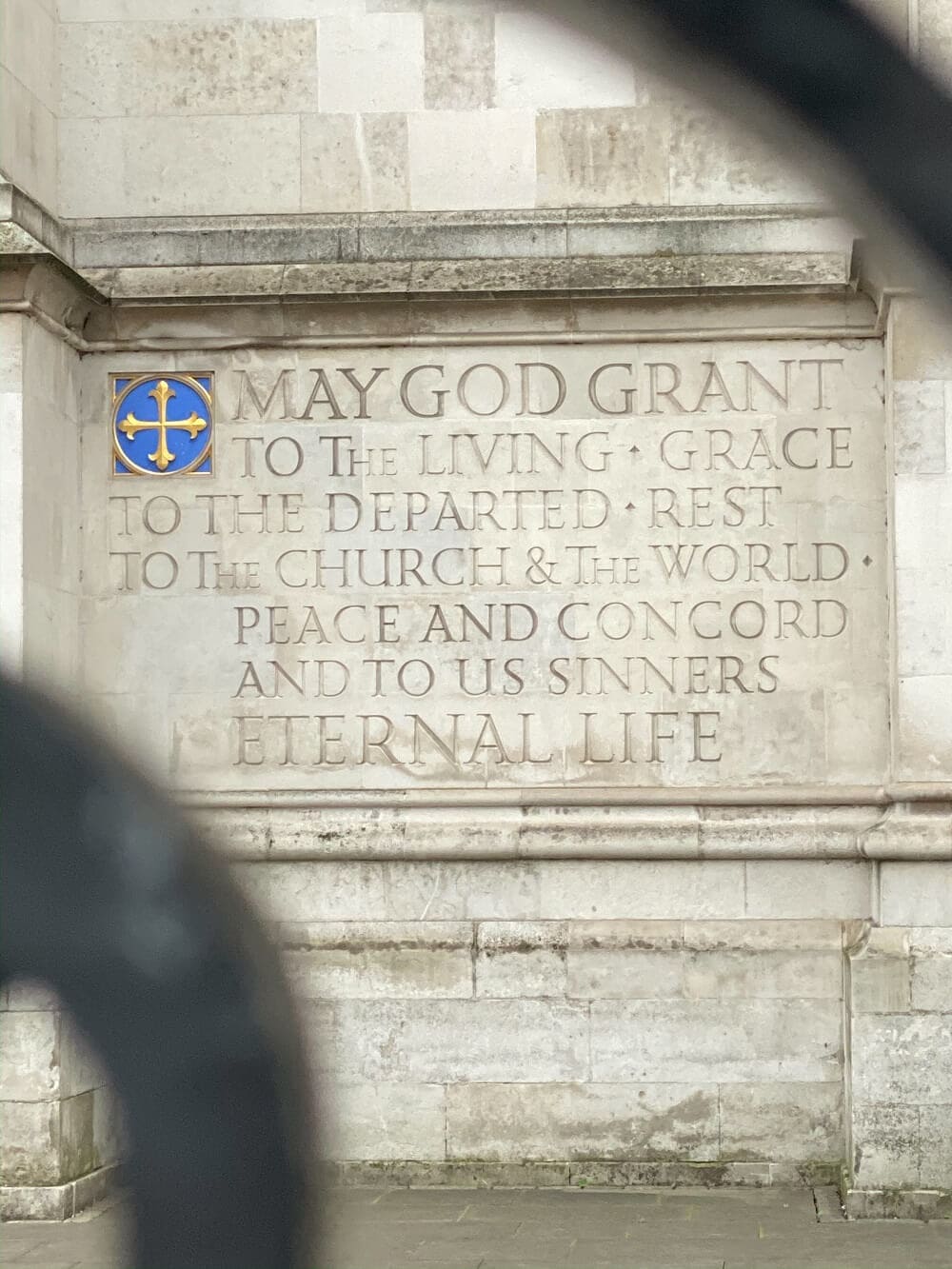
Behind the high altar is the shrine of Edward the Confessor . The shrine is considered the center of the Abbey and five kings (including Henry III , Edward III , and Henry V ) and four queens are now buried in this area. The floor is extremely fragile so only those here for private prayer or the guided tour can actually enter the Shrine. You can try to peak through the stairs or get a view from above in the Queen’s Gallery.
Edward died in 1066 and was buried in the Abbey. In 1163, he was moved to a special shrine. Then in 1269, he was moved to a more elaborate shrine created by Henry III. During the Dissolution of the Monasteries, Edward’s tomb was moved and robbed of its jewels. When Mary I took the throne she repaired the Shrine, moved the coffin back to its place, and gave jewels to replace the ones that were stolen.
In this narrow room with an ornate fanned ceiling, you will find the tomb of Elizabeth I and Mary I . I found it ironic they were buried together as sisters as they did not get along. The figure on top of the tomb is clearly Elizabeth and there is barely a mention of Mary.
While both are the daughters of Henry VIII, Mary’s mother, Catherine of Aragon, was Catholic, and Elizabeth’s mother, Anne Boleyn, was Protestant. Mary is also known as Bloody Mary because she had many Protestants killed.
Innocents’ Corner in the back of the contains a sarcophagus for the remains of two princes who are known today as The Princes in the Tower . Princes Edward and Richard were the only sons of King Edward IV, and are usually assumed to have been murdered in the Tower of London to allow their uncle, Richard III, to claim the throne.
The Lady Chapel is like its own church. It has a nave, quire, font, and altar. It was built by Henry VII and is one of the best examples of late-medieval English architecture. The roof and walls are intricate, with delicate carvings, almost more like glass than stone.
Behind the altar, you will find the tomb of Henry VII and his queen. Key members of his family are buried around him. Members of the Stuart dynasty, including Charles II , are buried in a vault under the floor. Henry VIII is the only Tudor monarch who is not buried at Westminster Abbey. Instead, his final resting place is at Windsor Castle with his favorite wife, Jane Seymour.
In the back of the Lady Chapel behind the tomb of Henry VII, there is the RAF chapel which is dedicated to the men of the Royal Air Force who died in the Battle of Britain in 1940. A hole in the stonework has been covered in glass as a reminder of when the Abbey was hit by bombs in 1940. The stained glass shows the badges of the squadrons that fought including those from the US, Canada, Poland, and the former Czechoslovakia.
On the floor, there is a plaque noting the temporary burial place of Oliver Cromwell . His body was removed when Charles II took the throne. Cromwell’s head was cut off and place on a spike outside Westminster Hall.
The room across the church from where Elizabeth I is buried houses the tomb of her cousin, Mary Queen of Scots . After Elizabeth I ordered her execution, Mary was originally buried in Peterborough Cathedral. When her son James, became James I of England/VI of Scotland, he had her body moved to Westminster Abbey. He made sure her tomb was even bigger than Elizabeth’s. It is decorated with symbols of the three countries where Mary laid claim to the throne – England, Scotland, and France.
Lady Margaret Beaufort , who was the mother of King Henry VII, and Margaret Douglas , who was Mary Queen of Scots’s mother-in-law are also buried in this room. Margaret Douglas was the mother of Mary’s husband, Lord Darnley, who was the father of James I/VI.
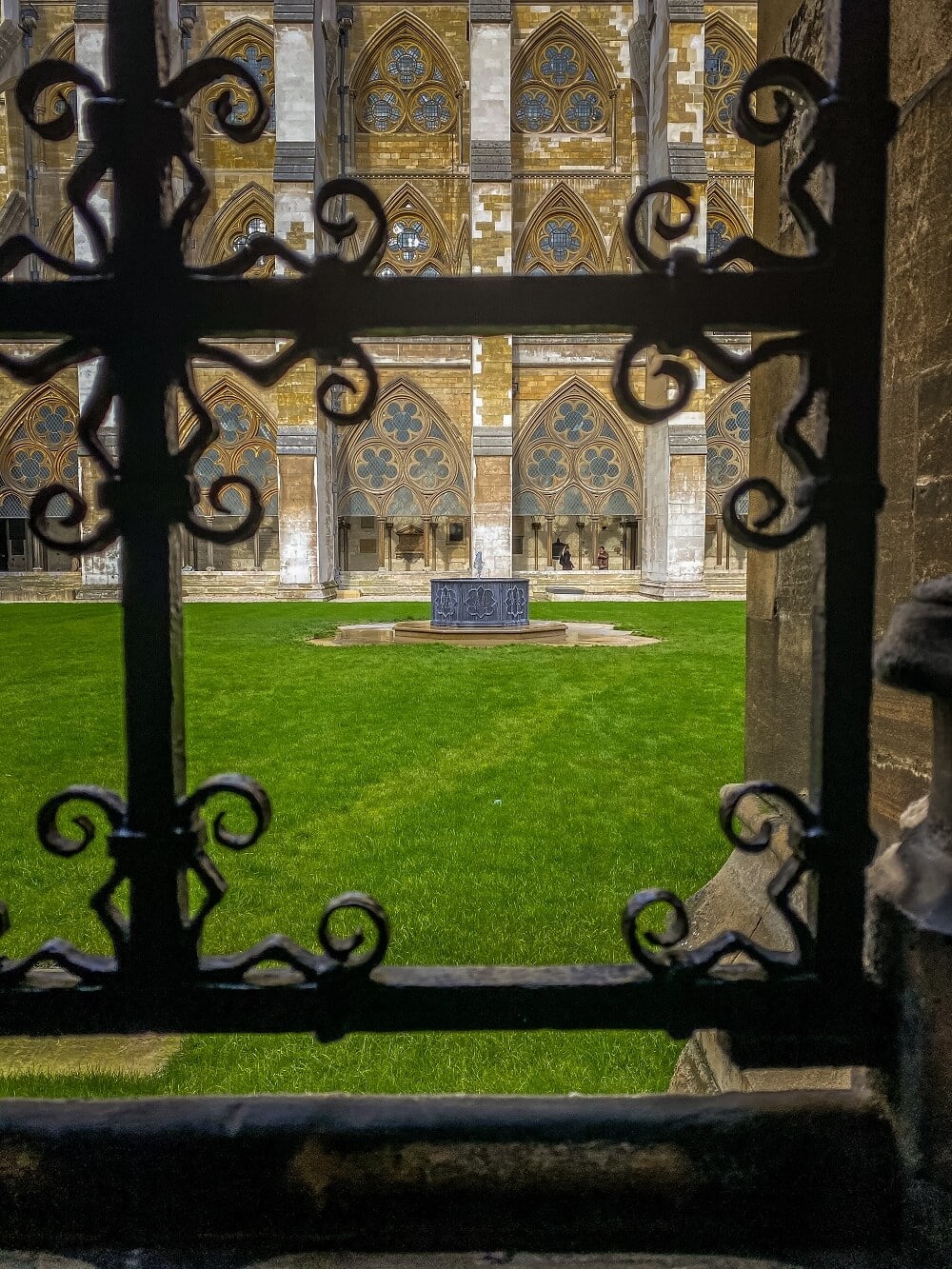
The small chapels off the aisle contain more ornate tombs. In this area, there are memorials to two Queens, Anne Neville (the wife of Richard III) and Anne of Cleeves (Henry VIII’s 4th wife). Additionally, many members of the Percy family, who own Alnwick Castle , are buried here.
I was surprised by the number of people that are memorialized in Poets’ Corner. Geoffrey Chaucer was the first person buried in this part of the Abbey. Then, Edmond Spencer wanted to be buried near Chaucer and Poets’ Corner was born.
Some of the other famous writers commemorated in Poets’ Corner are William Shakespeare, Robert Browning, Lord Bryon, Alfred Lord Tennyson, Lewis Carroll, CS Lewis, Charles Dickens, Rudyard Kipling, Thomas Hardy. and Jane Austen. Not all these legends are buried in Westminster Abbey, for example, Jane Austen is buried in Winchester Cathedral . In addition to the famous writers, there was also a plaque for Laurence Olivier, the actor, and one dedicated to the war poets.
At the back of Poets’ Corner, you will find the entrance to the Queen’s Galleries which opened in 2018. Here you will find over 300 objects chosen by the Queen from the Abbey’s collection.
We debated about skipping the galleries as we were a bit tight on time. I am glad we didn’t. It might have been my favorite part of the visit. There is an additional charge of £5 per person and you can buy the tickets at the entrance to the galleries.
When you enter the galleries, you will be given a brochure that includes a map and some of the highlights. Use the brochure as a guide, but try to browse and see items not listed too. We were amazed at some of the things we saw like:
- Copy of the Magna Carta – One of 24 surviving copies from 1300. The original copy we saw in Salisbury Cathedral was from 1215.
- Replicas of the Crown Jewel s – The real Crown Jewels are kept under extremely tight security in the Tower of London, these replicas are used for rehearsals.
- The Coronation Chair of Mary II – Since Mary ruled jointly with William they needed an extra coronation chair. You see the coronation chair that has been used for all the other Monarchs for about the last 1,000 years by the exit of the Abbey.
- Funeral Effigies of several Monarchs and other important figures including King Edward III, Queen Mary I, King Charles II, King William III, Queen Mary II, Queen Anne, and the head of King Henry VII.
- Retable – The 13th century Westminster Retable is England’s oldest altarpiece.
- Litlyngton Missal – A lavish manuscript used for prayers at the high altar. It reminded me of the Book of Kells .
- Marriage License of Prince William and Catherine Middleton – This document is a piece of art! It was exciting to see something so important and personal to the Duke and Duchess of Cambridge.
In addition to the treasures on display, I enjoyed getting the view of the abbey from above. I could imagine all the people gathering for a coronation or royal wedding. From the Queen’s Gallery, I was also able to get an aerial view of Edward the Confessor’s Shrine.
The Cloisters used to be the center of monastic life. The most important buildings of the monastery were organized around it. There are actually two cloisters at Westminster Abbey. I think a lot of people (like us) miss the Little Cloisters as there is no sign directing you to walk to it. It’s down the gated walkway just past the Pyx Chamber.
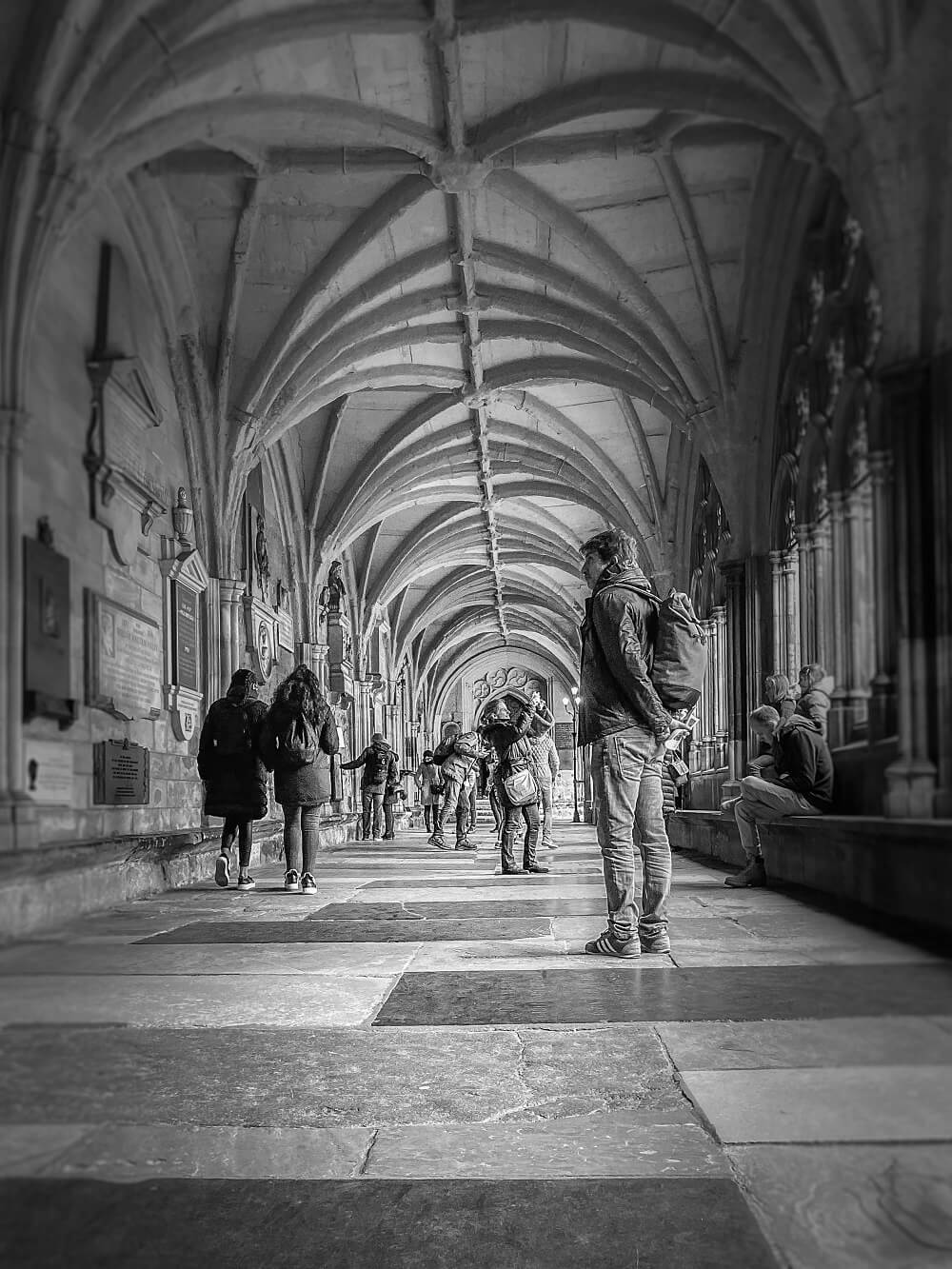
The infirmary was in the Little Cloister. They grew medicinal herbs in the nearby garden. Today some of the Abbey Clergy live here. There is a doorway you can look through and see the ruins of Chapel St. Catherine and Victoria Tower at the southern end of the Palace of Westminster.
If you visit Tuesday, Wednesday, or Thursday, the gardens are also open to the public. Our visit was on a Saturday, so we couldn’t go to the gardens.
The Pyx Chamber is one of the oldest parts of Westminster Abbey. It was built in the late 11th century. Originally it was the undercroft below the monk’s dormitory. During later years it became a storage room for valuables because it had thick walls, iron window bars, and six locks on the door.
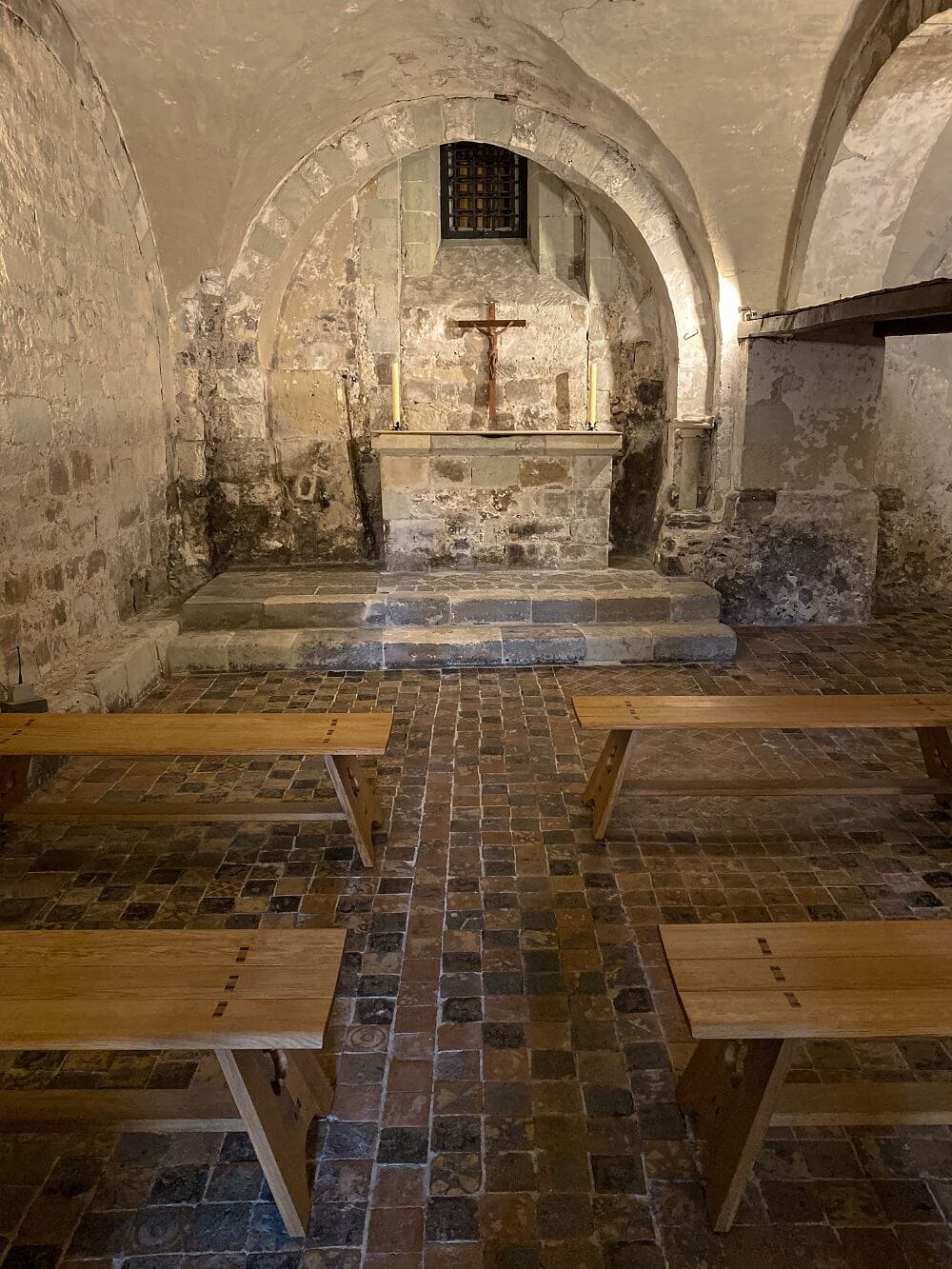
The name “Pyx” came from the small boxes where official samples of gold and silver coins were kept. New coins were tested annually in a public “Trail of the Pyx” at the Palace of Westminster.
Don’t miss the Chapter House. It was built in the mid-13th century on the orders of Henry III and has some of my favorite architecture and artwork in the Abbey. The walkway into the Chapter House reminded me of the cellarium at Fountains Abbey in Yorkshire .
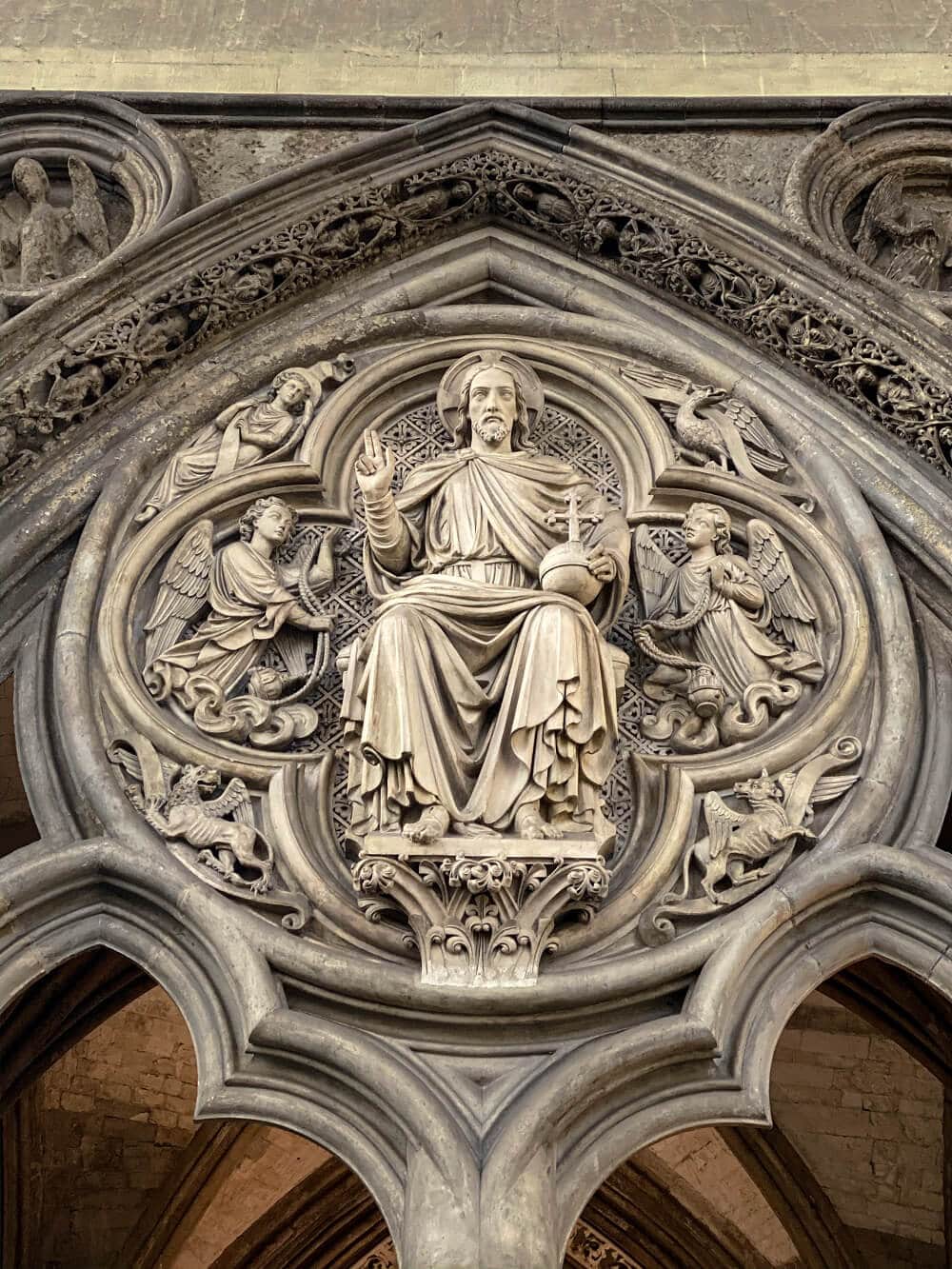
When you enter the Chapter House, turn around and look at the medieval sculptures above the doorway. These include the Archangel Gabriel, Christ in Majesty, and Mary. The Christ sculpture was actually added in Victorian times. These all used to be brightly painted. There is more beautiful stonework in the ceiling.
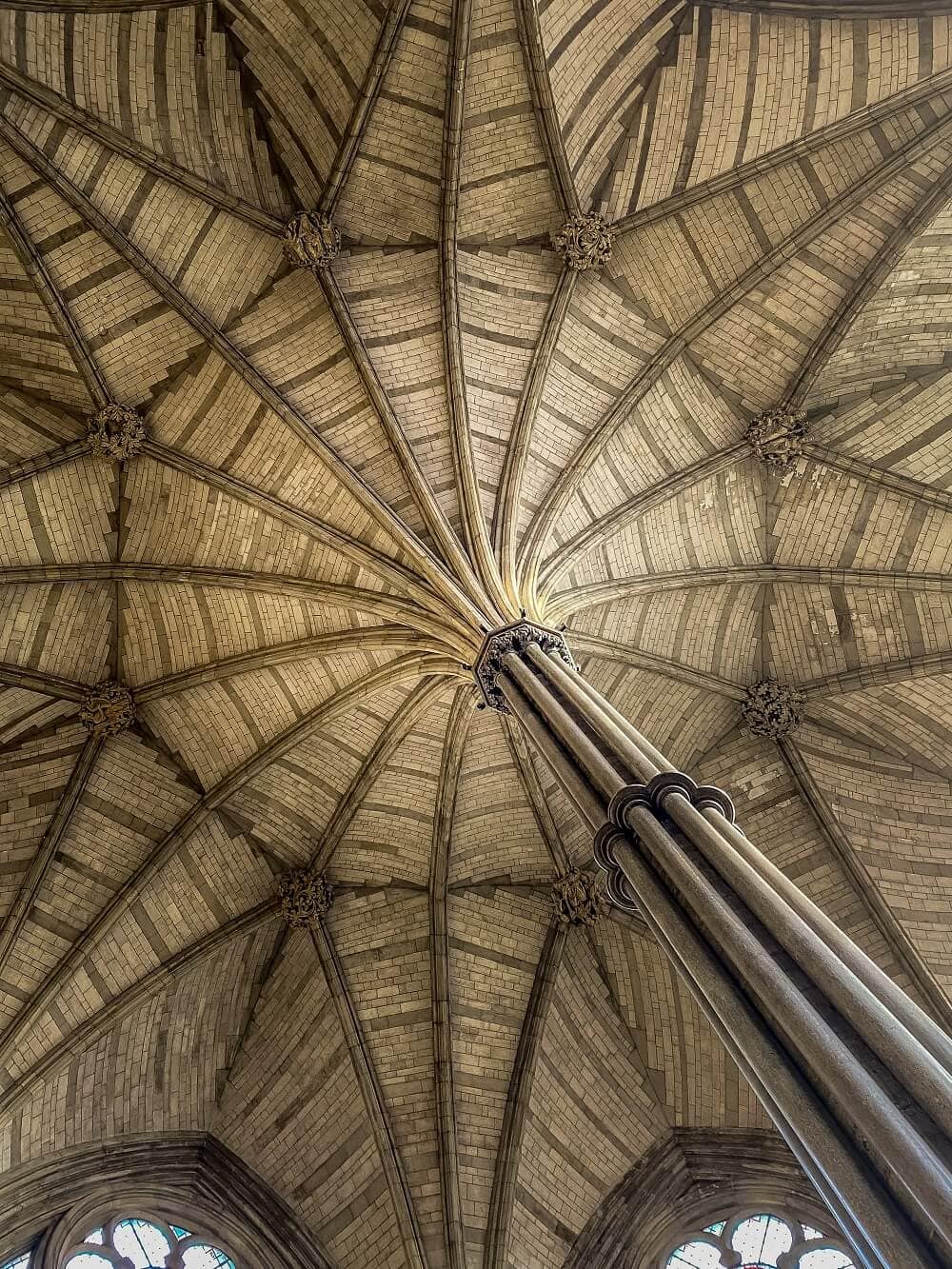
Stained glass windows surround you in the Chapter House. The original 13th-century glass was lost by the 18th century. Now, looking at the glass it’s hard to tell it was also destroyed during World War II. They tried to use as much of the Victorian glass as they could in the new panels, which include coats of arms from people associated with the Chapter House over the years. The southwest window has tiny images related to World War II.
The paintings on the walls around the room aren’t in the best condition, but you can still imagine what it would have looked like in its prime. The stone benches are where the monks would sit during their daily meetings. During the Dissolution of the Monasteries, they used the Chapter House for Parliamentary meetings and to store state documents.
The medieval floor tiles in the center of the room are worth a look. They are made by stamping designs in clay, filling in the impressions with a lighter clay, and then glazing. The glaze has worn away. The patterns in the tiles include Henry III’s coat of arms, people, fish, animals, geometric shapes, and a rose window similar to the one in the Abbey.
The Coronation Chair is on display just before you leave Westminster Abbey. Unfortunately, you can’t get too close to it, but that is understandable given its age and significance. While coronations have taken place at the Abbey since 1066, the chair has only been used for the last 700 years.
King Edward I had the Coronation Chair made to enclose the famous Stone of Scone , also known as the Stone of Destiny, which he brought from Scotland to the Abbey in 1296. Now, the Stone of Scone is on display along with the Crown Jewels in Edinburgh Castle but will be returned to Westminster Abbey for future coronations.
Westminster Abbey is not just a place to commemorate important British legends. There are people from across the globe that are honored here. Even a few Americans! While I didn’t find any Americans buried in Westminster Abbey, I did find these tributes:
- Henry Wadsworth Longfellow – In Poets’ Corner, there is a sculpture to honor the American poet, who is buried in Massachusetts.
- George Peabody – The American philanthropist was originally buried in Westminster Abbey but later moved back to Massachusetts. Look for a plaque in the nave.
- Franklin D. Roosevelt – As you leave the Abbey, there is a large plaque just to the left of the door for FDR, the 32nd President of the United States, calling him “a faithful friend of freedom and of Britain.”
- Martin Luther King Jr. – MLK, the civil rights leader, was added as one of the 10 modern martyrs about the West Door in 1998.
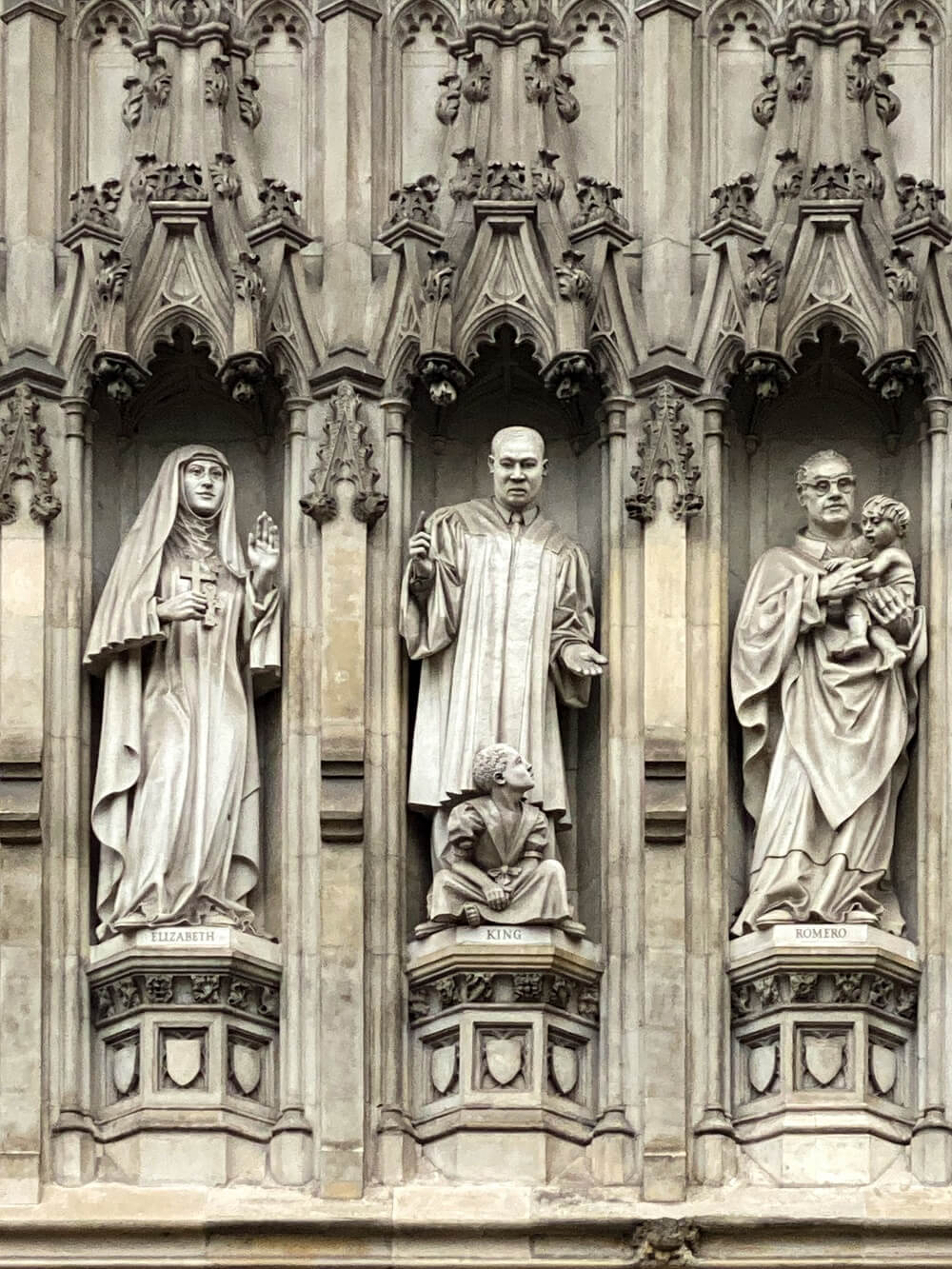
After you exit the abbey, the gift shop will be on your left. It has plenty of London souvenirs and some books that will teach you more about Westminster Abbey.
While photos are not allowed inside the Abbey, you can still get a nice picture that will help to remember your visit. We found a few good photo spots:
- Outside Westminster Abbey. On Tothill Street, it’s fun to pose with the iconic red phone boxes.
- Inside the cloisters.
- Inside the entrance to the Chapter House.
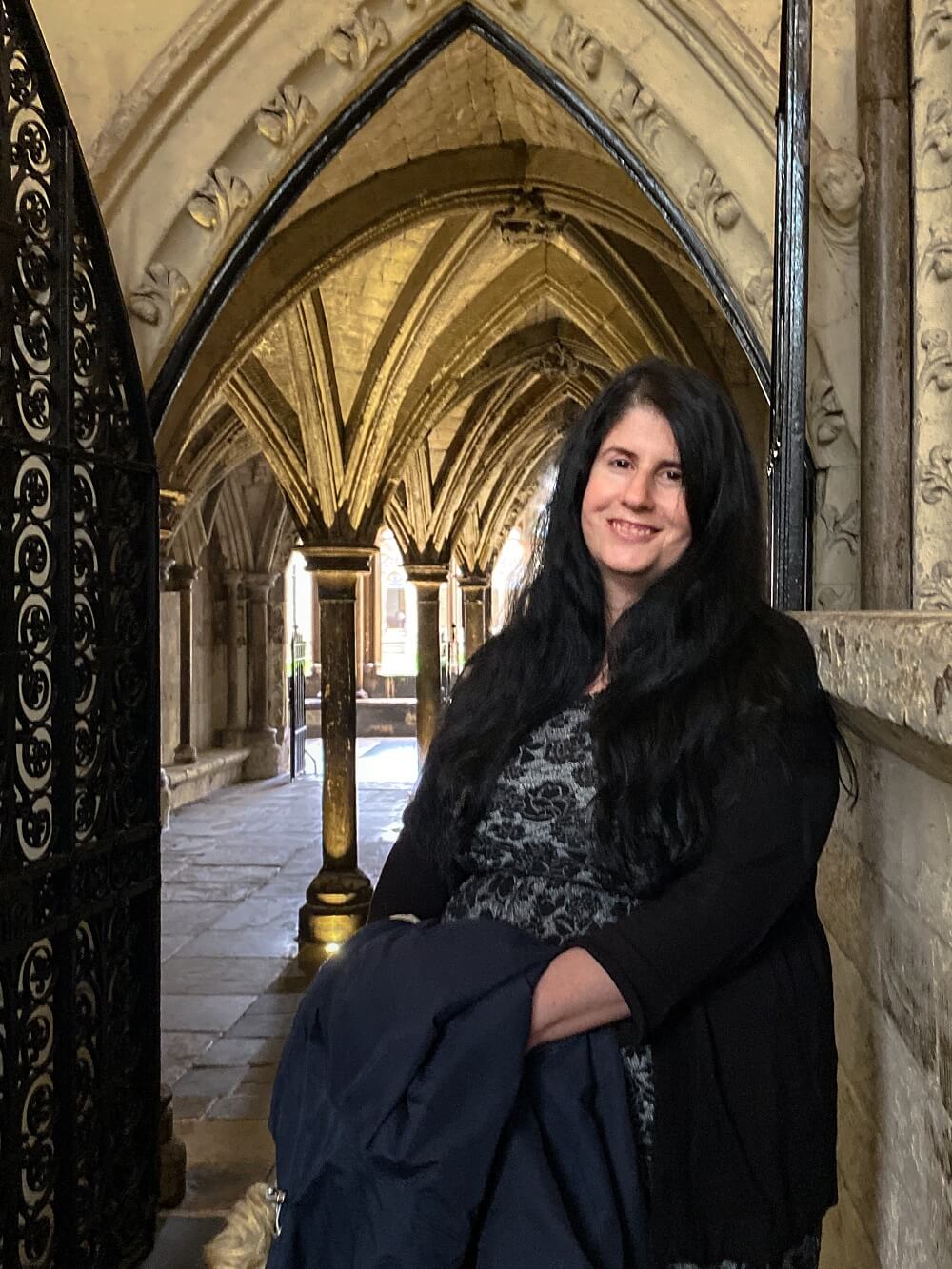
Westminster Abbey is a working church so the hours for visitors are limited. It’s best to check on the website for the date of your visit.
Keep in mind the Abbey is always closed for visitors on Sundays. The Abbey Gardens are only open Tuesday through Thursday.
Regular admission to Westminster Abbey costs £21 for adults and £9 for children. If you want to do one of the guided tours, it’s an additional fee of £7. Admission to the Queen’s Galleries is also an additional fee of £5.
Buy your tickets here in advance, it will be a few pounds more if you wait and buy them when you get to the Abbey.
How to Save on Westminster Abbey Admission
It is possible to save money when visiting Westminster Abbey, you just need to be a bit strategic. Consider adjusting the time of your visit or purchase a London sightseeing pass.
To save money at Westminster Abbey consider visiting during “Wednesday Lates.” Admission is half-price on Wednesdays from 4:30 pm to 6:00 pm. The multimedia tour is not available during this time, but that shouldn’t be a concern as you can use the Westminster Abbey App instead. You will also not be able to go to the Queen’s Galleries, the Quire, or the High Altar.
Since the Abbey is only open for a few hours for Wednesday Lates, you will need to make the most of the limited time. I would recommend arriving a little early so that you will be one of the first to enter. Also, buy tickets in advance to skip the line after going through security.
Tickets to see Westminster Abbey during Wednesday Lates cost £11 for adults and £5 for children. You can purchase the tickets here .
If you also plan on going to St. Paul’s there is a pass that you can purchase that will save you money. This pass includes admission to Westminster Abbey and St. Paul’s for a discount.
Westminster Abbey is included as part of the London Pass. This can be an easy way to save money on your sightseeing in London because it includes 80 of London’s top attractions for one price. Some of the other London must-sees included on the pass are the Tower of London, Windsor Castle, Hampton Court Palace, Up at the O2 , and Wembley Stadium Tour .
Click here to get more information on the London Pass.
How to visit Westminster Abbey for free
If you are not concerned about seeing all of Westminster Abbey but want to say that you have been inside the famous church, you can attend a service for free. You won’t be able to walk around and see the monuments but at least you can see some of the architectural highlights.
Westminster Abbey, with its rich history and grand architecture, holds daily services open to the public (check the schedule here ). Despite not being religious, I was intrigued and decided to attend an evensong service. It turned out to be a truly memorable experience. Let me share a glimpse of what happened and some tips for those interested in joining a service at Westminster Abbey.
To make the most of the service, plan to arrive at least 10 minutes before it starts, but earlier is better as they start letting people in 30 minutes ahead of time. Check in with the staff at the visitor’s exit, known as the west door, and go through a security check. They’ll guide you to a line in the North Choir Aisle. Remember, no photos inside.
I went on a Wednesday, which happened to be the choir’s day off. Fifteen minutes before the service, we were seated in the Quire. If you arrive later, you’ll be directed to the Nave, which still offers a good view. They provided an electronic order of service through a QR code. The actual service lasted about 20 minutes, but it can be longer on other days with the choir present.
Westminster Abbey is located in Central London near the Houses of Parliament. The closest tube station is Westminster, but Victoria and St. James Park stations are also within walking distance.
You pay for your tube ride using an oyster card, contactless credit card, or Apple pay. If you are visiting from overseas, consider purchasing the Visitor Oyster Card , which can be mailed to you so you are ready to use public transportation as soon as you arrive.
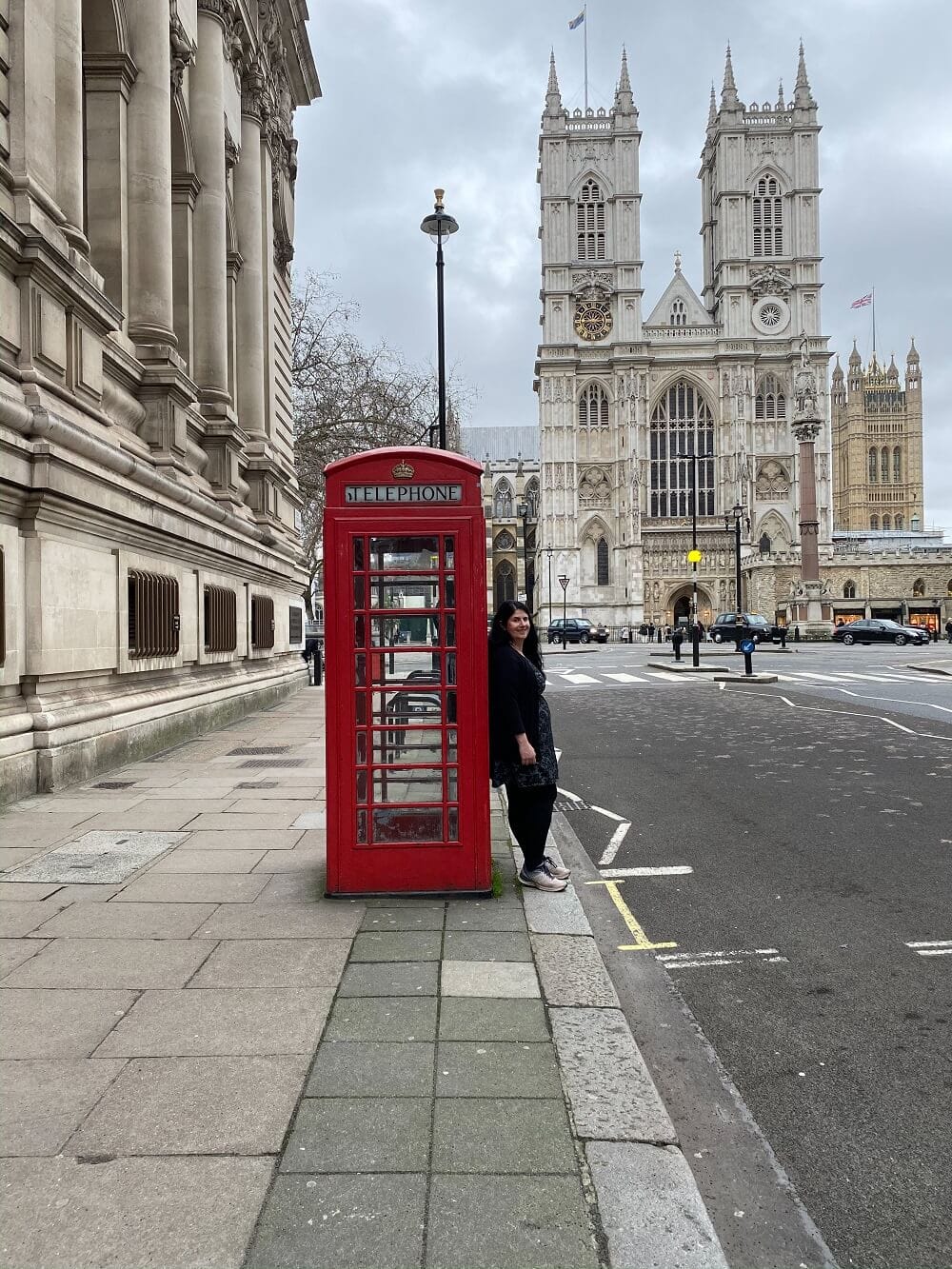
Things to Know Before Visiting Westminster Abbey
Westminster Abbey is a popular tourist attraction that is also a place of worship. There are a few things that need to be arranged before you visit.
No backpacks or bags (other than purses) are allowed inside. There is no place to store bags at Westminster Abbey. This means you must check bags somewhere else in advance.
We used LuggageHero to store our bags. You can use the app or website to find locations that are convenient. We chose to store our bags at the Victoria Station Hotel as it offers storage 24 hours a day. It’s not the fanciest hotel, but for bag storage it is fine. They give you locks for your bags and they are insured. What I like most about LuggageHero is that you only pay for the time that the bags are stored. If you want to try LuggageHero, use the code TEXANHERO to get two free hours. Click here to make a reservation .
You can also store bags at Charing Cross or Victoria train stations but it will be more expensive. While you don’t need a reservation to store bags at the station, you will get priority service if you do. Click here to get more information .
Download the Westminster Abbey App here . It has the same information as the audio tour. You have to turn in the audio tour after Poet’s Corner, but you can keep listening to the app even after your visit. In addition to downloading the app, set up the offline mode before your visit. I wish I had as I had some difficulty with the lack of data service. You can find the option in the hamburger menu on the top left of the app.
Wondering what to wear? While there is no official dress code for Westminster Abbey, they ask that you dress respectfully and men remove hats. It can be a bit chilly inside the Abbey during the winter months so bring your jacket. Additionally, the floor is uneven in places, so please wear practical shoes (i.e. no stilettos).
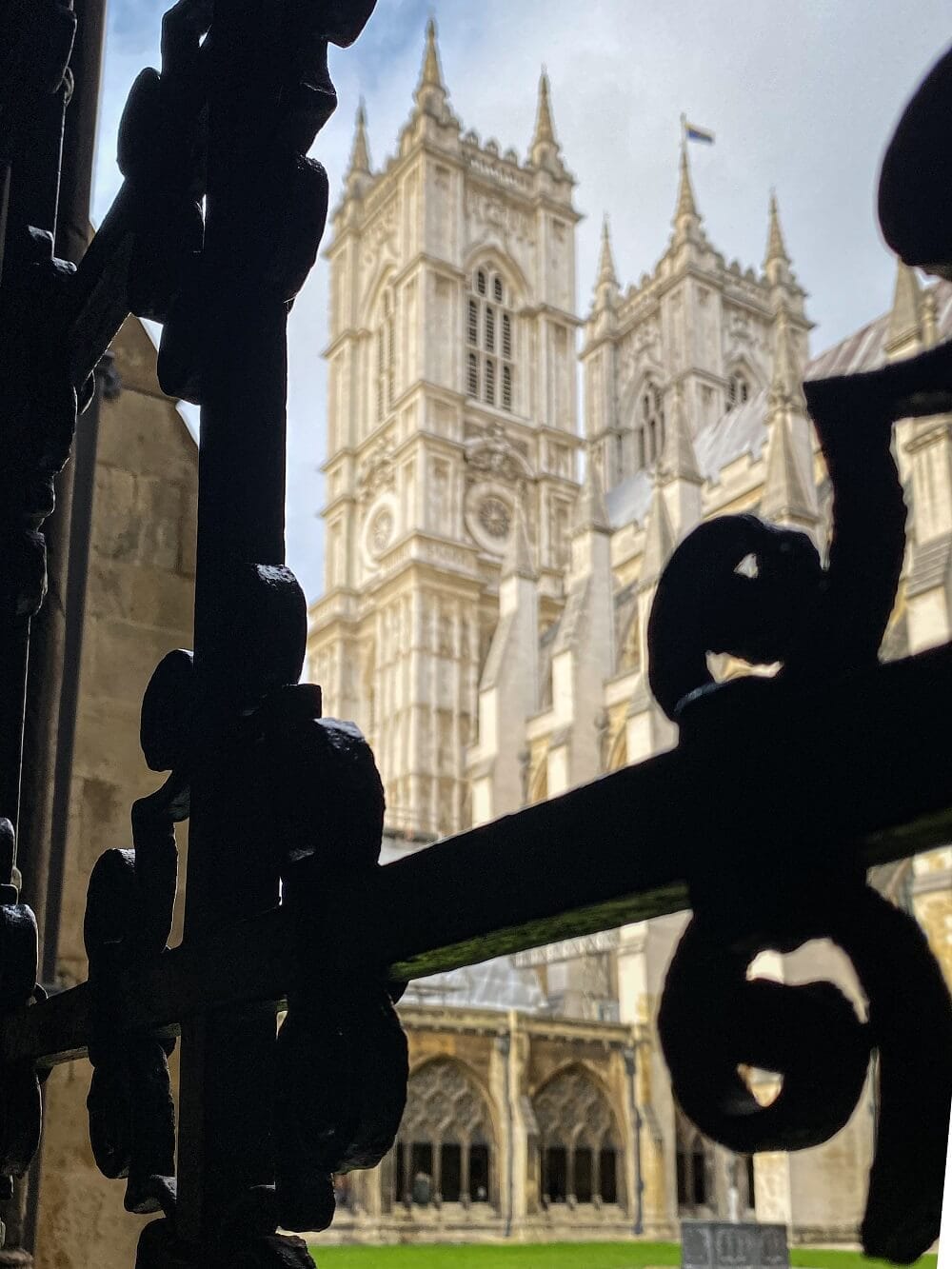
Due to its historic nature, there are some parts of the Abbey that are not accessible to those that have mobility issues. Those visitors and their carers get free admission and need to enter the Abbey through the North Door.
The Abbey has special tours for visually-impaired visitors and those with hearing difficulties. They also allow you to bring guide dogs, hearing dogs, and assistance dogs.
Get more information about disabled access at the Abbey here .
It depends on how many plaques you want to read. We spent a little more than three hours inside, but there were a few memorials that we still missed and we rushed through the Queen’s Galleries. If you are tight on time and want to see as much of the Abbey as possible then it might be best to do the guided tour.
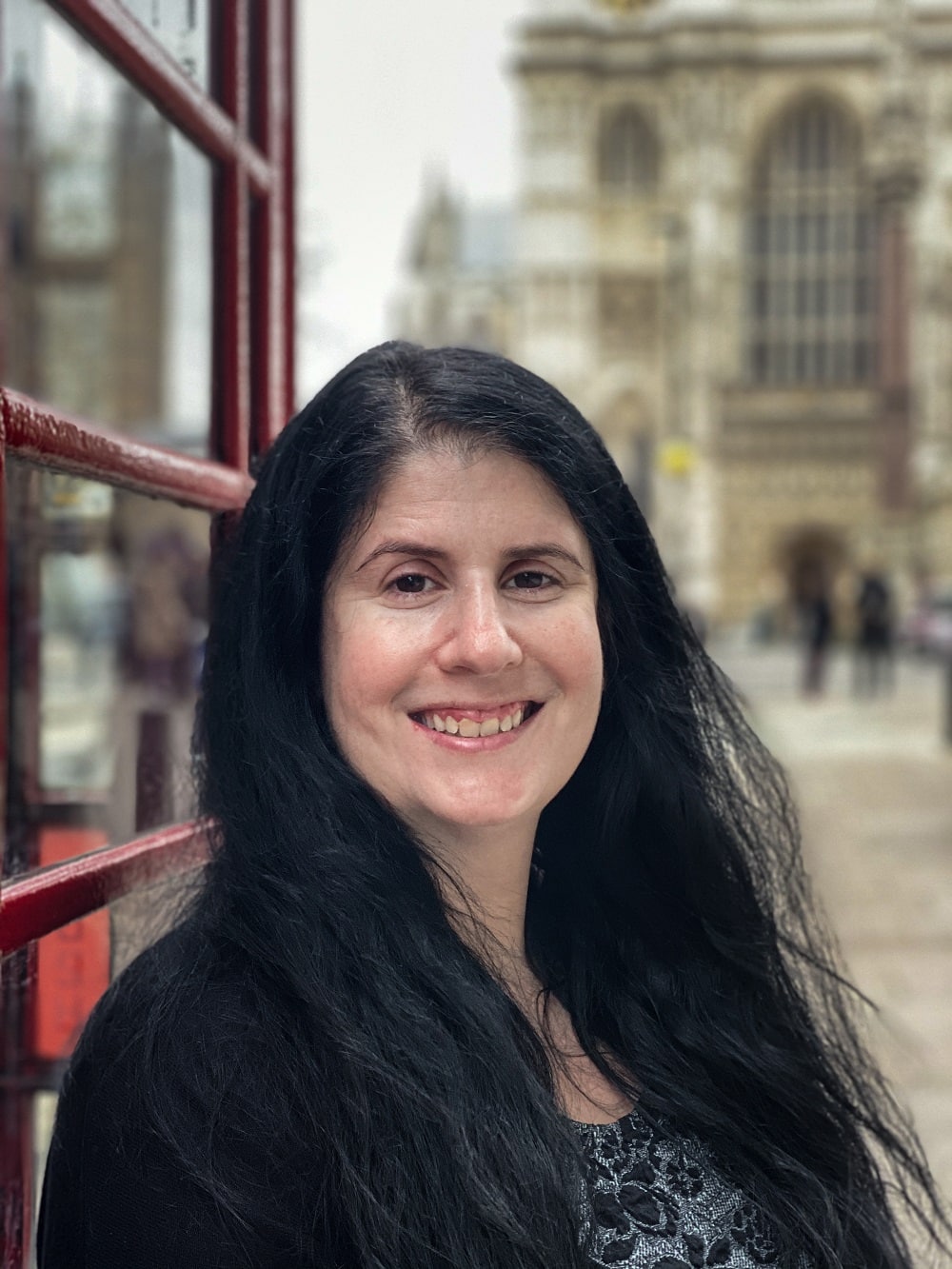
Children are welcome at Westminster Abbey. Keep in mind it is a place of worship so they need to be respectful. They have a booklet called the Children’s Trail, which is available by the entrance for free, to make the visit more interesting for them.
At the Cellarium, they offer one free meal from the kids’ menu with every adult main meal that is purchased. They also have a free coloring sheet to help keep the kids entertained.
If we were to visit again I think I would pay extra for the guided tour. At Westminster Abbey, these tours are led by vergers, who are not part of the clergy but assist in the ordering of religious services. They know the history and traditions of Westminster Abbey better than anyone.
During our visit, we ran into the guided tour a few times and I overhead a bit. They were definitely getting more inside information than what was provided in the audio tour. Additionally, guided tours get to go into Edward the Confessor Shrine.
I think it would be worth the £7 charge for the tour. (Note: You have to pay admission to Westminster Abbey too). Space on the guided tours is limited to 20 people and commentary is in English only. It lasts about 90 minutes. They only offer a few tours per day, the schedule varies depending on the time of year and day.
You cannot purchase tickets for these verger tours in advance, they must be booked upon arrival at Westminster Abbey.
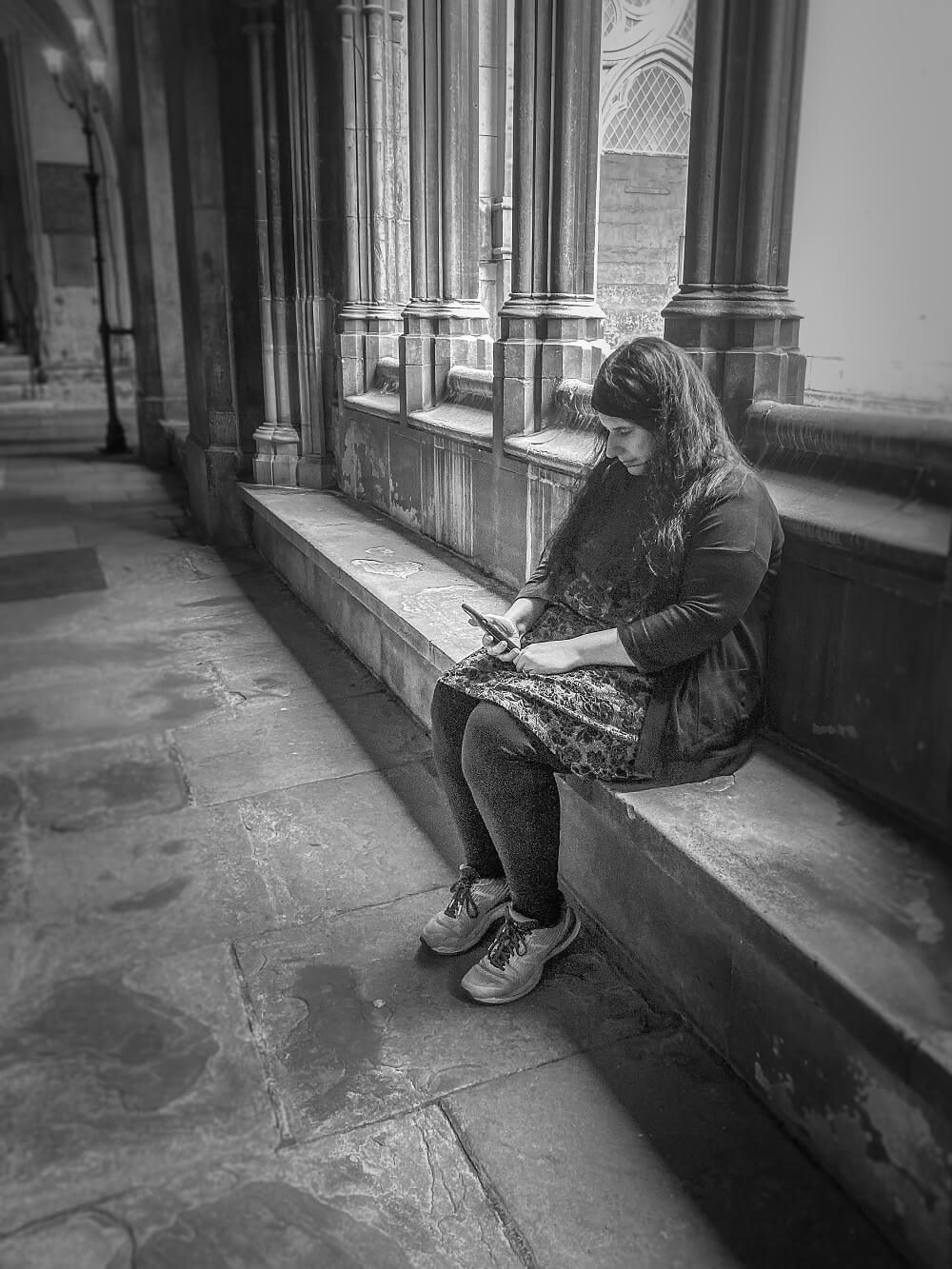
If you have a whole day to go sightseeing in the area there are several other attractions nearby:
- Parliament Square is just to the north of Westminster Abbey. Walk around and see the 12 statues of British and international political figures.
- Houses of Parliament/Big Ben are located to the east of the Abbey. You can tour the Houses of Parliament. Unfortunately, Big Ben is under renovation. If you want to visit both Westminster Abbey and the Houses of Parliament, consider taking this exclusive guided small group tour .
- Jewel Tower is around the corner from Westminster Abbey. It was built around 1365 to house Edward III’s treasures and was known as the ‘King’s Privy Wardrobe’. It is an English Heritage site, so English Heritage members or those that buy the English Heritage visitor’s pass can visit for free.
- London Eye is the large Ferris wheel with panoramic views across the Thames.
Yes. I was surprised by how much there is to see inside the Abbey. The history is awe-inspiring and will leave you wanting to learn more. It is amazing to think about all the important events that have taken place here from coronations to ceremonies, to weddings, to funerals over the years. I am not sure there is anywhere else where you can see graves and memorials to so many influential people.
Since it’s an indoor attraction, it can be a smart way to escape the bad weather in London during the winter . Even on a nice day, you won’t mind spending time inside the Abbey.
Don’t let the price tag put you off. I can understand why they charge to go inside this church as I can only imagine the upkeep costs. It is a UNESCO World Heritage site for good reason!
Have you been to Westminster Abbey?
If you found this post helpful, you can join our email community here or follow the blog on Bloglovin here .

- Don’t bring any backpacks or bags other than purses. Use LuggageHero to store them in advance.
- Download the Westminster Abbey app in advance here .
- Save money on your visit by either buying tickets in advance, taking advantage of Wednesday Lates, or by purchasing the London Pass .
Disclosure: Thanks to Westminster Abbey for providing complimentary tickets so that we could share our experience with our readers. All opinions are our own.
This post also contains affiliate links. This means we will receive a small commission for some purchases made using links in our blog with no additional cost to you. Please be assured we would not promote any product unless we believe that our readers will also benefit. The commission does not influence the editorial content of this site.
Last Updated on June 14, 2023
About the Author
Anisa
Anisa is an experienced international traveler with extra pages in her passport and stamps from 41 different countries across 5 continents (and counting). She was born and raised in Texas. After a 13 year stint in NYC, she moved to England to live with her husband.
Session expired
Please log in again. The login page will open in a new tab. After logging in you can close it and return to this page.
Sign Up Below to Download our FREE Travel Planning Checklist
London Travel Guide: Westminster Abbey
A trip to London is not complete without a visit to Westminster Abbey. Although its correct name is the Collegiate Church of Saint Peter, Westminster, it has been known as Westminster Abbey since it first opened for worship in 1065, and Westminster Abbey it will remain.
The Abbey is still a working church dedicated to regular worship services, although it is no longer an Abbey since it does not house monks or nuns.
Westminster Abbey is a “Royal Peculiar” which means it is subject only to the sovereign, and not to any bishop or archbishop.
History of Westminster Abbey
In 1065, a large Romanesque-style stone church was completed. It had been commissioned 25 years earlier by King Edward I. Unfortunately, Edward was too sick to attend the dedication of the church and he died just a few days later.
Through the years, the Abbey has been remodelled, repaired, and refurbished. In the 1200s, King Henry III decided to rebuild the Abbey in a Gothic design with fan-vaulted ceilings and that is essentially how it has remained. In 1937, a massive pipe organ was installed for the coronation of Edward VI.
Prominent Events Occurring at Westminster Abbey
From the first day it opened, the Abbey has been the site for special events, particularly for coronations, weddings, and funerals.
Coronations
Every coronation ceremony since 1066 has been held at Westminster Abbey. The current queen, Elizabeth II, was crowned in this church in 1953 in a ceremony that was, for the first time, broadcast on television and aired around the world.
In 1937, Elizabeth’s father, George VI, was crowned at the Abbey after his brother, King Edward the VIII, abdicated the throne.
Weddings
Westminster Abbey is a popular venue for royal weddings. There have been a total of 16 weddings since the church opened its doors. Queen Elizabeth II and Prince Philip wed here in November 1947. Two of Elizabeth and Philips’s four children, Prince Andrew and Princess Anne, followed their parents’ example and also had their wedding ceremonies at the Abbey.
The most recent, so of course, the most memorable wedding to take place in Westminster Abbey was the 2011 nuptials of Prince William and Kate Middleton, now the Duke and Duchess of Cambridge. The event was attended by more than 2,200 people.
Other weddings of note that have been held at Westminster Abbey include Princess Margaret, sister of Queen Elizabeth II, in 1960, and in 1923, King George VI, father of Queen Elizabeth II.
When visitors walk through Westminster Abbey, they notice markers on the floor with names of well-known poets, artists, authors, and composers. Other historical names include prime ministers, kings, queens, and aristocrats. It does not take long for a person to realize the people memorialized by those markers are buried underneath the Abbey floor.
Approximately 3,300 people are buried at Westminster Abbey. The bodies are kept in vaults underneath the floor and a commemorative plaque is placed on the floor in that person’s honour. Often, the body is right under the plaque. Other times, it is just nearby.
The most recent burial to take place in the Abbey was that of Stephen Hawking, mathematician, physicist, and author. Hawking died in 2018 and his ashes were buried near those of Charles Darwin, naturalist and famous author of “On the Origin of the Species,” which was published in 1859. Also buried nearby is Isaac Newton, an astronomer, alchemist, physicist, and author who died in 1727.
In 1989, the actor Sir Laurence Olivier died, but his ashes were not buried in Westminster Abby until more than two years later, in 1991. They were placed near those of other British actors, David Garrick and Sir Henry Irving. They are all near the Shakespeare Memorial .
A brief list of those whose names visitors will see as they walk through the Abbey and look down at the commemorative plaques are:
- David Livingstone, writer, physician, explorer, and missionary.
- George Fredric Handel, one of the greatest Baroque composers. There is a memorial plaque for Handel as well as a monument above the plaque that was carved by the sculptor Louis Francois Roubiliac.
- Geoffrey Chaucer, the poet. He is buried in the Poet’s Corner with more than 100 others, including Charles Dickens, Rudyard Kipling, Thomas Hardy, Robert Browning, and Alfred Lord Tennyson.
- Lewis Carroll is buried there, as are all of the Brontë sisters (Anne, Charlotte, and Emily), Oscar Wilde, Dylan Thomas, W. H. Auden, and Jane Austen.
There is a Grave to the Unknown Warrior that honours those who lost their lives fighting in WWI. This is the only grave or memorial in the entire Abbey that visitors are not allowed to walk on.
Funeral services for Princess Diana were held at Westminster Abbey, although she wasn’t buried there. She was buried on the private grounds of her family home.
A Visit to Westminster Abbey
If you visit London, you must visit Westminster Abbey. It is located on Parliament Square directly across from Big Ben and the Houses of Parliament. Buckingham Palace is only a 10-minute walk away.
You can get there from any Underground station. You can ride a bus or hop on a riverboat. A taxi can also take you there.
The Abbey is open every day except Sunday from 9:30 a.m. to 3:30 p.m. On Wednesdays, it is open until 6 p.m. On Sundays and other religious days, like Christmas and Easter, the Abbey is open for worship only. Anyone is welcome to worship, and no one will be turned away. On days of worship, there will be no tours of the rest of the Abbey.
Visitors are advised to dress modestly and remember that Westminster Abbey is a church. Wearing shorts, bare shoulders, and short dresses should be avoided.
Adult tickets are approximately $27. Children under age 5 are free. There are family rates and discounts for seniors. Audio guides in 14 languages are free with the entrance ticket.
Remember To Check Out Our Most Popular Posts:
The Cotswolds: The 20 Best Places To Visit
English Villages | What Makes The Perfect Village In England (With Examples)
Visit Yorkshire, England: York, The Dales & More
English Cathedrals: The 20 Best Cathedrals In England
The Best 20 Castles To Visit In England
London Travel: The Ultimate Guide. Tips, Attraction Reviews & More
The Kings And Queens of England: From William the Conqueror To Charles III
British Insults, Slang & Phrases: The Ultimate Guide
10 Fun Facts About England: Weird English Traditions
The Yorkshire Dales | The Best Places To Visit
Gorgeous Images Of The English Countryside
Visit Somerset, England: Cider, Bath, Glastonbury & More
20 Gorgeous English Thatched Cottages
Take our London Quiz: How Well Do You Really Know London?
Click Here For More On London > London Travel
Terms and Conditions - Privacy Policy

Velvet Escape
go explore. experience. and be inspired.
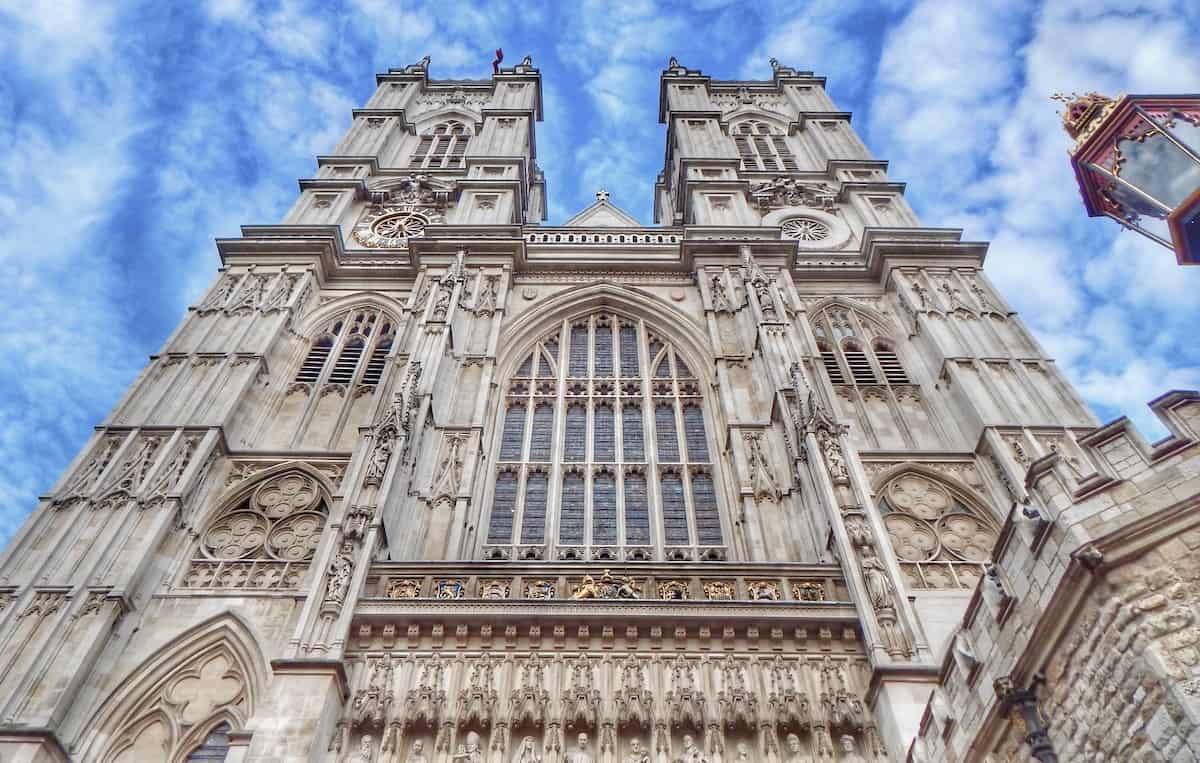
A self-guided tour of Westminster Abbey
Westminster Abbey is one of the London landmarks that I always think takes an entire day to itself. I know some people ‘do’ it in an hour and a bit, but it is the sort of place that richly repays a more leisurely, lingering visit. And there’s far more to it than it being simply where Wills and Kate tied the knot! There are countless historic and artistic details to see in Westminster Abbey. Scroll down for my self-guided Westminster Abbey tour.
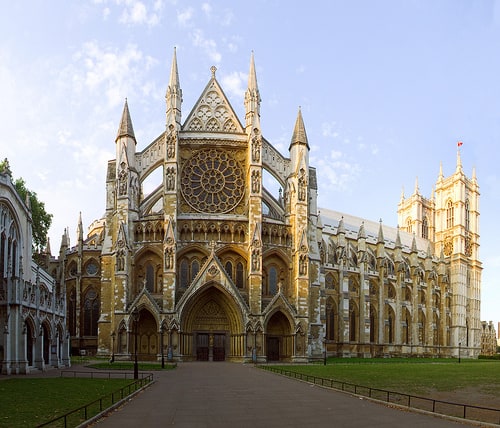
Originally a monastic church (founded by Edward the Confessor, though none of his building survives), it became the coronation church of the English monarchs; only two since 1066 have not been crowned here, Edward V and VIII – and that’s because they weren’t crowned at all (Edward V was one of the ‘Princes in the Tower’ who disappeared mysteriously and Edward VIII abdicated to marry Wallis Simpson). It’s not surprising then that it holds the tombs of many English kings and nobility; but it also fulfills part of the role of the French Pantheon, with Poet’s Corner commemorating English writers.
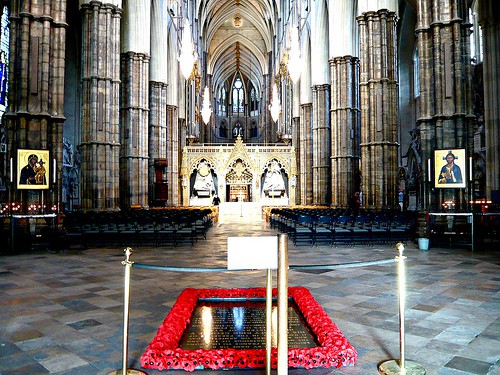
What to see in Westminster Abbey
Most visitors head there for its history – the tomb of the Unknown Soldier, the Coronation Chair (now minus the Stone of Scone though, which has been returned to Scotland). But there is also a huge amount of art history in the Abbey – as well as some oddities. I’ve mixed them up together in this article; I’ve also suggested some ways you can link your visit with other nearby monuments and sights, for instance going on to the National Gallery or Charing Cross or across the road to Westminster Hall.
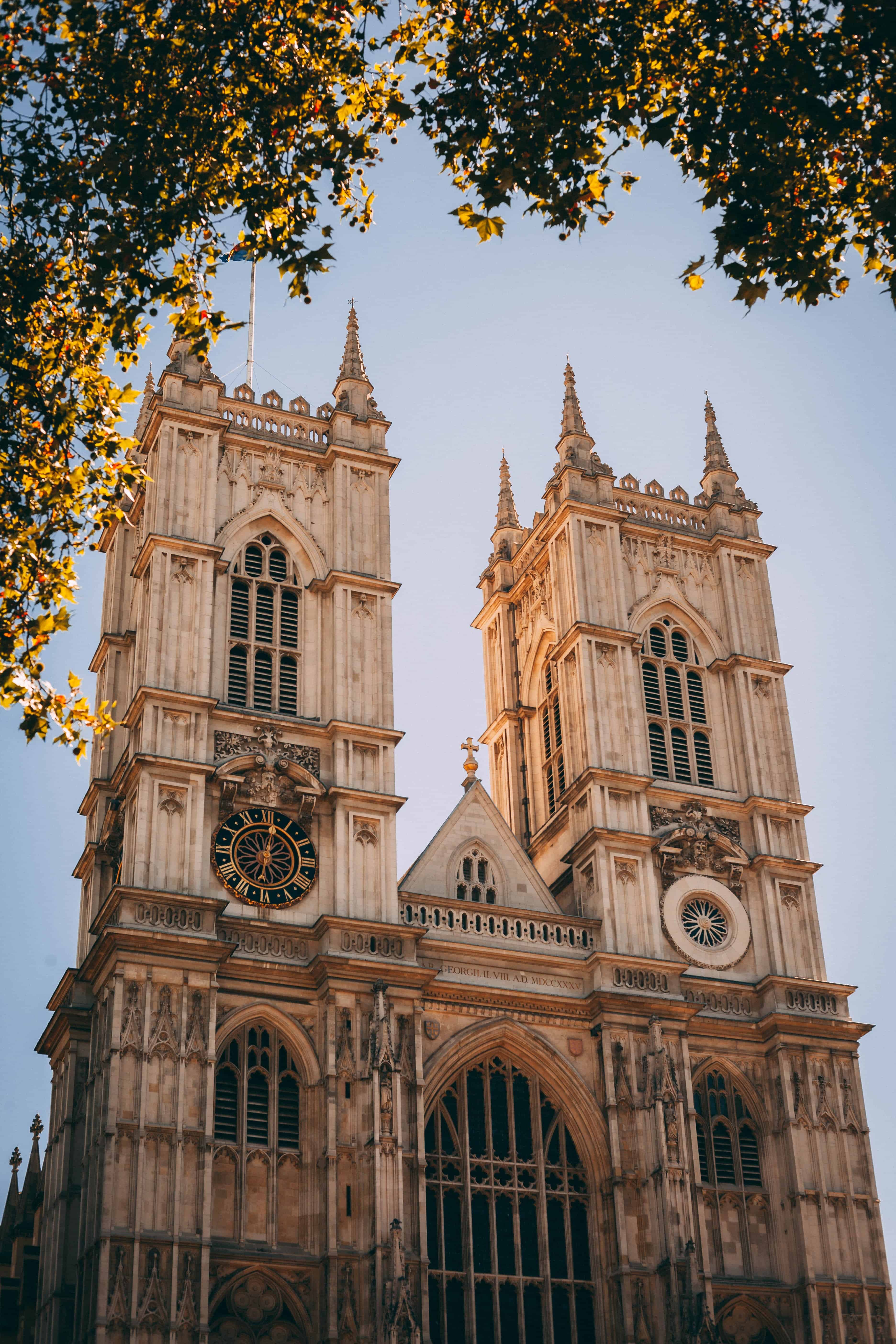
By the way, the monuments are actually quite a good way to acquaint yourself with the evolution of western art, from the Middle Ages through to the present day.
You can quite easily follow the changes in taste – medieval kings lying in state, formal and linear; the Renaissance tombs, more realistic, showing their inhabitants reclining or kneeling; the eighteenth century with its weeping angels and figures of death with his scythe, and often with symbols taken from real life – cannons, telescopes, ships; and even modern works, such as the stained glass window commemorating the airmen of the Battle of Britain.
Self-guided Westminster Abbey tour
Great vault.
As you come into the Abbey you’ll see the great vault that covers the nave. People will often tell you that medieval architects were anonymous – but this one certainly wasn’t; it’s the work of Henry Yevele, started in 1362. We know a lot about Yevele; he worked at Canterbury Cathedral and on several of the king’s castles and palaces, and he also built the amazing roof at Westminster Hall, just across the road. So as you go out of the Abbey, take another look at the vault; and then, if you can get on a tour of the Palace of Westminster, you’ll be able to compare his other great work with this.
Painting of Richard II
The painting of Richard II that hangs at the west end of the Abbey is something many visitors miss. Richard was a great patron of the arts, which he used to promote his concept of sacred kingship. Politically, it was a failure – he was deposed by Henry IV and died in suspicious circumstances not much later on – but artistically, it created the most elegant and beautiful art of the English middle ages. He was also a patron of the poet Chaucer. You can compare this painting to his tomb effigy (also in the Abbey), then walk up the road to the National Gallery to see the Wilton Diptych, a tiny gem-like painting of the king with his patron saints and choirs of angels.
Cathedral Museum
The royal effigies in the cathedral museum are an incredible witness to history; they were not intended to decorate the tomb, but were placed on top of the coffin for the royal funeral. Again there’s a comparison to be made; Edward III’s funeral effigy has the drooping mouth of an old man killed by a stroke (and originally had eyebrows made out of dogs’ hair) – but his fine tomb effigy shows the mature king in his pride, with flowing hair and sad dignity.
Chapel of Henry VII
There are only three competitors for the prize of best English Perpendicular Gothic – Gloucester cathedral cloister, King’s College Chapel and the wonderful Chapel of Henry VII here in the Abbey. This is certainly the most fanciful of the three, with pendant bosses like stalactites and the most complex tracery in its vault – and the outside, with its pinnacles and golden weather vanes, is also exceptional.
Henry VII was a king who stood at the frontiers of the middle ages and the Renaissance and it’s quite fitting that while the chapel is the last flourish of Gothic, his tomb and effigy should be by an Italian artist, Pietro Torrigiano, who had studied with Michelangelo (and reputedly smacked the senior artist one on the nose during a dispute). You can see how realistic the figure is compared to earlier tombs – the drapery looks real, the face is a naturalistic portrait (the tomb of Margaret Beaufort, Henry’s mother, is also by Torrigiano). Look out for the heraldic badges that decorate the chapel – the daisy or Marguerite (for Margaret), the Beaufort portcullis, the lions of England and fleur de lis of France, and Edward IV’s badge of the falcon with padlock.
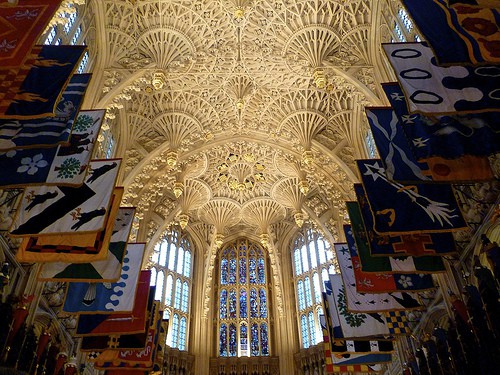
Coronation Chair
Of course you’ll want to see the Coronation Chair . But it’s just a chair, albeit a very ornate medieval one. The thing I really love about it though, is the set of little lions that support it. The chair dates from 1297, but the lions were only added in 1727 as replacements for ones that were a couple of hundred years older. But oh my goodness don’t they look disgruntled! They certainly want you to think they’ve been oppressed by the massive oak weight of the chair for more than just a couple of centuries.
Effigy of Eleanor of Castile
The effigy of Eleanor of Castile is a lovely work by William Torel, goldsmith, dating from 1291. Torel made it by casting a bronze figure by the lost-wax technique, then gilding it; the sculpture is noble and magnificent. Torel actually made two – one for the cathedral in Lincoln where Eleanor died, and this one for where she is buried. Along the way, her heartbroken widower Edward I erected Eleanor Crosses where her body rested – you can see a replica of the original at Charing Cross just up the road. Ironically, Edward has no effigy at all – just a plain marble tomb. Torel also made the effigy for Henry III.
Newton’s tomb
Newton’s tomb is a magnificent creation of the Enlightenment to contrast with the medieval work you’ve seen elsewhere. Little boys use the telescope and play with the prisms. Does the globe look a bit strange? That’s because it’s a celestial globe showing the zodiac, not the earth – and a figure of Astronomy sits on top of it.
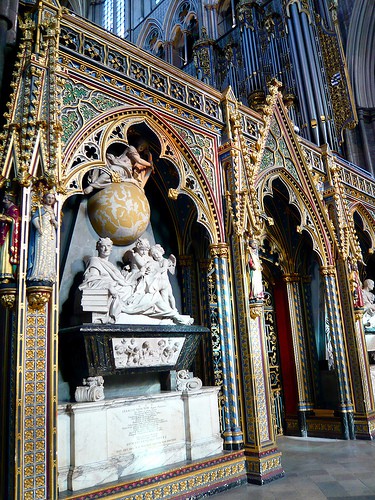
Grave of Ben Jonson
In the north aisle, don’t miss the tiny gravestone of Shakespeare’s contemporary Ben Jonson, with its inscription: ‘O rare Ben Jonson’. Its small size is explained by the fact that he was buried standing up – to save paying for a larger space!
The West Front of the Abbey is one of my favourite London fakes. It’s not medieval at all, even though it looks it. It was in fact designed by Nicholas Hawksmoor and Christopher Wren, whose other works are uncompromisingly modern (like St Paul’s Cathedral, for instance). If you want to see a real medieval façade, look at the north entrance, opposite St Margaret’s church, and you’ll see the difference.
Elizabeth I
Elizabeth I , if you ask me, got the short straw when they handed out Renaissance art. Her grandfather Henry VII got a magnificent tomb by the Italian, Torrigiano; she got a work by Flemish artist Maximilian Colt which, while majestic, and probably realistic, certainly doesn’t show her at her best. A hook nose, a sour frown and a double chin. She also has to share her grave with her half-sister, Mary I. Since Mary imprisoned Elizabeth and might well have considered having her executed, I don’t think either of them would have been too keen on the tomb-share.
The little cradle
Much cuter is the monument Colt made for Sophia Rosula Stuart, the baby daughter of James I – a little cradle . He also made the memorial for her sister Mary Stuart, who died at just two and a half. Both of them are in the north aisle of Henry VII’s Chapel.
Heraldic beasts
Heraldic beasts come in all sizes and shapes – the porcupine at the feet of Lady Frances Sidney is my favourite (in St Paul’s chapel), bristling with real spikes in blue and gold – though the ferocious red lion on the tomb of Mary Queen of Scots runs it close.
Chapter house
Don’t miss the chapter house , with its single pillar supporting the roof and fine medieval tile pavement. Look particularly at the lovely crisp leaves of the capitals, delicate but decisive carving. This chapter house, incidentally, has a place in the history of English democracy – the first King’s Councils were held here, before moving across the way to the Palace of Westminster.
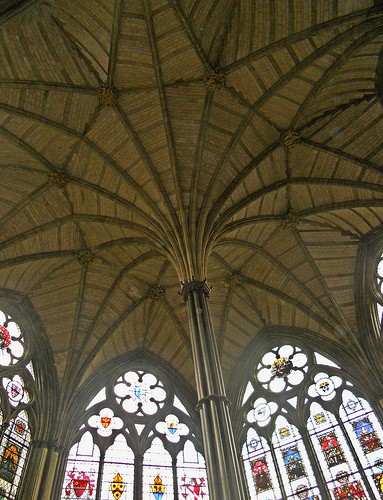
Cosmatesque pavement
I was in two minds about whether to mention the Cosmatesque pavement , because it is apparently quite often invisible. It’s highly unusual, because the Cosmati family of masons worked in Rome and southern Italy, and you hardly ever see their marble inlay work anywhere else. Henry III brought the master Odericus from Rome to create this masterpiece – it’s a strictly geometrical pavement, designed around a quincunx – five linked roundels. It bears an inscription which makes it quite clear that it’s a microcosm, a symbolic representation of the universe; weirder and more convoluted than anything you’ll find in the Da Vinci Code (which leaves it out)!
Islip chapel
Look out for the pun in the Islip chapel . Abbot Islip built it as a chantry where prayers would be said for his soul, and he decorated it with his rebus, a play on words – it shows an eye and a ‘slip’, a small twig or branch, giving ‘eye-slip’, his name. But there’s a second one, as well, on the lintel – a little man falling out of a tree – ‘I slip!’ I bet the good abbot did cryptic crosswords.
Finally…
Please don’t call Westminster Abbey a cathedral. It’s actually a royal peculiar – that is, a place of worship that falls under the monarch’s jurisdiction and doesn’t belong to a diocese, with the status of a collegiate church. It was originally the church of a monastery and was only ever a cathedral for ten years, from 1540 to 1550. If you want to see a cathedral, you’ve got two choices – St Paul’s is the cathedral of the Anglican diocese of London, while a little closer to the Abbey, Westminster Cathedral is the church of the Roman Catholic diocese of Westminster.
You’re most welcome to print out this blog post as your guide to Westminster Abbey. Alternatively, you can purchase an entrance ticket that includes an audio guide .
Read about other things to do in London
- Alternative ways to explore London
- Classic views of London
- A walk through London’s Theatreland
- Unravelling the mysteries of Covent Garden
Related Posts
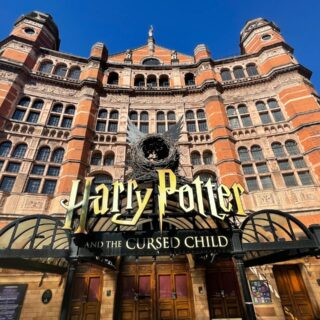
Subscribe to get the Velvet Escape Newsletter in your inbox!
9 Responses
[…] Read my guide to Westminster Abbey […]
[…] Image source […]
[…] much a part of the experience when visiting the capital city as riding on a red double-decker bus, touring Westminster Abbey and watching the changing of the guard at Buckingham Palace.Enjoyed as an alternative to afternoon […]
What a fantastic journey through Westminster Abbey…I was blown away by the abbey during William and Kate’s wedding and loved how they added the greenery to “spruce” up the place…pun intended. This article is a keeper!!
Beautiful! Westminster Abbey is definitely on my list of places to see in England. It looks really interesting.
I’ve always been fascinated by the fact that very few poets are buried in Poet’s Corner. Who ever knew that Chaucer was a tax collector?
We went three weeks ago–had the place almosrt entirely to ourselves–in mid-January. Winter is the best time to go to major London tourist attractions. Found the same ease and comfort at The Tower of London, a few days later. Had a terrific Blue Badge Guide (Abigail) at Westminster Abbey and she covered all the major sights that you have outlined–without making us feel hurried. At the very end, we had to rush through the museum where an ancient altarpiece is the focal point–but that’s because members of our party were exhausted. I did blog about our visit myself. Please see my blog post: http://rochellesroost.blogspot.com
Thanks Lane! That’s a great tip! 🙂
Cheers, Keith
Great article. You covered everything that we missed. I’ve been twice and was so hurried by the push of crowds, that we missed half of this great Abbey.
Can I recommend go very early?
Leave a reply
Save my name, email, and website in this browser for the next time I comment.
This site uses Akismet to reduce spam. Learn how your comment data is processed .
Appeared In

- Skip to main content
- Skip to primary sidebar
- Skip to footer

The Best Westminster Abbey Tours To Take in 2024 and Why
Brie Greenhalgh Last Updated: September 26, 2023
You’ve seen Westminster Abbey on TV for famous weddings, funerals, and other ceremonies, but have you ever visited? The long lines can make for a slow and crowded visit, so booking a guided tour with skip-the-line access is a good idea. Here are some of the best Westminster Abbey tours you can take in London.
Pro Tip: Planning what to do on your trip to London? Bookmark this post in your browser so you can easily find it when you’re in the city. Check out our guide to London for more planning resources, our top London tours for a memorable trip, and how to see London in a day .
Should You Take a Tour of Westminster Abbey?
Short answer: Definitely, since there’s literally 1,000 years of history to discover here!
The history of Westminster Abbey starts around 785 A.D. with a small monastery that became a church in 1065. Multiple remodels and renovations later, we have this magnificent abbey that has held Britain’s coronations since William the Conqueror.
It’s also famously been the site of Kate Middleton and Prince William’s wedding, the oldest son of Britain’s beloved Princess Diana. And it was here at Westminster where Diana’s funeral captured the attention of nearly 2.5 billion people around the world. And that’s just recent history! It doesn’t include other notables like Stephen Hawking, Sir Isaac Newton, George Frederich Handel, and many more who are buried here.
Long story short, there’s a lot to see, explore, and learn about at Westminster Abbey. Booking with a guide who is passionate and ultra-knowledgeable about London’s famous church will make your trip much more meaningful.
It elevates the experience from a photo session to a learning experience of cool stories and facts. Not to mention the benefit of skip-the-line tickets! Here are some of our recent reviews about Westminster Abbey tours.

Not ready to book a tour? See our Westminster Abbey Guide for more info.
Two of the Best Westminster Tours in London
The most complicated thing about visiting Westminster is navigating the lines and crowds. Although, we’d also argue that there is just so much to see here that the history is also fairly complicated to discover on your own.
That’s why we always recommend seeing famous monuments with licensed guides. Their expertise and passion for the history of places like Westminster elevates your visit. With stories, anecdotes, and fun facts, they’ll be sure to make your trip entertaining, enlightening, and rewarding.
We offer two tours of Westminster Abbey that you can choose from. One is dedicated to a tour of the church, while the other includes the church in a full day of touring London. So check them out below and see which Westminster tour is right for you!
- London Walking Tour with Westminster Abbey and Changing of the Guard
- London in a Day Tour with Westminster Abbey and Tower of London
2. London Walking Tour with Westminster Abbey and Changing of the Guard
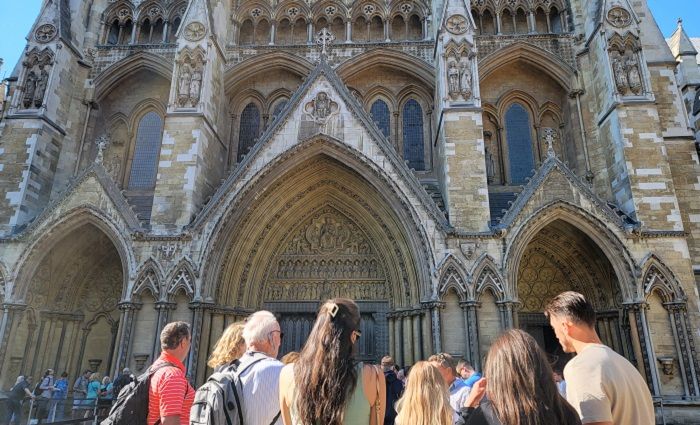
Westminster Abbey
Clients love our skip-the-line access to the famous Westminster Abbey where they can enjoy a few minutes of quiet time with their guide in the nave of the abbey before the public enters. This is the oldest part of the entire church, and your guide will share its unique history as you stand in near-quiet solitude here.
With over 3,000 people buried here over the centuries, it’s hard to decide exactly what to see and who you’re looking at. This is where your guide will come in handy as they take you to the Poet’s Corner and other notable tombs that are the highlights you can’t miss. And of course, you’ll see the famous coronation chair at the High Altar across from the Lady Chapel.
Changing of the Guard at Buckingham Palace
Finally, you’ll also get a chance to see the famous Changing of the Guard ceremony. This happens every day in June and July, but only on Mondays, Wednesdays, Fridays, and Sundays the rest of the year. Your guide knows just how to help you see the most of this auspicious event.
Highlights:
- Skip-the-line entry to Westminster Abbey
- Guided visit of Britain’s most famous church
- Changing of the Guard ceremony (certain days)
- Pictures of Buckingham Palace
1. London in a Day Tour with Westminster Abbey and Tower of London
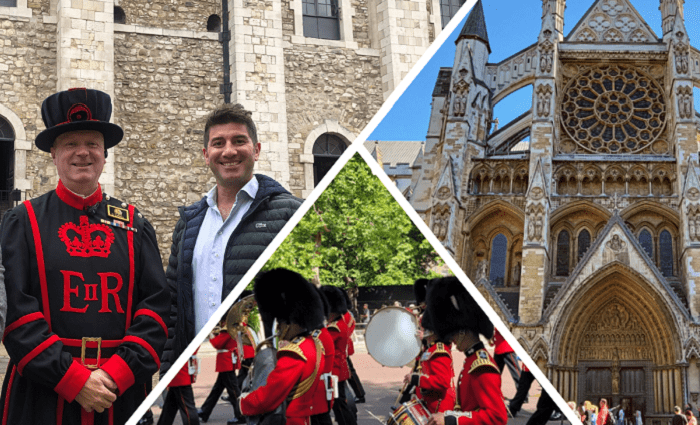
London is a great city to explore, but many of the sites are spread across long distances. That’s why we created this epic London in a Day tour. You’ll be amazed at just how much you’re able to see as you follow the steps of your licensed, local guide. We hire the best guides in London to make sure you have an incredible experience when you book one of the best Westminster Abbey tours that includes other top attractions in London.
Your day starts at Westminster Abbey with skip-the-line tickets and a guided tour of this ancient church. It’s the site of famous churches, funerals, and every British coronation ceremony since 1066 AD! There’s a lot to discover so you’ll appreciate having a guide who knows exactly where to spend your valuable time here.
Next you’ll head over to the Mall to watch the Changing of the Guard ceremony (certain days) or the Horse Guard. You’ll get more than a moment’s view of this famous event, since your guide will lead you through the entire process at Buckingham Palace.
You’ll likely have time to see Downing Street, the famous home of Britain’s Prime Ministers before heading to Trafalgar square to choose where to eat lunch. (And get off your feet for a bit!)
River Thames Boat Ride
Next, a ride down the River Thames is the perfect way to see London from a new angle. You’ll travel to your next stop: the Tower of London.
Tower of London
Here your guide will unveil the deep history of Britain’s oldest fortress that has Roman origins! Get to know the history of Thomas Moore, Anne Boleyn, Henry the VIII, Walter Raleigh and more. Plus, step into the museum where the ostentatious crown jewels are kept. This tour makes all of this easy to do and incredibly rewarding too.
- See the best of London’s top attractions in a single day
- Skip-the-line entry at Westminster Abbey
- Free time for lunch
- Transportation to Tower of London included
- Quick entry to Tower of London
- Entry to see Crown Jewels
- Free time to walk across Tower Bridge at the end of your tour
Not ready to book a tour? Find out if London tours are worth it .
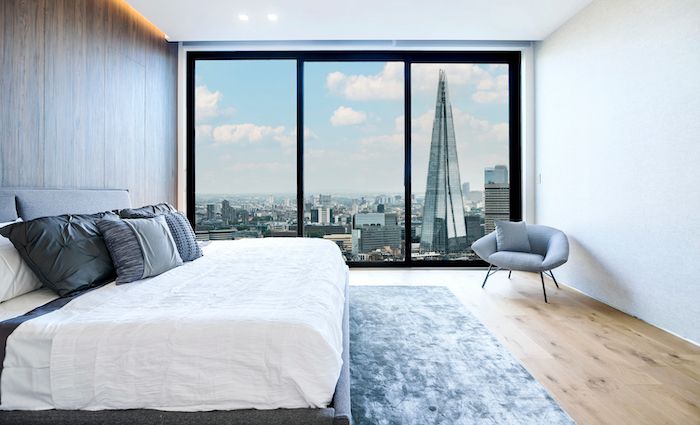
Find the best places to stay
Where To Stay in London
Deciding where to stay at a great hotel in London can take some effort since it’s a massive city. Make your decision easier with our list of the best neighborhoods and hotels in London.
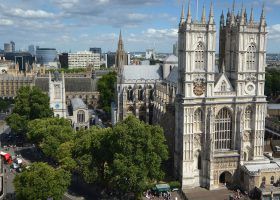
About Brie Greenhalgh
Writer, editor, teacher, hiker, traveler, dreamer. With a book or pen in hand and a majestic sunset on the horizon, life is never short of fulfilling moments for Brie. She has a background in history and writing, and enjoys writing and editing for BobVila.com, The Tour Guy, and her own business.
Reader Interactions
Leave a comment cancel reply.
Your email address will not be published. Required fields are marked *
- Travel Blog
- In The Press
POLICY & TERMS
- Cancellation Policy
- Terms & Conditions
- Privacy Policy

Cookies on GOV.UK
We use some essential cookies to make this website work.
We’d like to set additional cookies to understand how you use GOV.UK, remember your settings and improve government services.
We also use cookies set by other sites to help us deliver content from their services.
You have accepted additional cookies. You can change your cookie settings at any time.
You have rejected additional cookies. You can change your cookie settings at any time.
- Department for Culture, Media & Sport
How to watch the Coronation and processions (Saturday 6 May)
Updated 5 May 2023

© Crown copyright 2023
This publication is licensed under the terms of the Open Government Licence v3.0 except where otherwise stated. To view this licence, visit nationalarchives.gov.uk/doc/open-government-licence/version/3 or write to the Information Policy Team, The National Archives, Kew, London TW9 4DU, or email: [email protected] .
Where we have identified any third party copyright information you will need to obtain permission from the copyright holders concerned.
This publication is available at https://www.gov.uk/government/publications/the-coronation-of-their-majesties-king-charles-iii-and-queen-camilla/how-to-watch-the-coronation-and-processions-saturday-6-may

The Coronation of Their Majesties King Charles III and Queen Camilla will take place on Saturday 6 May. There will be ceremonial processions in London before and after the Coronation service at Westminster Abbey in London.
The service and processions will be broadcast on national television, radio and online, and shown on large screens at screening sites in London and around the country .
This guidance tells you how you can watch the processions in London in person, or visit the screening sites at Hyde Park, The Green Park and St James’s Park. To watch at another screening site, visit the Coronation.GOV.UK website to find events in your local area .
The accessibility section provides information for people with access requirements, including accessible viewing areas and quiet viewing spaces. It also includes a BSL (British Sign Language) video summary of the Coronation weekend .
Please be aware that large crowds are expected, and there will be road closures in place to ensure the event is delivered safely. Public transport services are likely to be very busy with some station closures and bus diversions, especially around the Westminster and Hyde Park areas.
About the Coronation
The Coronation of Their Majesties King Charles III and Queen Camilla will take place on Saturday 6 May. The first procession will begin at 10.20am. Their Majesties will travel in procession from Buckingham Palace to Westminster Abbey. This is known as ‘The King’s Procession’. Their Majesties will travel in the Diamond Jubilee State Coach, drawn by 6 Windsor Grey horses. The Household Cavalry will provide the Sovereign’s Escort.
The King’s Procession will travel along The Mall, through Admiralty Arch, passing to the south of the King Charles Island statue in Trafalgar Square before turning onto Whitehall. The procession will continue down Whitehall and along the east and south sides of Parliament Square, arriving at Westminster Abbey.
The Coronation service at Westminster Abbey will begin at 11am and finish at 1pm.
After the Coronation service, Their Majesties will return to Buckingham Palace as part of a larger ceremonial procession, known as ‘The Coronation Procession’. The Coronation Procession will last for around 30 minutes. Their Majesties will travel in the Gold State Coach, drawn by 8 Windsor Grey horses.
The procession will arrive at Buckingham Palace at around 1:30pm. Their Majesties will receive a salute from the United Kingdom and Commonwealth Armed Forces in the Buckingham Palace Gardens, and appear on the Buckingham Palace balcony. At 2:30pm, there will be a Coronation flypast by the Armed Forces over The Mall and Buckingham Palace (subject to weather, serviceability, and operational commitments).
Explore the procession route with Dan Snow
Learn more about the Coronation:
- The history of coronation ceremonies (official website of the British Royal Family)
- The King’s Procession and the Coronation Procession (official website of the British Royal Family)
- Coronations at the Abbey (Westminster Abbey website)
How to watch
- Both processions and the Coronation service will be broadcast live on national television, radio and online.
- Find out how to watch the processions in person .
- Please note that there will not be screens along the route. If you wish to watch the broadcast of events (including the Coronation service), you should visit one of the screening sites.
- Find out how to visit the screening sites in Hyde Park, St James’s Park and The Green Park .
- Find events in your local area .
- Find other ways to get involved in the celebrations , such as hosting a Coronation Big Lunch or street party, and taking part in the Big Help Out.
Screening the Coronation at events
The BBC has confirmed a special one-off TV licence dispensation for the Coronation of HM King Charles III. If you are hosting an event, you won’t need a TV licence to screen coverage of the Coronation on 6 May 2023, or the Coronation Concert on 7 May 2023. Find out more on the BBC’s website .
Plan your journey
This guidance contains information on:
How to get to London
- How to get to the procession viewing areas
How to get to the screening sites
Please note that the areas in and around Hyde Park, Buckingham Palace, Westminster Abbey, Whitehall, St James’s Park, The Green Park and Trafalgar Square will be very crowded. The National Rail and London Underground stations in these areas will be very busy.
It may be necessary for short-term safety measures to be put in place at transport stations, such as queuing, closures, trains not stopping at certain stations, or changes to the way customers enter or exit a station. Please follow the directions of stewards and police officers.
What you should do:
- Plan your journey using the Transport for London and National Rail Enquiries websites.
- Check Transport for London status updates and National Rail Enquiries latest travel information before you travel, and allow more time than usual for your journey.
- Find up-to-date travel information by following National Rail Enquiries on Twitter or downloading the TfL Go app .
- After the events, remember to check the latest travel information before your onward journey. Service updates may have changed.
- If possible, please avoid travelling immediately after the events, as services may be busy. There will be plenty of trains running during the day and into the evening.
The major railway stations in London include:
- London Blackfriars
- London Cannon Street
- London Charing Cross
- London Euston
- London King’s Cross
- London Liverpool Street
- London Bridge
- London Marylebone
- London Paddington
- London St Pancras International
- London Victoria
- London Waterloo
- London Waterloo East
Use the Transport for London journey planner to continue your journey to the viewing areas or screening sites. Please be aware that transport services are expected to be very busy before and after the Coronation service, and it is likely there will be queues at stations.
You can plan your journey within London using the Transport for London journey planner . Check which station you should travel to if you want to:
- get to the procession viewing areas
- get to the screening sites
Remember to check National Rail Enquiries latest travel information and Transport for London status updates before you travel, and allow more time than usual for your journey.
You can also keep track of the latest travel information by following National Rail Enquiries on Twitter or by downloading the TfL Go app .
After the events, police and stewards will direct you to the exits and to nearby transport hubs. Remember to check the latest travel information before your onward journey, as service updates may have changed.
If possible, please avoid travelling immediately after the events, as services are expected to be very busy. There will be plenty of trains running during the day and late into the evening. If you are planning on catching a late-night train, please check in advance when your last available service departs.
London Victoria station - limited access (Hyde Park screening site only)
On Saturday 6 May, many of the roads around Victoria station will be closed. There will be limited public access to the procession route, or The Green Park and St James’s Park screening sites, from Victoria station.
London Victoria station should be used for the Hyde Park screening site only. If you exit at Victoria station, you may be directed to the screening site at Hyde Park.
If you want to watch the procession or go to the screening sites in The Green Park or St James’s Park, you should travel to an alternative station. Check which station to use if you want to get to the viewing areas , or get to the screening sites , and continue your journey from Victoria on the London Underground.
Watch the processions in person
In this section:
The procession viewing areas
- Procession route - map and facilities
You can watch the Coronation processions through London in person at viewing areas along the procession route, on both sides of The Mall and Whitehall.
The viewing areas will be open from 6am on Saturday 6 May. Please do not arrive before 6am.
The King’s Procession from Buckingham Palace to Westminster Abbey will take place before the Coronation service, which starts at 11am. The Coronation Procession from Westminster Abbey to Buckingham Palace will take place after the Coronation service.
There is an accessible viewing area which can be used by people with access requirements, and a quiet viewing space. Read the accessibility section for more information .
You should be aware that large crowds are expected, and be prepared to queue to enter the viewing areas. Follow the directions given by stewards and the police, who will monitor crowd numbers and ensure everyone can enter safely and securely.
Capacity at the viewing areas will be limited and they will be closed when they are full. If you leave a viewing area at any time, readmission cannot be guaranteed.
If the viewing area you intend to visit is full when you arrive, you will be directed to one of the other viewing areas or a screening site . The screening sites will show all of the day’s events on large screens, including both processions, the Coronation service, and the balcony appearance. Entry to the screening sites is free.
After the Coronation Procession has passed down The Mall, the police will open the route to allow people to move onto the road. People will be able to walk down The Mall towards Buckingham Palace, to watch the balcony appearance. The police will monitor crowd numbers and gradually open the viewing areas, to ensure that everyone stays safe and secure.
Staying safe in crowds
- Follow the directions given by stewards and the police, who will monitor crowd numbers and ensure everyone stays safe and secure.
- Take care of your belongings. Keep your phone, wallet and purse out of sight and make sure any valuables are secure.
- If you notice anything suspicious, please inform the stewards or police.
Read more about staying safe in London (Metropolitan Police website) .
Procession viewing areas - map and facilities
The image below shows a map of the procession route: the King’s Procession from Buckingham Palace to Westminster Abbey, and the Coronation Procession back to Buckingham Palace. The procession route is marked in gold.
There are viewing areas along the procession route, on both sides of The Mall and Whitehall. The public viewing areas are marked on the map in purple.
The image also shows the facilities at the viewing areas and along the route. There are first aid points, water refill stations, toilets and accessible toilets, welfare points, and accessible viewing spaces . There are concession kiosks along the route where you can buy food and drinks.
The map also shows the nearby screening sites in The Green Park and St James’s Park , where you can watch the processions and the Coronation service on large screens.
View or download a larger version of the map , (PDF, 13.4MB).
How to get to the viewing areas
The table below tells you the recommended stations (London Underground or National Rail) to use for the viewing areas along the procession route. This may not be the station you would usually use, because of diversions and road closures.
There will be signs marking the walking routes, and stewards will direct you to the viewing areas.
Check before you travel
It may be necessary for short-term safety measures to be put in place at transport stations, such as queuing, closures, trains not stopping at certain stations, or changes to the way customers enter or exit a station.
Please note that on Saturday 6 May:
- St James’s Park station will be closed.
- Hyde Park Corner station will be exit only.
- Victoria station will have limited access to the procession route because of road closures. If you exit at Victoria, you may be directed to the Hyde Park screening site.
You should be aware that large crowds are expected, and the viewing areas will close when they are full. The viewing areas have limited capacity and may close before the events begin. Follow the directions given by stewards and the police, who will monitor crowd numbers and help people to stay safe.
After the events, police and stewards will direct you to the exits and to nearby transport hubs. Remember to check the latest travel information before your onward journey, as service updates may have changed. You can find up-to-date travel information by following National Rail Enquiries on Twitter or downloading the TfL Go app .
If possible, please avoid travelling immediately after the events, as services will be very busy. There will be plenty of trains running during the day and late into the evening.
Watch all events at the screening sites
- Hyde Park screening site (information and map)
- The Green Park and St James’s Park screening sites (information and map)
You can watch the Coronation at the Hyde Park screening site, which will show the processions and the Coronation service on large screens. There are also smaller screening sites at The Green Park and St James’s Park, but these are likely to reach capacity very quickly.
Access to all screening sites is free. There will be first aid points, water refill stations, toilets and accessible toilets, welfare points, and concession kiosks where you can buy food and drinks. Read more about facilities at the Hyde Park screening site , and The Green Park and St James’s Park screening sites .
There are accessible viewing areas and quiet spaces at each of the screening sites. Read the accessibility section for more information.
Please note that large crowds are expected. Follow the directions given by stewards and the police, who will monitor crowd numbers and help everyone to stay safe and secure. If you choose to leave a screening site during the events, you may lose your viewing position.
Hyde Park screening site
The Hyde Park screening site is located in the south-east corner of the park, covering the area around the Serpentine lake.
You can access the Hyde Park screening site from 5am on Saturday 6 May. However, please note that the broadcast will begin later in the morning, ahead of the first procession. If you arrive at 5am, the screens may not be turned on and some facilities (such as food and drink kiosks) may not be open. Please do not arrive before 5am.
There are 4 screens at the Hyde Park screening site:
Screen 1: Old Football Pitches (south of the Serpentine, close to South Carriage Drive) - facing west.
Screen 2: Old Football Pitches (south of the Serpentine, close to South Carriage Drive) - facing east.
Screen 3: The Cockpit (north side of the Serpentine, near the Norwegian War Memorial).
Screen 4: Boathouse Lawn (north side of the Serpentine, next to the boathouse).
Map and facilities - Hyde Park screening site
The image below shows a map of the Hyde Park screening site. Each of the 4 screens is marked on the map with a letter ‘S’ icon. An orange area next to the icon shows the direction the screen will be facing.
The map also shows the facilities at the site, including first aid points, water refill stations, toilets and accessible toilets, welfare points, accessible viewing spaces and quiet spaces .
There are concession kiosks near each of the screens where you can buy food and drinks.
The Green Park and St James’s Park screening sites
There are also screening sites at The Green Park and St James’s Park. Please note that these sites are smaller than Hyde Park, and are likely to reach capacity very quickly.
More information on the site opening times will be added shortly.
- The Green Park: 1 large screen at the Broad Walk.
- St James’s Park: 1 large screen, near the Marlborough Gate.
There are accessible viewing spaces and quiet viewing spaces at the screening sites. Read the accessibility section for more information.
Map and facilities - The Green Park and St James’s Park
The image below shows a map of the screening sites in The Green Park and St James’s Park.
The screen at each site is marked on the map with a letter ‘S’ icon. An orange area next to the icon shows the direction the screen will be facing.
There are concession kiosks near each screen where you can buy food and drinks.
The table below tells you the recommended stations (London Underground or National Rail) to use for each screening site. This may not be the station you would usually use, because of diversions and road closures.
- Victoria station will have limited access to The Green Park and St James’s Park because of road closures. If you exit at Victoria, you may be directed to the Hyde Park screening site.
You should be aware that large crowds are expected, and the screening sites may reach capacity before the events begin. Follow the directions given by stewards and the police, who will monitor crowd numbers and help people to stay safe.
Accessibility
Accessible viewing areas and quiet spaces, bsl (british sign language) summary - the coronation weekend, where to find the accessible and quiet viewing areas, accessible transport.
Accessible viewing areas are available for people with access requirements. These areas have limited capacity, and people will be admitted in order of arrival time.
People using the accessible viewing areas can be accompanied by carers or companions. Please note that space will be limited.
The accessible viewing areas will have:
- stewards managing the areas
- accessible viewing areas at ground level, providing dedicated locations for wheelchair users, and people with mobility impairments and other access requirements
- a British Sign Language interpreter
- a hearing loop for people using hearing aids
- welfare points to provide assistance, if needed
- disabled people’s toilets and Changing Places toilets
- assistance dog facilities
All accessible locations at viewing areas and screening sites are at ground level. The accessible viewing areas will have hard-floored areas and grassed areas. The grassed areas are intended for picnicking, and you will be able to bring your own picnic chairs for use in these areas.
The screening sites also have quiet spaces which people can use if they feel overwhelmed, or require time out in a calm environment. The quiet spaces will have soft seating, and ear defenders will be available.
Anyone can use the quiet spaces at any time. However, these areas have limited capacity and people will be admitted in order or arrival time.
The video below is a BSL (British Sign Language) summary of the Coronation weekend.
The Coronation weekend - BSL (British Sign Language) summary
Procession route, The Green Park, St James’s Park
The image below shows a map of the procession route (marked in gold), and the accessible viewing areas along the Mall and Whitehall (marked in purple). The map also shows the screening sites in The Green Park and St James’s Park.
The accessible viewing areas are marked on the map with a letter ‘A’ icon. The quiet spaces are marked on the map with an icon of a crossed-out microphone. The map also shows which of the nearby stations have step-free access.
Procession route viewing areas:
- Accessible viewing area: north side of the Mall, close to Trafalgar Square.
The Green Park screening site:
- The accessible viewing area and quiet space are close to the main screen (near the Broad Walk).
St James’s Park screening site:
- The accessible viewing area and quiet space are close to the main screen (near the Marlborough Gate).
View or download a larger version of the map , (PDF, 13.6MB).
The image below shows a map of the Hyde Park screening site.
There are accessible viewing areas and quiet spaces near each of the 4 screens:
View or download a larger version of the map , (PDF, 13.7MB).
There are more than 200 step-free stations across the TfL network. Visit Transport for London’s accessibility page for more information on accessible public transport information in London. You can find out how accessible each station is, and there is also a step-free journey planner.
Step-free stations
The following stations have step-free access, however please check before you travel as there may be short-notice changes. You can find up-to-date travel information by following TfLAccess on Twitter .
- Green Park (London Underground)
- Bond Street (London Underground)
- Tottenham Court Road (London Underground, Elizabeth Line)
- Victoria (London Underground)
- Waterloo (London Underground, National Rail)
- Westminster (London Underground)
The section on where to find the accessible and quiet viewing areas shows the location of the step-free stations close to accessible and quiet viewing areas.
Transport for London offers a ‘turn up and go’ service to help passengers who require additional assistance, such as people with visual impairments, mobility impairments, and large groups travelling together. This could include providing boarding ramps, help to move you through the station or interchange between trains and suggesting alternative or step-free routes.
The turn up and go service is provided on the London Underground and London Overground, and most stations on the Elizabeth Line. You do not need to pre-book this service, just ask staff for assistance at the station.
Transport for London also provides:
- Accessible maps of London transport facilities . You can download or order tube, bus and other transport maps in alternative formats (such as audio maps, large print, black and white) and maps of toilet and baby-changing facilities.
- Maps of London transport facilities in other languages . You can download the London Underground map in languages other than English.
For help with lost property, please visit the TLC Welfare website .
What to expect if you attend
To keep everyone safe, security measures are in place at all sites. You or your bag may be searched before you can enter.
At the viewing areas and the screening sites, there will be first aid points, water refill stations, toilets and accessible toilets, welfare points, and concession kiosks where you can buy food and drinks. You can bring your own food and drinks, but please avoid bringing glass items (such as drinking glasses) into the sites. Broken glass is a hazard to other visitors and wildlife and can be difficult to remove, particularly from parkland areas.
The Green Park, Hyde Park, and St James’s Park are managed by The Royal Parks. You can visit The Royal Parks website for more information on visiting these parks, including guidance on the parks’ rules and facilities.
Conduct and behaviour
There will be stewards and police officers at the screening sites, helping to keep everyone safe and secure. Antisocial or inappropriate behaviour (including excessive consumption of alcohol or drunken behaviour) will not be tolerated and you may be asked to leave.
You should:
- Follow the instructions of stewards, event staff and police at all times.
- Dispose of litter using the litter and recycling bins provided.
- Respect your surroundings. The Royal Parks are historic sites, and provide a diverse habitat for wildlife. Please stick to footpaths, do not damage or remove plants, and do not attempt to climb or attach anything to trees.
- Remember not to leave any of your property unattended, and report unattended bags or luggage to stewards or police.
- Leave the viewing areas or screening sites quietly so you do not disturb people who live nearby.
What you should and shouldn’t bring
Remember to bring:
- Suitable clothing for the weather conditions. You may want to bring warm, protective clothing or an umbrella in cold or wet weather, or sunscreen and a hat if it is likely to be sunny.
- A water bottle. There will be water refill stations at the viewing areas and screening sites where you can refill bottles. There will also be concession kiosks available where you can buy food and drinks, but you may want to bring your own refreshments (particularly if you have specific dietary requirements).
- Appropriate footwear. You will be required to stand outdoors for long periods, so you are advised to wear comfortable shoes.
- If you are visiting the screening sites at Hyde Park, St James’s Park or The Green Park, you may want to bring a blanket, stool or folding chair to sit on as the viewing screens are located in grassy areas (but please note there may not be space to use or store them). Do not bring stools or folding chairs to the procession route viewing areas.
You should not bring:
- Barbecues and equipment for fires.
- Drones. The use of drones is not permitted across any of the ceremonial sites, including the viewing areas and screening sites. You should not attempt to operate a drone in these areas, for photography or any other reasons. You may be fined, and your drone may be confiscated.
- Glass items. Broken glass is a hazard to other visitors and wildlife and can be difficult to remove. If you bring your own refreshments, please use paper or plastic cups for your drinks.
- If you are visiting the procession route viewing areas, do not bring stools or folding chairs.
Is this page useful?
- Yes this page is useful
- No this page is not useful
Help us improve GOV.UK
Don’t include personal or financial information like your National Insurance number or credit card details.
To help us improve GOV.UK, we’d like to know more about your visit today. Please fill in this survey (opens in a new tab) .
Abbey unlocked tour - August
Tour Westminster Abbey before we open our doors to the public and experience parts of the church only seen by a handful of people.
During your 90-minute private tour in the empty Abbey you will visit the Shrine of Edward the Confessor, the Queen’s Diamond Jubilee Galleries and the:
- Coronation Chair
- Grave of the Unknown Warrior
- Lady Chapel
- Scientists' Corner
- Poets' Corner
This is a rare chance for you to see a different side of the coronation church.
Places are extremely limited (just ten people per tour).
Available dates
- Thursday 1 August
- Friday 2 August
- Monday 5 August
- Tuesday 6 August
- Wednesday 7 August
- Friday 9 August
- Monday 12 August
- Tuesday 13 August
- Wednesday 14 August
- Thursday 15 August
- Friday 16 August
- Monday 19 August
- Tuesday 20 August
- Wednesday 21 August
- Friday 23 August
- Tuesday 27 August
- Wednesday 28 August
- Thursday 29 August
- Friday 30 August
See Abbey unlocked tour dates in June
See Abbey unlocked tour dates in July
Booking information
To check availability and make a booking please email [email protected] .
You must pre-book to take part in this tour. Bookings can be made up to 48 hours in advance. Payment will be taken upon arrival (credit/debit card only).
Tour meeting location
This tour will meet at the Cloister Entrance in Dean’s Yard. Please arrive by 8.15am, latecomers will not be admitted.
Additional information
Photography is permitted on this tour, except in the Shrine of Edward the Confessor, and the Queen’s Diamond Jubilee Galleries after they open to the public.
This tour includes general admission, and you are welcome to stay in the Abbey at the end of the tour.
Related Events
Abbey unlocked tour - september.
2nd - 25th September 2024
The Abbey £120
Hidden Highlights tour - September
On
2nd - 30th September 2024
The Abbey SOLD OUT
Medieval Monastery tour
2nd - 31st October 2024
Times vary The Abbey £15
At different times of the day, or in different seasons, the light falling in the Abbey will light up something that you have walked past a million times and never seen before.
Vanessa, Head of Conservation

Useful links
Sign up to our newsletter

IMAGES
COMMENTS
Visit - Westminster Abbey ... Visit
Prices & entry times
Plan your visit
Westminster Abbey - All You Need to Know BEFORE ...
Westminster Abbey is a venerable landmark that's an absolute must visit attraction in London. It's the most historic church in the English-speaking world. This Westminster Abbey guide gives you an overview of the abbey's 1,000 year history and tells you everything to see inside. I also give you must know tips for visiting.
Visiting Westminster Abbey - Tickets, tours & FAQs
You can pay to visit Westminster Abbey during the day or attend a service for free. Find out all you need to know to plan a trip to Westminster Abbey. ... Laura Porter is an experienced UK travel writer specializing in all things to do with London. Travel's editorial guidelines. Updated on August 3, 2019. Photo: Gautier Houba / TripSavvy.
Visiting Westminster Abbey is one of the highlights of a trip to London. Read our full guide to find out tips to make sure you make the most of your visit. ... He is a European travel expert with over 30 years' experience exploring Europe. He has a degree in History from Manchester University, and his work is regularly featured in global ...
Interesting Facts about Westminster Abbey. A joyous mix of royal fanfare, genius scribblers, and incredible scientists, Westminster Abbey has been a hotspot for history buffs since it first planted roots in the early 1000s. It's definitely so much more than a church: it's a treasure chest of artifacts, a resting place for important British figures and monarchs (3,500+ lay here!), and a ...
When is the Best Time to Visit Westminster Abbey and Lady Chapel. The Best Times to Visit Westminster Abbey and Lady Chapel to avoid crowds varies from first thing in the morning and after lunch.Aim to arrive at opening time before the crowd begins to arrive at 10:00 am onwards. Alternatively, visit around 2:30 pm after the peak hours of 11 am to 2 pm. Avoid school holidays, if at all possible ...
Westminster Abbey Opening Hours and Tickets. Westminster Abbey is open every day, but access to some spaces may be restricted if there are church services. Also, hours may be reduced accordingly. Please note: Westminster Abbey will be closed to visitors from 25 April until 7 May 2023 to prepare for the King's Coronation.
FAQs About Westminster Abbey Tours What is Westminster Abbey? Westminster Abbey is the most historic church in England. It is not only a church but there are celebrations and ceremonies for the British royal family. Westminster Abbey was built in the 960s as a Benedictine monastery and has been the site of every Royal coronation since 1066.
Explore Westminster Abbey's historic corridors with priority access tickets. Guided by certified Blue Badge experts, delve into the heart of London's royal ceremonies, renowned burials, and architectural marvels. Uncover centuries-old British tales, from monarch chronicles to notable luminaries. A must-do Westminster tour to truly experience London's history!
Westminster Abbey is usually open to visitors Monday through Friday from 9:30 a.m. to 3:30 p.m. and Saturday from 9 a.m. to 3 p.m., though you should check the abbey's calendar for any scheduled ...
The Lady Chapel. at the eastern end of the church. Royal Tombs. the eastern end of the church. Pyx Chamber. off the east cloister. Unknown Warrior. in the nave. The Quire.
It offers daily services and even boasts the shrine of a saint at its heart. Here are 16 reasons to visit Westminster Abbey on a trip to London. 1. It Boasts More Than 1,000 Years Of History. The Saxons built a church to honor Saint Peter on the site in the early 700s.
The Abbey suffered minor damage during the Blitz in 1940. In 1941, the roof was hit by several bombs that started a fire. The burning timbers and molten lead fell into the open area below where the fire could be more easily extinguished. The modern martyrs added in 1998, fit in seamlessly at Westminster Abbey.
A Visit to Westminster Abbey. If you visit London, you must visit Westminster Abbey. It is located on Parliament Square directly across from Big Ben and the Houses of Parliament. Buckingham Palace is only a 10-minute walk away. You can get there from any Underground station. You can ride a bus or hop on a riverboat.
Get to Know Westminster Abbey. A visit to Westminster Abbey is almost obligatory when you vacation in London. This stunning church's origins date back to 1066 A.D., though the current structure is more recent. Most people are probably familiar with this building as the site of three key events: the coronation of Queen Elizabeth, the funeral ...
See our best Westminster Abbey tours to take and why. 10. The Coronation Chair. St George's Chapel | UK's Oldest Furniture | Stone of Scone | Oliver Cromwell. Traditionally, Britain's monarchs are crowned in an area of the Abbey called the High Altar, but the Coronation Chair is on display in another section called the Nave.
Scroll down for my self-guided Westminster Abbey tour. Westminter Abbey (image courtesy of slurm) Originally a monastic church (founded by Edward the Confessor, though none of his building survives), it became the coronation church of the English monarchs; only two since 1066 have not been crowned here, Edward V and VIII - and that's ...
1. London in a Day Tour with Westminster Abbey and Tower of London. London is a great city to explore, but many of the sites are spread across long distances. That's why we created this epic London in a Day tour. You'll be amazed at just how much you're able to see as you follow the steps of your licensed, local guide.
Their Majesties will travel in procession from Buckingham Palace to Westminster Abbey. This is known as 'The King's Procession'. Their Majesties will travel in the Diamond Jubilee State ...
Tour Westminster Abbey before we open our doors to the public and experience parts of the church only seen by a handful of people. During your 90-minute private tour in the empty Abbey you will visit the Shrine of Edward the Confessor, the Queen's Diamond Jubilee Galleries and the: You must pre ...